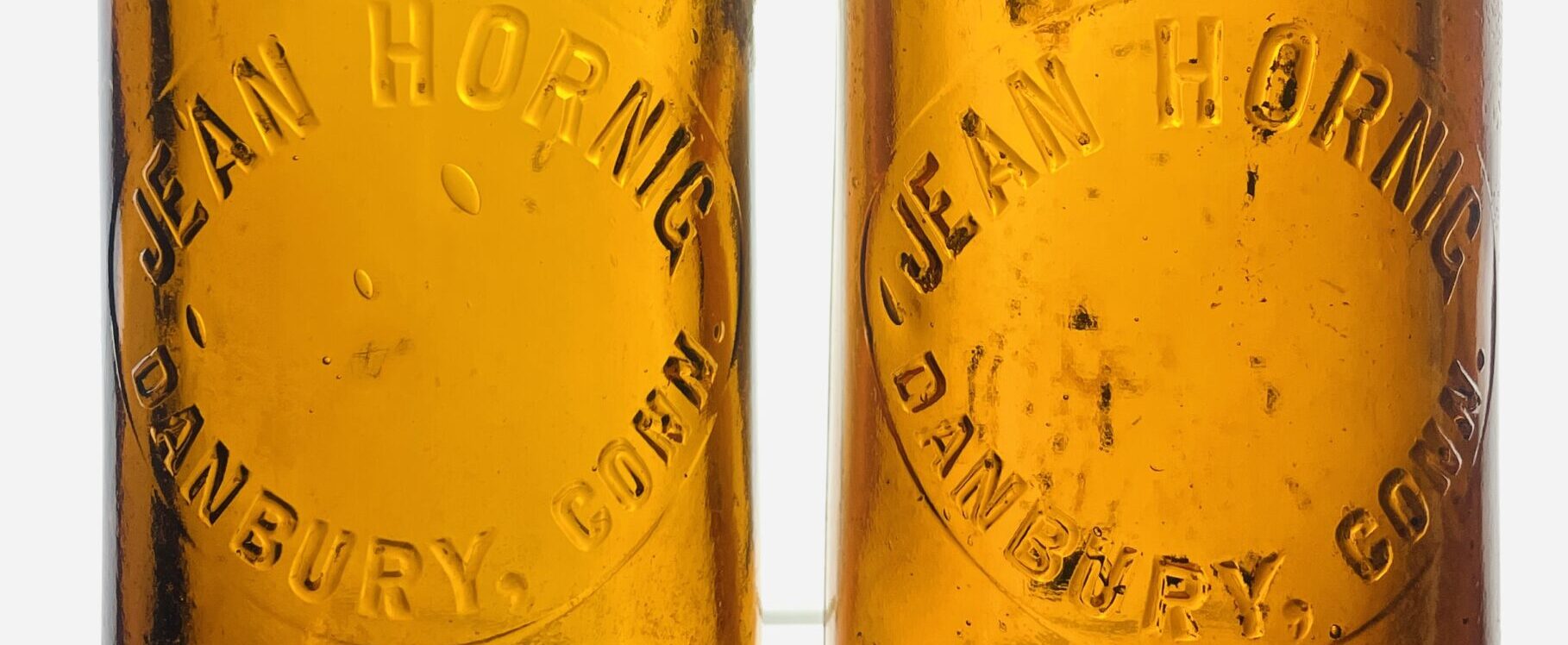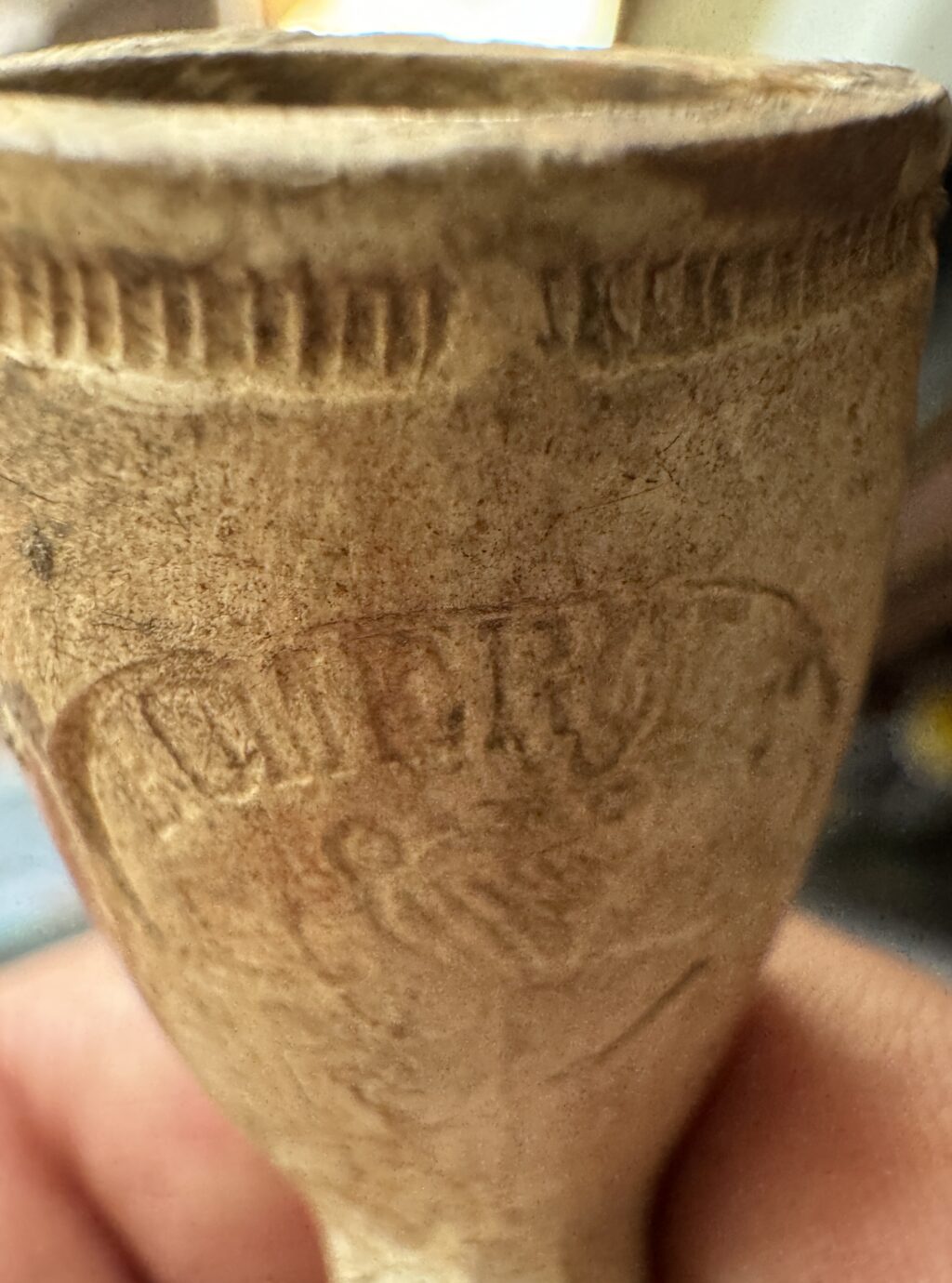
ARTIFACTS- “HOME RUN”
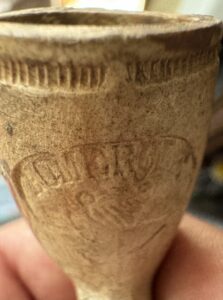
Special to hatcitydiggers.com
By Dan Gaughan
Unearthing Danbury’s Past: The Tale of a Homerule Pipe
Danbury, CT, May 30, 2024 — Beneath an old dump in Danbury, a small clay pipe with “Home Rule” inscribed on its side has been discovered. This modest artifact, dating back to the 1910s, offers a profound glimpse into the past, revealing a rich tapestry of immigration, labor struggles, and the quest for justice and equality that shaped this New England town.
The inscribed pipe embodies the spirit of the Irish Home Rule movement, a campaign led by Charles Stewart Parnell and Isaac Butt for Ireland’s self-governance within the United Kingdom. For Irish immigrants in America, this pipe symbolized their unyielding spirit and their hopes for a free Ireland.
The Influence of the Irish Home Rule Movement
Irish Nationalism in Danbury
The inscription “Home Rule” on the clay pipe directly ties it to the Irish Home Rule movement, which campaigned for Ireland’s self-governance within the United Kingdom. These pipes were not just everyday smoking instruments but were deliberately manufactured and distributed to promote the political message of the Home Rule movement. At the time, smoking pipes were immensely popular among men, making them an ideal vehicle for spreading political messages.
The pipes were often made in bulk by manufacturers sympathetic to the cause or commissioned by political organizations. They would then be distributed at rallies, meetings, and social gatherings. The act of smoking a pipe inscribed with “Home Rule” became a subtle yet powerful statement of solidarity and political stance. It allowed supporters of the movement to signal their allegiance in a commonplace activity, fostering a sense of community and shared purpose.
The presence of this clay relic in Danbury indicates that Irish immigrants in the area were supporters of the Home Rule movement and actively engaged in promoting its ideals. The wide use of such pipes helped reinforce the message of self-governance and justice, resonating deeply with a community striving for both political and social rights.
Labor Movements and Home Rule Influence
- H. Moore, an Irish immigrant and labor leader in Danbury, played a significant role in organizing hatters and advocating for better working conditions. Historical records from that period reflect his inspiration from the Home Rule movement.
In an interview with The Danbury News on March 10, 1902, Moore said, “Our fight for fair wages and conditions is much like our fight for Home Rule back in Ireland. We seek self-determination and justice in the workplace, just as we do for our homeland.” This sentiment was echoed in his speech reported by The Danbury Evening Sentinel on April 5, 1902, where he stated, “The principles of Home Rule guide us in our struggle here in Danbury. We are determined to achieve the same sense of justice and fairness that we desire for Ireland.”
Social Justice and Cultural Advocacy
The Irish community’s support for abolitionism in Danbury is partially rooted in their own experiences of oppression and their political education through the Home Rule movement. The Danbury Evening News wrote on July 15, 1860, “The visit of Frederick Douglass to Danbury was met with strong support from the Irish community, who have often drawn parallels between their struggle for Home Rule and the fight against slavery.”
The Ancient Order of Hibernians promoted Irish culture and political causes, including support for the Home Rule movement. Members of this organization in Danbury were active in local labor and social justice movements. As reported by The Danbury Evening Sentinel on October 20, 1901, “The Ancient Order of Hibernians continues to be a strong advocate for both Irish nationalism and local labor rights, often citing the Home Rule movement as a guiding principle in their endeavors.”
The discovery of this inscribed pipe in Danbury serves as a tangible link to the broader historical currents influenced by the Irish Home Rule movement. From labor rights to social justice, the principles of Irish nationalism significantly shaped the actions of key figures in Danbury’s history. This discovery invites us to reflect on our shared history and the enduring spirit of those who came before us.
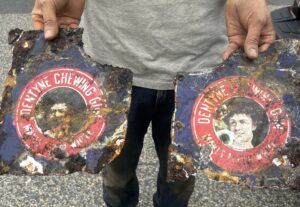
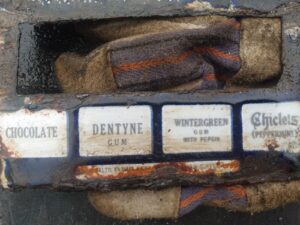

Right now we are in the process of recovering a penny candy machine. Pictured above are several of its parts. Visible on two of the porcelain panels are images of the iconic Gibson girl, a feminine ideal made famous by illustrator Charles Dana Gibson in the 19th and early 20th centuries. The ideal was sensationalized during the murder trial of Stanford White when murder defendant Harry Thaw’s wife, Evelyn Nesbit’s likeness was printed in papers across the country.
 Pictured Evelyn Nesbit
Pictured Evelyn Nesbit
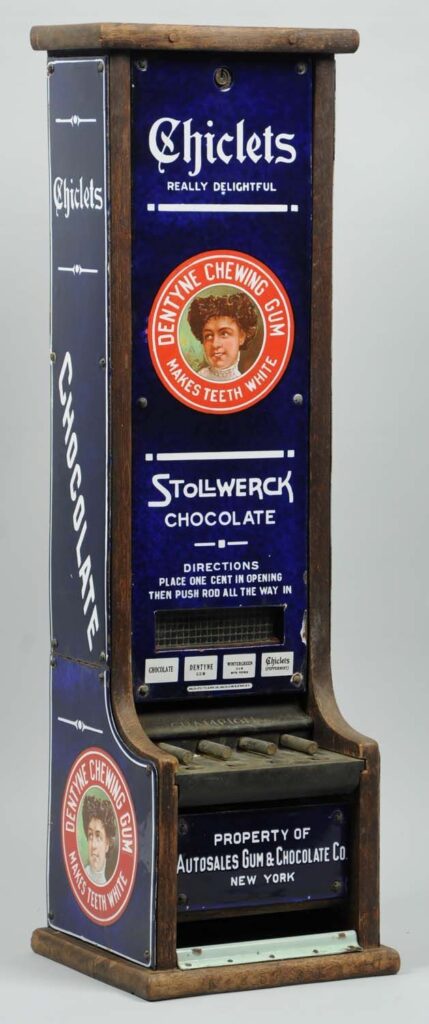
Penny candy machine
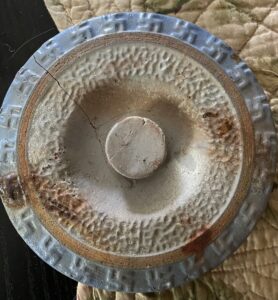
Before the Nazi horrors of the Second World War swastikas like the ones pictured on this crock lid were considered good luck symbols. Lids like this one are still highly collectable, however, and depending on condition can be worth quiet a few dollars to the right person.
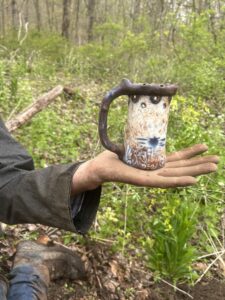
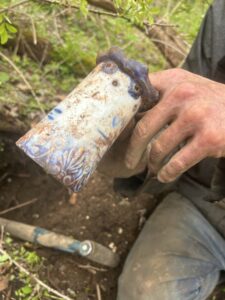
One of this spring’s finds comes from a Danbury dump. Pictured above is an antique German puzzle mug. Along the top of the mug is a series of holes. By closing off a hole a person can stop the liquid from pouring out. The trick is finding the right hole.

Propelled by the surfing craze of the 1960s skateboards like CB radios became a phenomenon in the 1970s. Although my brother and I couldn’t afford the best boards, our desires to ride the table flat sidewalks of phoenix Az were easily fulfilled with cheaper models like the Sizzler board I found in the Still River today. The Sizzler was probably sent to Davy Jones locker because the right front wheel broke off the skateboard truck. Sizzler was made by Mattel toys famous for Hot Wheels cars.
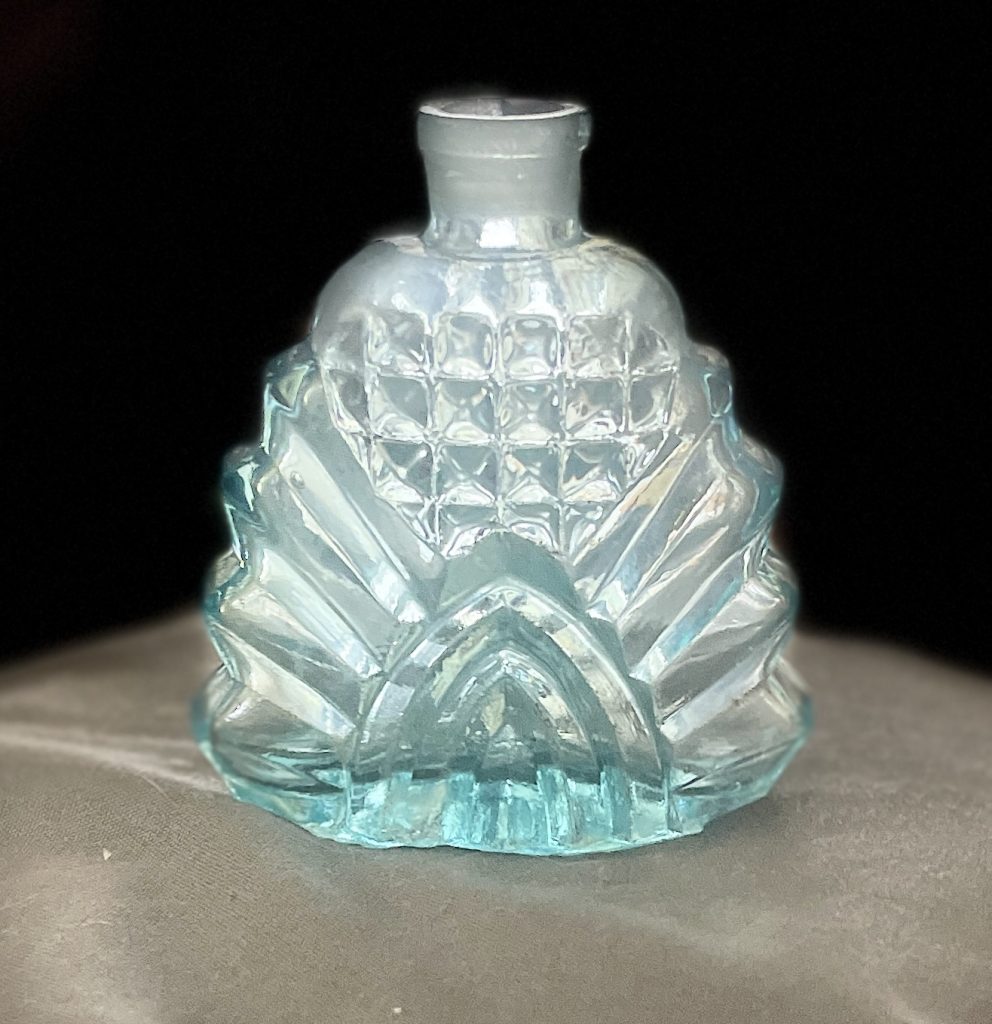
After WWII, an assortment of export items from Japan were labeled “Made in occupied Japan”. This practice lasted until 1952. The delicate blue bottle (above) was made during this time frame and probably contained perfume that was sold at five and ten cent stores , such as, Woolworth’s in Danbury.
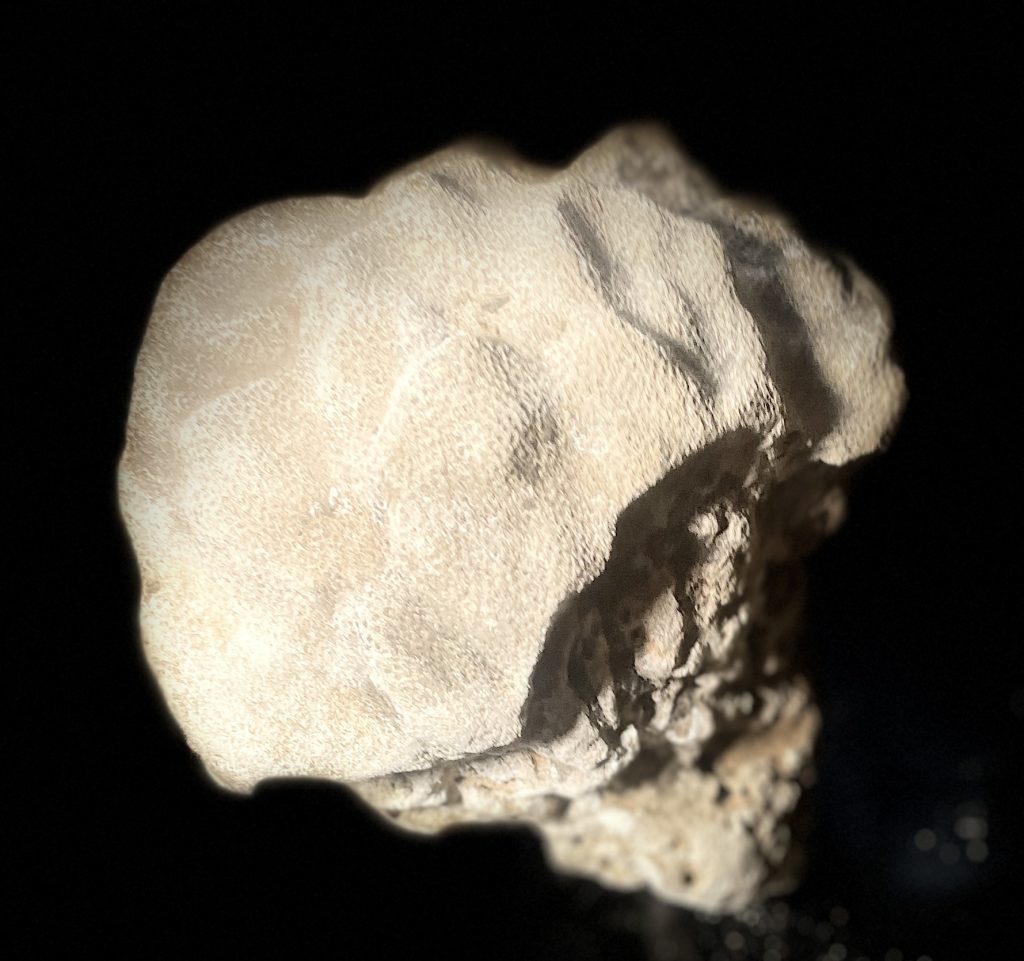
Another fossil find, this time from Bethel. We are not sure what this is it could be a piece of coral. When we get the chance we’ll have an expert look at it. For now it will remain a mystery find.

The Danbury area is not noted for its fossils but once in a blue moon you’ll find one like this hunk of coral I found in back of the fire station. It may be what is commonly call brain coral.
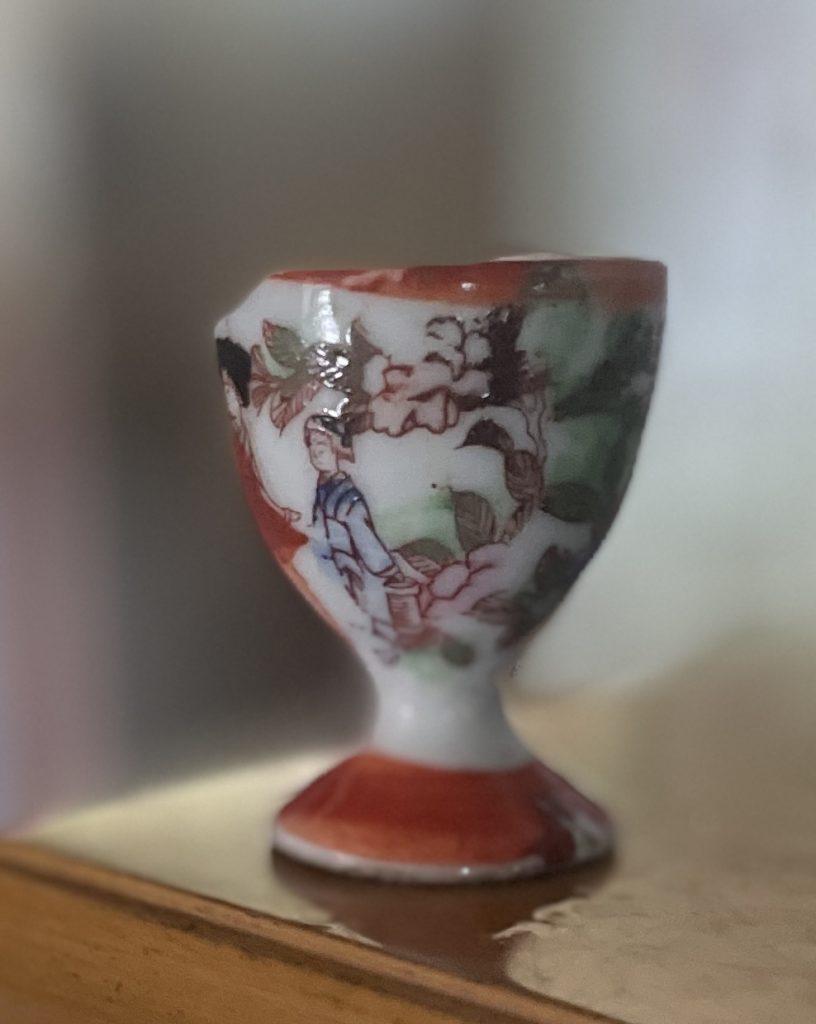
Cherry trees and Geishas paint a garden scene on this decorative egg cup from the 1930s. Cheap porcelain like this may have been given away at movie theaters as a way of bringing in costumers.
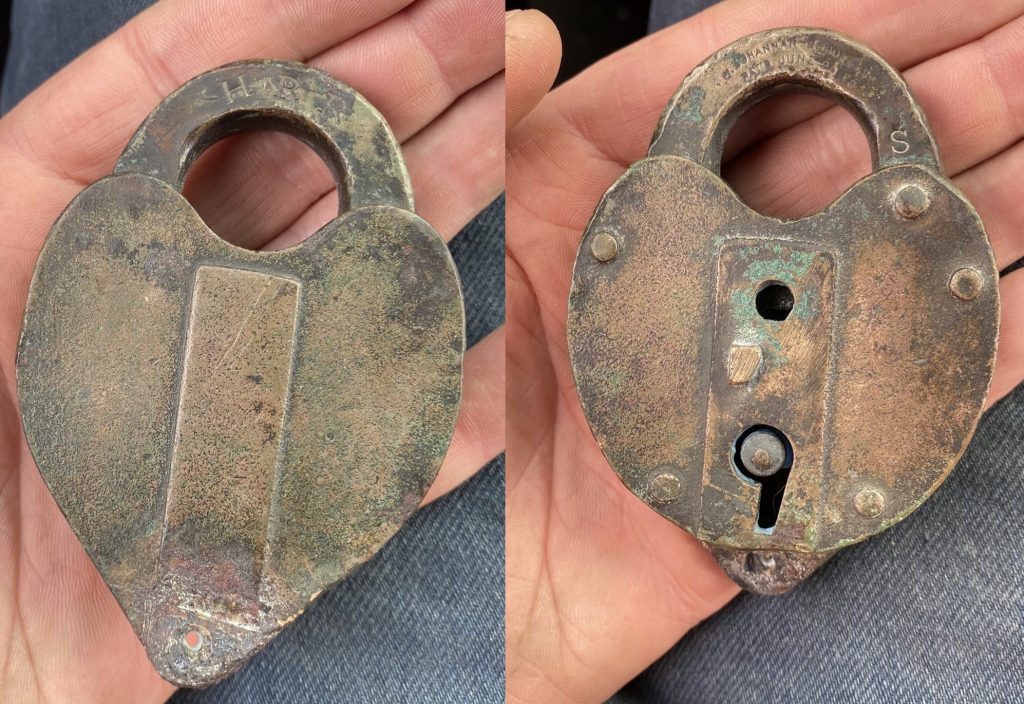
![]() HRR LOCK
HRR LOCK
I once heard it said: “Never rob a bank in Danbury- too many railroad crossings.” The case was the same 120 years ago when this lock was being used. This story is not about bank robbers, however. As the picture demonstrates, this piece for hatcitydiggers.com is about railroad locks. We recovered the lock above from a dump we’ve been digging for years. The lock is inscribed HRR (Housatonic Railroad) The Housatonic was a line that passed through Danbury. The letter “S” inscribed on the lock stands for switch. This particular lock may be a rare variant. Railroad locks are every collectable and can sell for hundreds of dollars. The value of this lock in unknown.
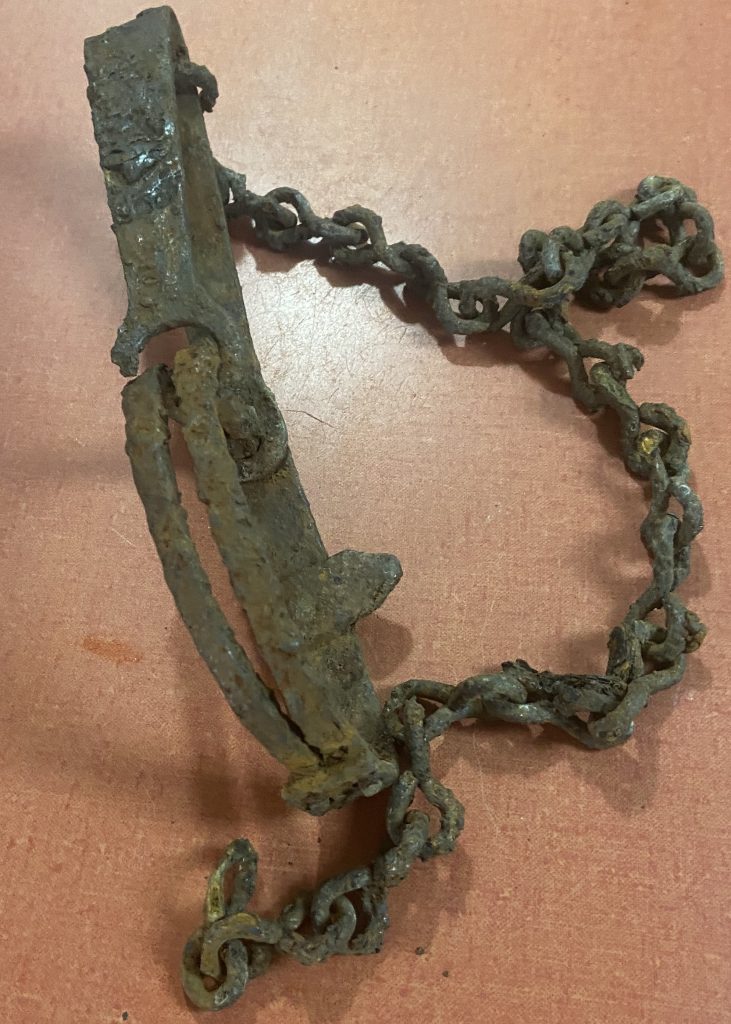
![]() GRIM GIN
GRIM GIN
Seen by many as a cruel device of the past leg hold traps or gins as they are called can still be purchased at Cabelas’ and other online sites. The plate on the trap pictured is missing it may have contained manufacturing information such as patent dates. Nevertheless, we unearthed this small muskrat or rabbit gin from a 1930s trash dump so it dates from that era or before, possible the 1910s. Ω
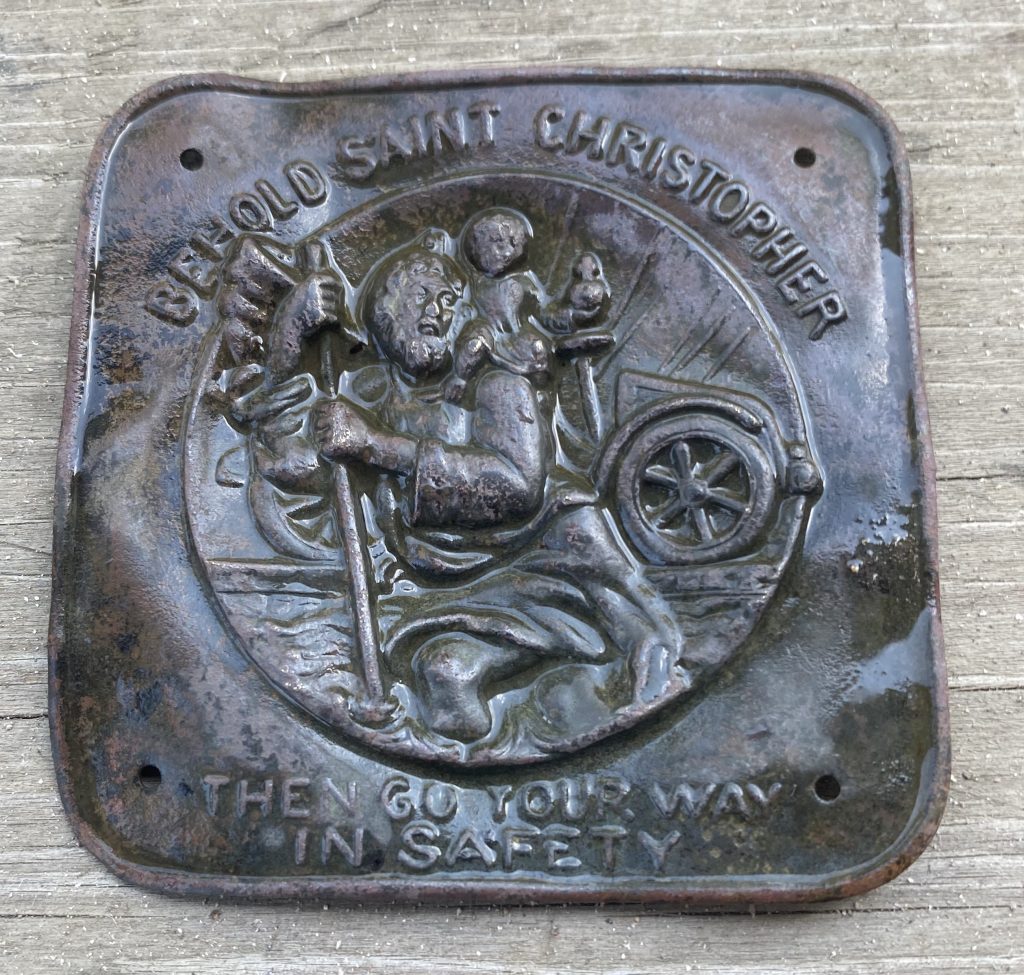
![]() BEHOLD ST. CHRISTOPHER
BEHOLD ST. CHRISTOPHER
This Saint Christopher tag was attached to an automobile at some point (probably the license plate). It may be 80 or 90 years old. Ω
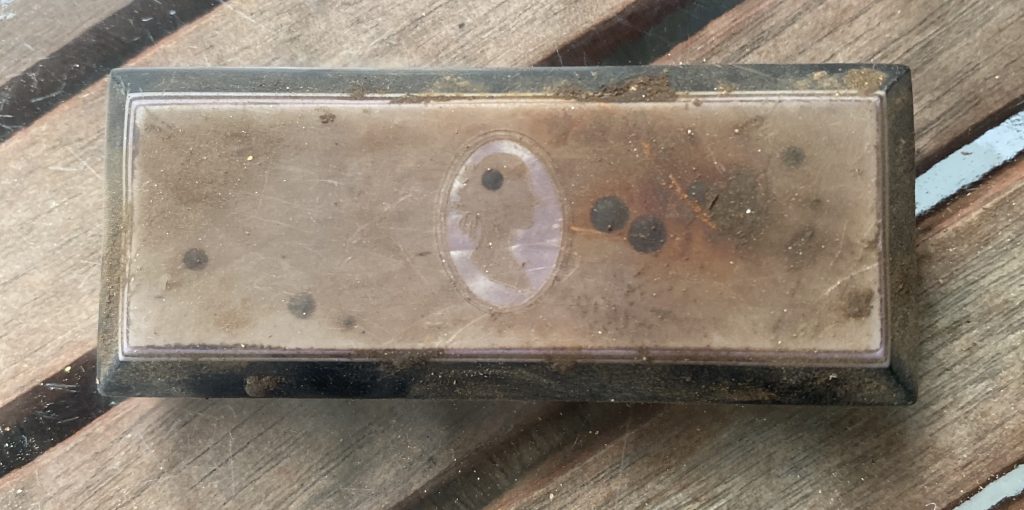
![]() ANTIQUE BRUSH
ANTIQUE BRUSH
According to an internet source, the brush above is a garment brush. It’s made of black material (possible celluloid or vulcanite0 and has mother of pearl inlay. Dating is difficult but likely turn of the century. (Found in Danbury)

![]() ARTIFACT BAFFLES DIGGERS
ARTIFACT BAFFLES DIGGERS
Hat City Diggers found an artifact so mystifying we never thought in a million years we would figure out what it is but out of left field came the answer from an unexpected source: a big game hunter and grade school classmate.
When we posted a picture of the mysterious artifact, above, on Facebook, it was called everything from a canon site to a cobbler’s tool but it was a guy who we haven’t seen in 40 years who cracked the case so to speak. In his spare time, Matt Hammond of Phoenix Az. spends his time in the wilds of his home state hunting or across the world hunting in Africa. When he’s not out in nature he’s making a living doing what he’s done for 30 years- working in the dental industry “I’ve owned a dental lab for 30 years,” he says. “Damn that makes me sound old!” When Matt saw the object on Facebook he knew what it was right away. “It’s an articulator for dental lab work. It’s what you mount stone casts of teeth too to fabricate dental prosthetics. Hinge simulates the jaw movements,” Matt says. What a dental articulator was doing in a trash dump with an ice skate and safety razor is anyone’s guess. What we do know is this dump has been full of surprises and we expect more.
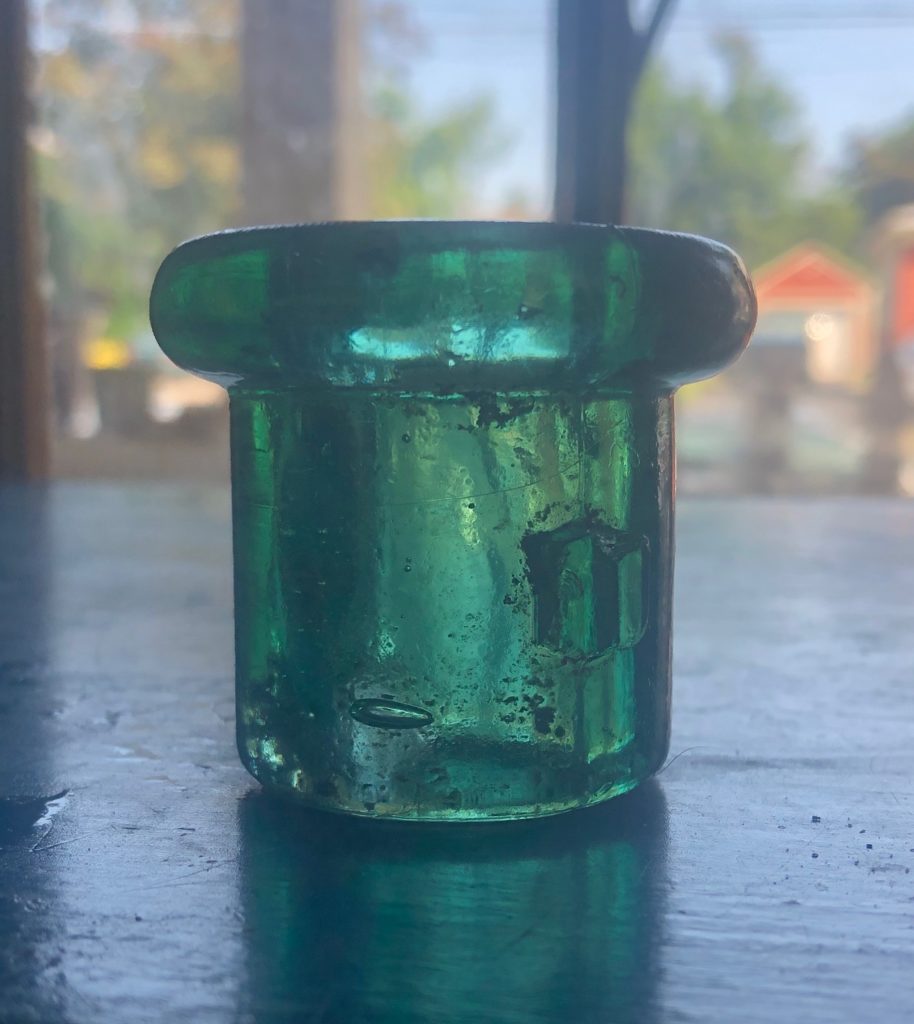
![]() FORTH OF JULY FIND
FORTH OF JULY FIND
Summer lightning in New England can be both awe-inspiring and quite destructive. So for years, people have protected structures with lightning rods. Nineteenth-century lightning rods used glass insulators like the one above. It is now our fourth year at our secret Danbury dump and it is still producing finds. And what is more, appropriate to find on the fourth of July than a lightning rod insulator. This is the second lightning rod insulator we’ve found at the dump.
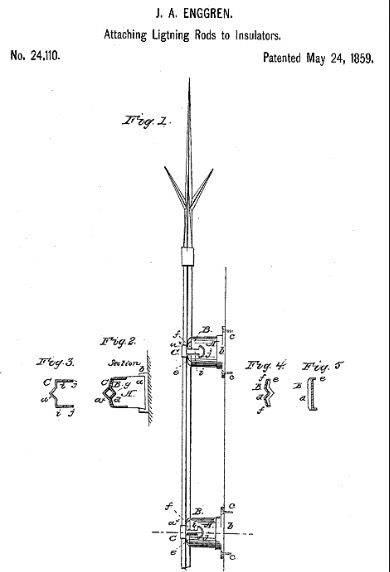
The diagram above shows the placement of glass lightning rod insulators, similar to ours, on the lightning rod. When lightning strikes the rod a wire channels the electricity harmlessly into the ground.
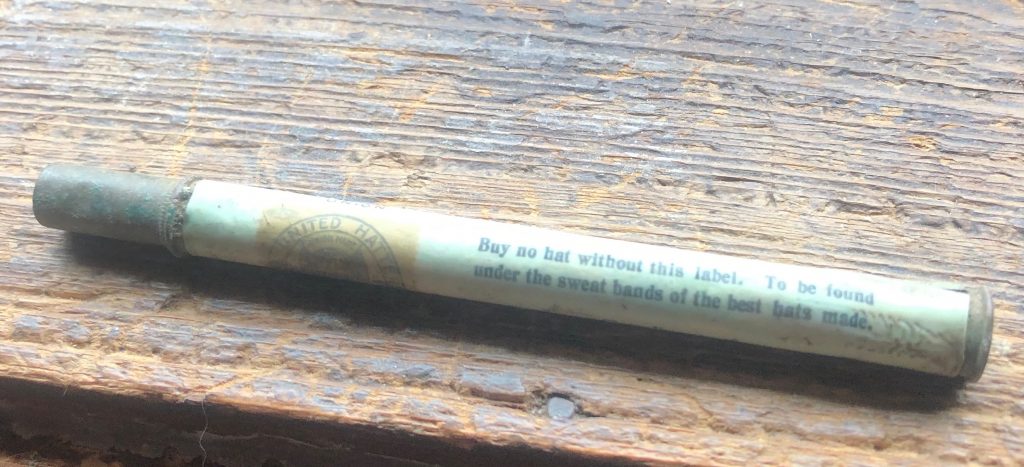
![]() FOUND: UNKNOWN OBJECT.
FOUND: UNKNOWN OBJECT.
We found a new artifact with a Danbury connection but it’s going straight into our “What the Hell is This” file. The item clearly has a hatting /union relationship. Danbury was arguably the biggest hatting city in the country and at the turn of the century, unions were trying to organize hatters in Danbury. (the artifact was unearthed in Danbury). That said: “what the hell is it?” We’ve gotten many ideas trying to answer this question from a mechanical pencil to a cigarette holder but we still do not have a definitive answer. Maybe you can help? Drop us an email with your explanation.
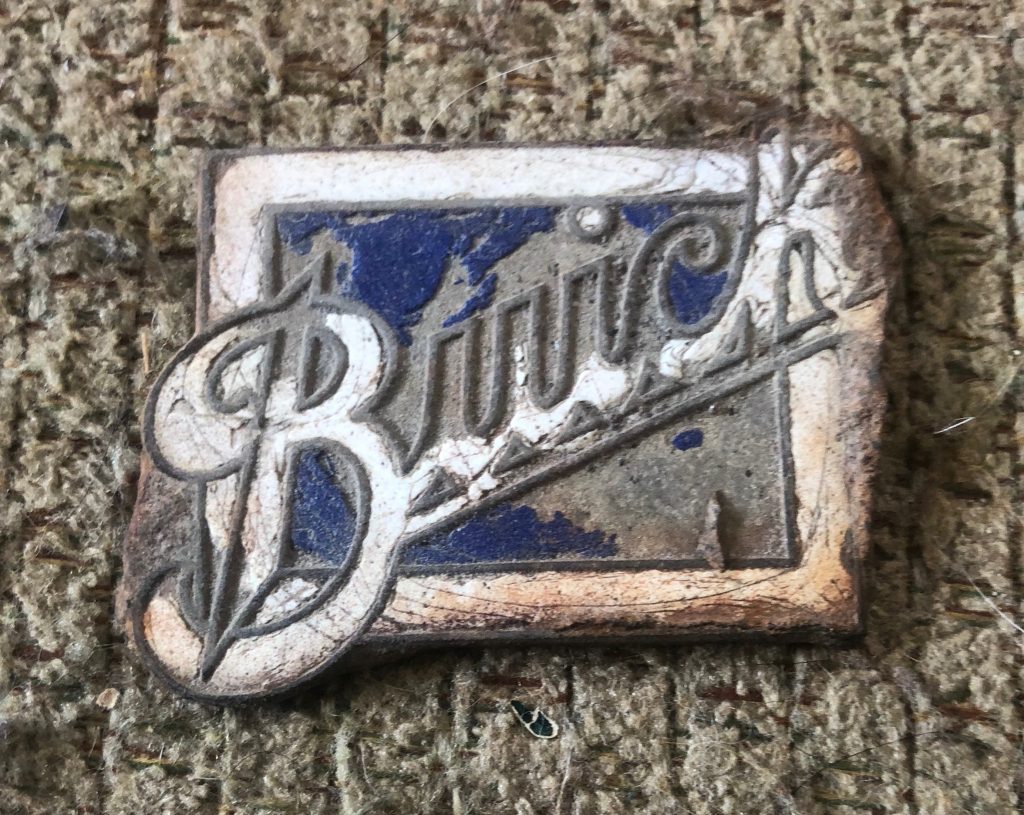
![]() AUTO ARTIFACT
AUTO ARTIFACT
Not only do we find license plates in the water but also pieces of cars. This old Buick porcelain emblem is showing its age after being in the water for years. Cars were routinely dumped in the Still River and creeks that course through Danbury. This emblem is ca. 1920.
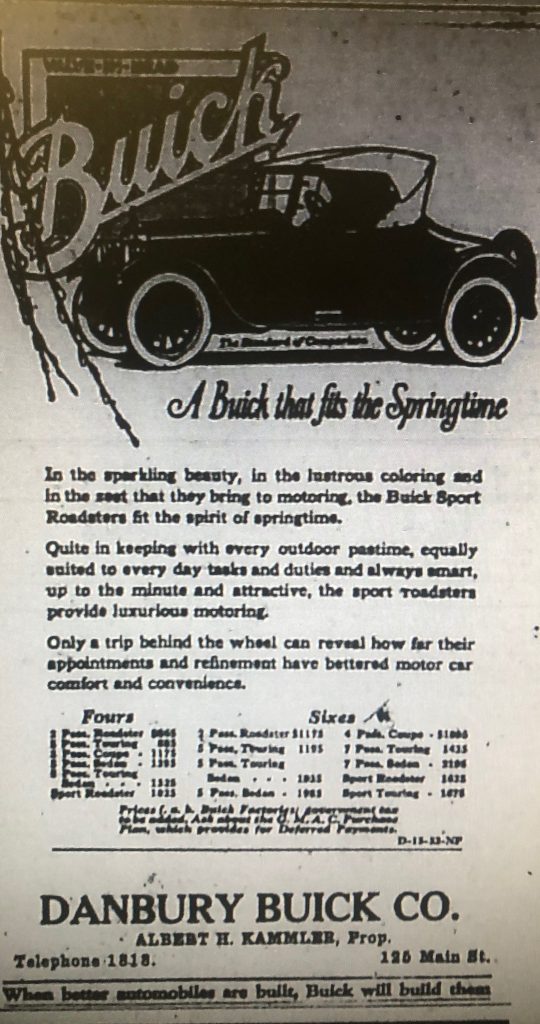
From the Danbury News 1923. The emblem above likely came from a Buick bought at Albert Kammler’s Buick in Danbury. Note the prices of cars.

![]() FIRST BLUD
FIRST BLUD
Common, depending on condition, value $5 to $10
Rivers, streams and brooks can contain many artifacts from the past, like this Bludwine bottle above. Bludwine started in Georgia in 1906 by Henry C Anderson who sold it in many states including Connecticut. Bartley and Clancy were Bludwine agents. They were also two of Danbury’s best-known bottlers. We are not sure how popular Bludwine, which was cherry flavored, was in Danbury but in eight years of digging, we have only found two of the hobble skirt bottles. Bludwine was not a patent medicine but in the 1910s its makers marketed it as a health food drink. The bottle above dates to about that time.
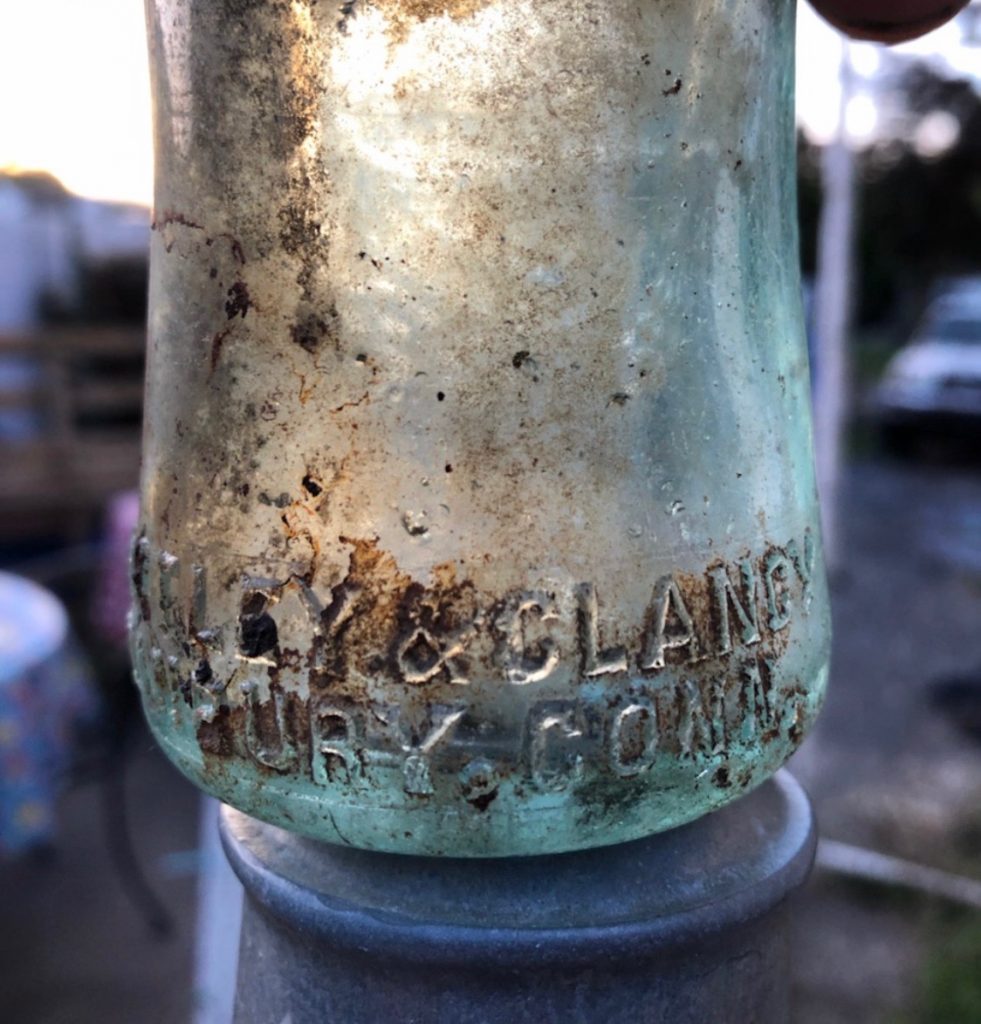
The embossing on the heel of the Bludwine bottle clearly shows Danbury bottlers Bartley and Clancy as agents for the tonic.
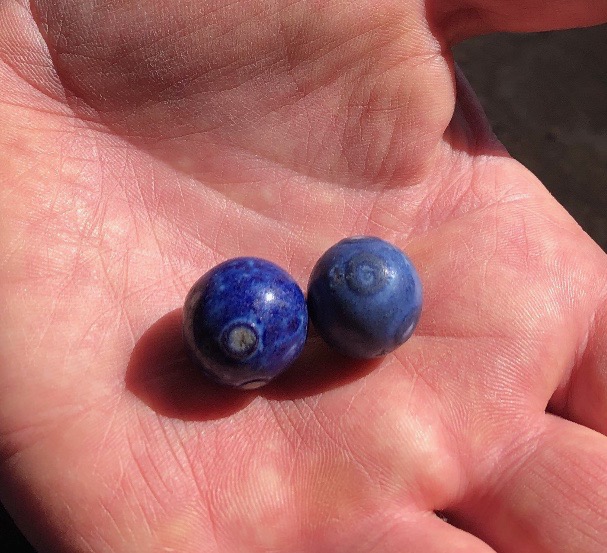
![]() BLUE BENNIES
BLUE BENNIES
Hat City Diggers dug dozens of marbles from dumps over the years but the variety least common to the Danbury area appears to be the so-called Bennington crockery marbles. Benningtons derive their name from Bennington VT because these marbles, according to Antique Marbles, by Paul Baumann “resemble pottery ware made in Bennington… but [Bennington marbles] were most likely made in Germany.” The knowledge of this style of marbles is quite limited according to Baumann. “[But] we can assume these marbles were made by a variety of factories over a number of years,” Baumann says the three most common Benningtons are blues, browns and fancy Benningtons- browns being the most common. Hat City Diggers owns two salt-glazed blues. Benningtons vary in depth of color according to Paul Baumann. The blue Benningtons may appear mottled darker or lighter blue with some areas of white. Baumann tells us that larger Benningtons are rarer than the “shooting-size marbles “such as the blues pictured.
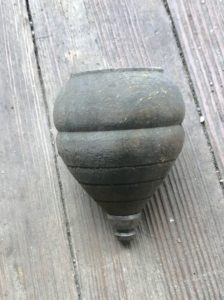
![]() SPIN DOCTOR
SPIN DOCTOR
Tops like this have age to them because newer ones are made of plastic- this one is wood. We can’t be certain of exact age but other artifacts found nearby date from the early 1900s to the war years of the 1940s. We feel this top falls somewhere in between those dates.
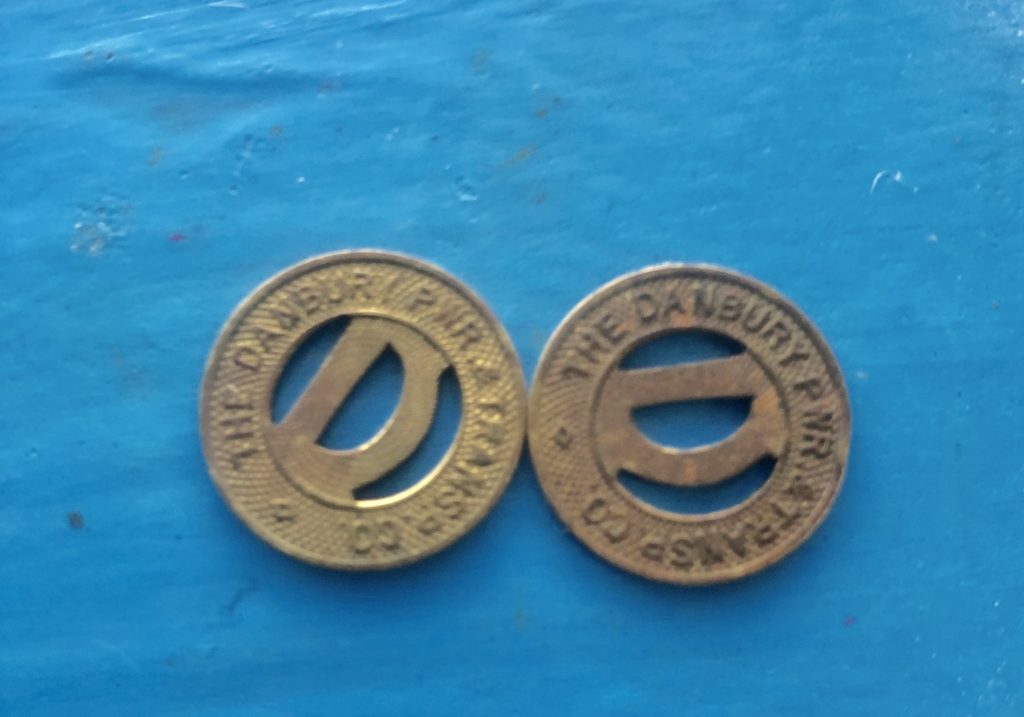
![]() BY THE SAME TOKEN
BY THE SAME TOKEN
City of Danbury bus tokens like these were used in place of coins for years in Danbury. Danbury’s trolleys used similar tokens. According to an addition of Danbury News for July 1926, the age of the trolley in Danbury was coming to an end “It is considered practically certain,” reported the News, “that within a short time and probably as early as sometime during the coming month the street railway service of the Danbury and Bethel Street Railway Co will be… replaced by a modern motor bus… system.” In a later issue, the News reported the system would be up and running in September. The bus system used tokens like the two above until the 1960s.
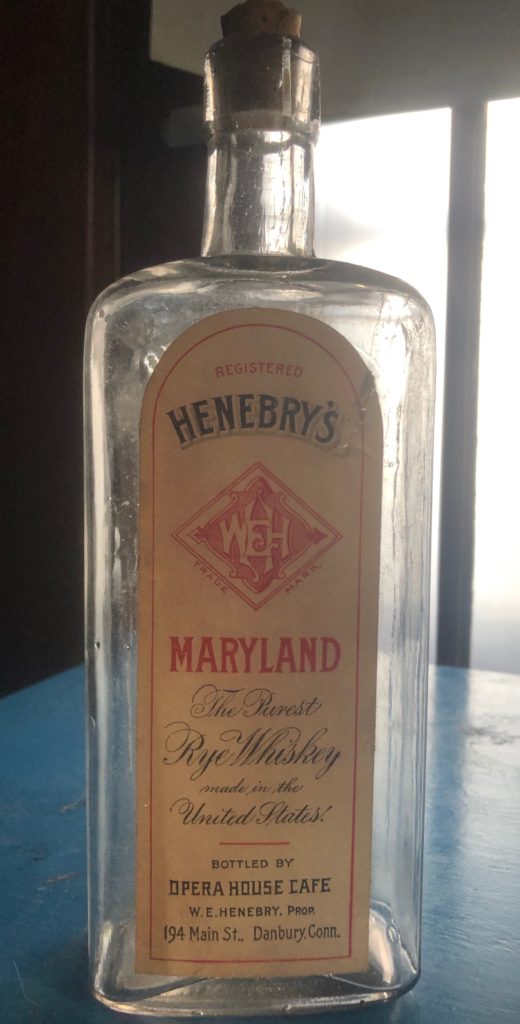
![]() BETHEL CACHE ERASES LONG-HELD BELIEF
BETHEL CACHE ERASES LONG-HELD BELIEF
Hat City Diggers continue to learn more from the Bethel Cache of relics they obtained. This time a long-held belief regarding bottle slug plates and labels was smashed. Along with finding dozens of pieces ephemera a Bethel handyman also found a collection of Henebry “Opera House”Whiskeys like the one pictured above. The bottles are unique because they give the diggers insight into labeling practices of 19th and early 20th-century bottlers. Hat City Diggers find dozens of warranted, registered flasks and blob tops during their digs that are blank. These bottles caused the diggers to accept certain beliefs based on empirical evidence. But Hat City Diggers’ assumption was wrong. Pictured above is the reverse of the unembossed Henebery flask. A blank circler slug plate impression can be clearly seen. “We always thought this blank circle contained a label.” Says one of the diggers. “But the label is clearly on the other side of the bottle.” The blank plate impression is part of the bottle mold. letters could be added to this section of the mold for an additional fee. If nothing was added the plate impression would come out blank after the bottle blowing process was completed. “It was never for a label.” Says the diggers. William Henebry was an early 20th-century bottler who owned the Opera House Cafe and according to the label, this whiskey was bottled exclusively by the Opera House Cafe. Henebry also owned several saloons in Danbury. For more on Henebry, see “Danbury Bottles.”
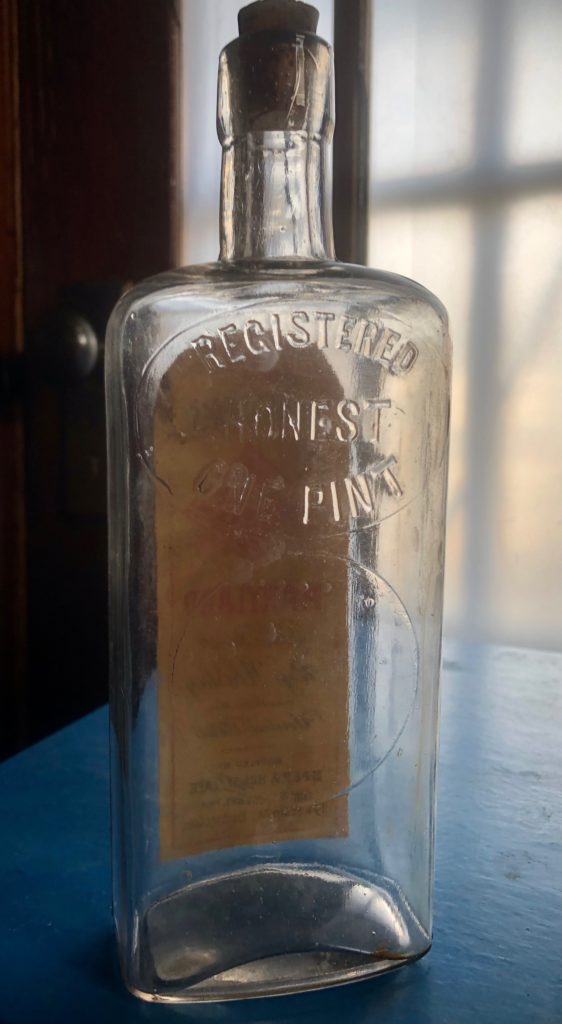
The reverse of the Henebry “Opera House” Whiskey clearly shows the blank slug plate on the bottle.
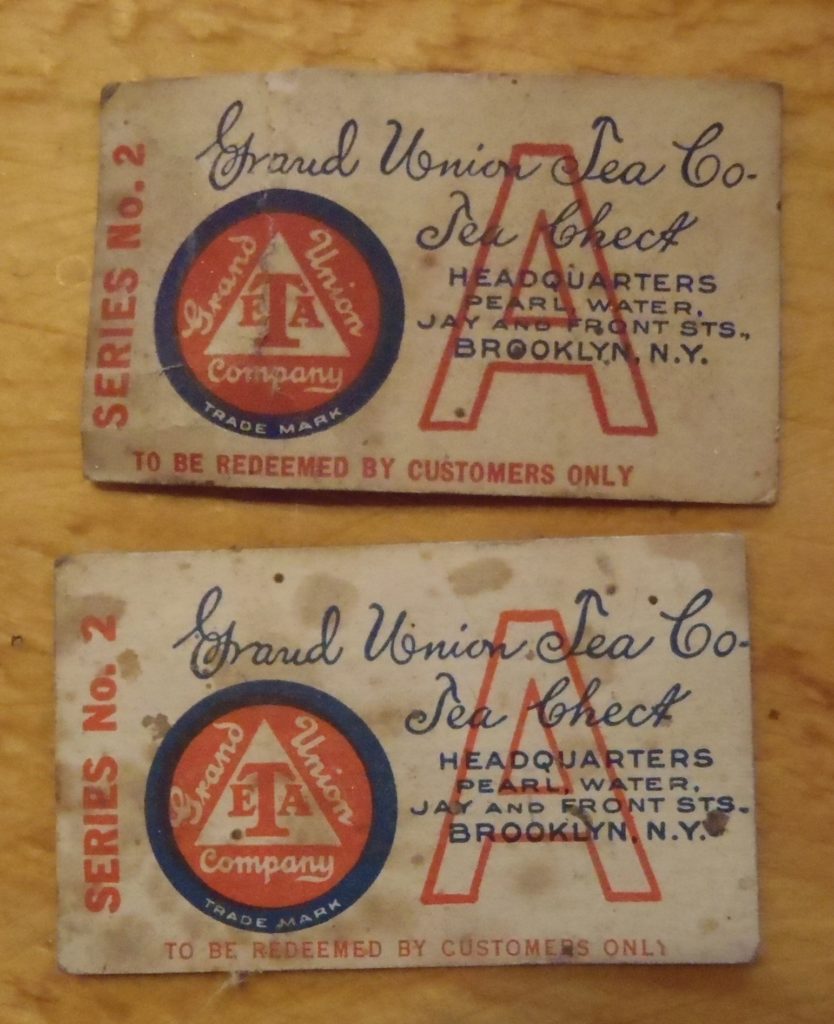
![]() WARTIME COUPONS
WARTIME COUPONS
These Grand Union Tea Check coupons date to the Second World War. They were found along with other relics in the ceiling of a home that is being renovated.
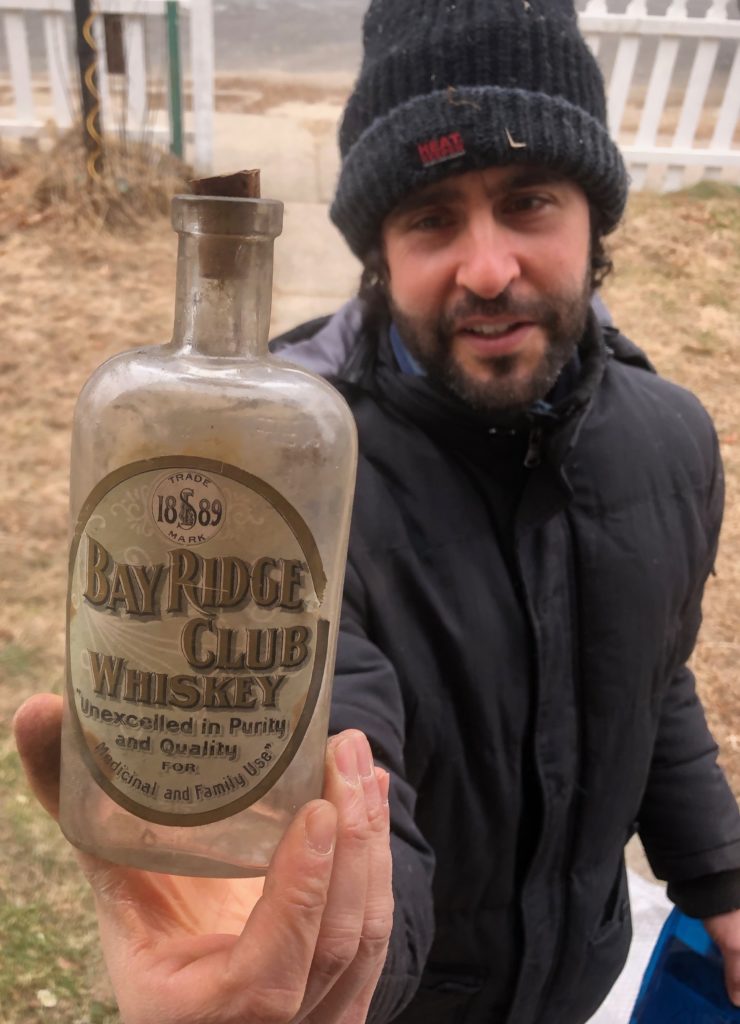
![]() CACHE OF RELICS FOUND IN BETHEL HOME
CACHE OF RELICS FOUND IN BETHEL HOME
A cache of artifacts has been found in a Bethel, Ct home and Hat City Diggers get first dibs. The artifacts including ad papers, bottles, toys and letters date from the 1940s to the turn of the century. A handyman discovered the cache when he was ripping down a ceiling in the home. Hat City Diggers was told that relics just began pouring out of the ceiling. More walls and ceiling have to be removed so there may be other things just waiting to be discovered. Hat City Diggers went through the artifacts and discovered some excellent finds including an ad bill for the Capitol Theater was located on Elm St. in Danbury. There is also a Woodruff and Son ad- a firm once located in Danbury, also. Hat City Diggers have yet to inspect the letters thoroughly but the group reports some of the letters are war-related. The bottles the handyman found consist of at least a dozen rare W. E Henabery whiskey flasks. The cache also contains a J. A. McPhelemy bottle that may also be rare. How the relics came to be in the ceiling is unknown. But according to Hat City Diggers, “The paper could have been added for insulation” The group also has another theory. “There seems to be a propose,” said Hat City Diggers, “The bottles clearly intentional, the letters clearly intentional, it may have been a time capsule” Hat City Diggers will feature these artifacts on this website over the coming weeks.

![]() CLASSICAL GAS
CLASSICAL GAS
Before C L &P, Eversource or Yankee Gas there was the Danbury and Bethel Gas and Electric Light Company. According to Moody’s Manual of Railroads and Corporation Securities, Volume 2, Part 2. The firm opened in 1854 as the Danbury and Bethel Gas Light Co. and supplied gas for lighting in Danbury and Bethel. As Danbury and Bethel began to build an electric power grid, the firm amended its name and in 1887 the firm became The Danbury and Bethel Gas and Electric Light Co. In 1912 The firm supplied gas and electricity to 27,300 people in the Danbury area and had 61 miles of gas lines running through the communities. There were three high-pressure mains caring 45 lbs pressure and according to Poor’s Manual of Public Utilities the “[m]aximum day’s send out [was] 345,600 cubic feet of gas.” Empirical evidence shows gas from the firm went to a home in Bethel. Hat City Diggers recovered the gas light pictured (left) from a dump in the back of this Bethel home. Hat City Diggers also discovered evidence of gaslights in Danbury. – recovering the light (right) from a dump in 2016. Eventually, electricity replaced gaslights for several reasons one being safety.
GASSING UP
During the course of our investigation, Hatcitydiggers.com uncovered a few facts about Danbury’s first utility company. One of the more interesting facts: how was a firm from more than 100 years ago able to produced over 300,000 cubic feet of gas? The answer comes from a 1907 Danbury News story. Danbury and Bethel Gas and Electric Light Company generated gas using a process that consisted of a carburretor superheater and generator. “There are also engines and blowers to furnish the blast for the heating of the gas machines..” reported The Danbury News. The process of gas production starts with a coal fire. Steam is created and passed through to shells “At this stage” reports The Danbury News “the gas which is produced has very little illuminating power and if lit at a burner would make a flickering blue flame.” Carbon is added to it. This is done through the carburretor and superheater. Crude oil is then added by force and the mixture turns to carbon vapor or gas. “This rich vapor is taken up by the gas coming through the generator fire and in passing through the network of fire bricks in the carburretor and superheater” becomes the gas needed to light Bethel and Danbury homes. The process as a whole sounds quite dangerous and explosive. Danbury and Bethel Gas and Electric Light Companies’ gas making plant was located on Pahquique Ave near Danbury’s rail yard. Just a few years ago, Yankee Gas still used the area as a natural gas and propane farm.

Dating to the 1910s copper tags like this were part of gas or electricity meters found throughout Danbury, Bethel and eventually Brookfield, Ct.

Let there be light. The Danbury, Bethel Gas and Electric Light Company brightens the night on Main St in the 1920s.

![]() LAME DUCK
LAME DUCK
Not all the artifacts Hat City Diggers finds are killer-diller. Take this lame porcelain sign we recovered. Not only is it dull the letter E is missing. Better luck next time.

![]() ANTIQUE IPAD
ANTIQUE IPAD
Long before ipads kids used writing slates like the one above to practice their ciphers, spelling and grammar. Hat City Diggers recovered this antique writing slate from an ash dump in northwestern Ct. Slates were essential equipment for 19th and early 20th-century students.
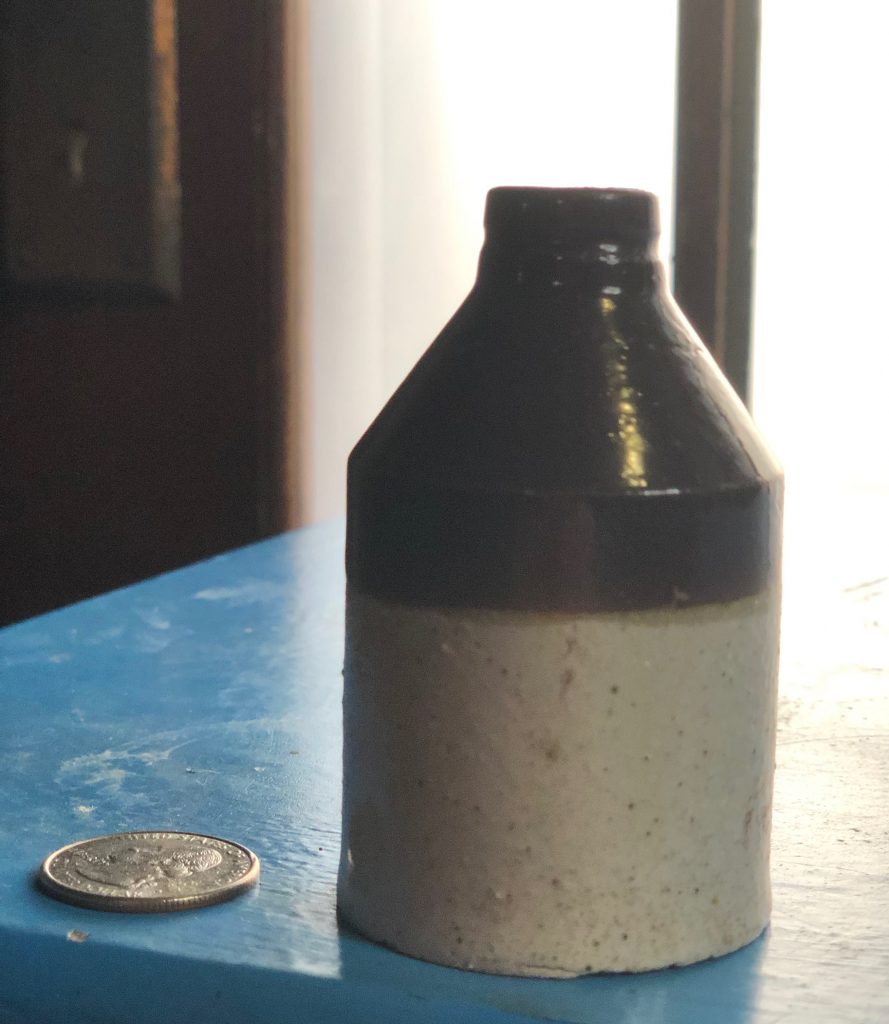
![]() QUICKSILVER MESSENGER
QUICKSILVER MESSENGER
Although it doesn’t say “mercury” this small jug likely contained the only metallic element that is liquid. Unlike the jug (pictured) Hat City Diggers found dozens of jugs this size for sale on the internet that were stamped “mercury”.
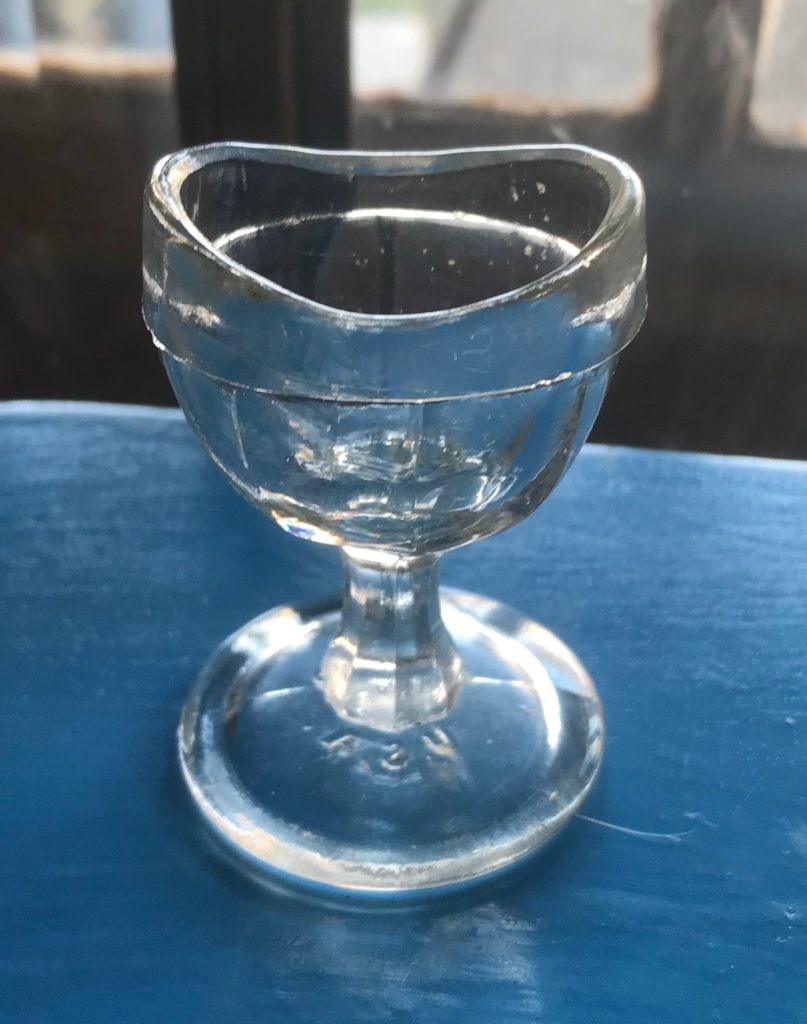
![]() EYES HAVE IT
EYES HAVE IT
Although we found this Whitehall and Tatum eyewash cup in a 1940s and 50s dump, it may be older, since it doesn’t appear machine-made.
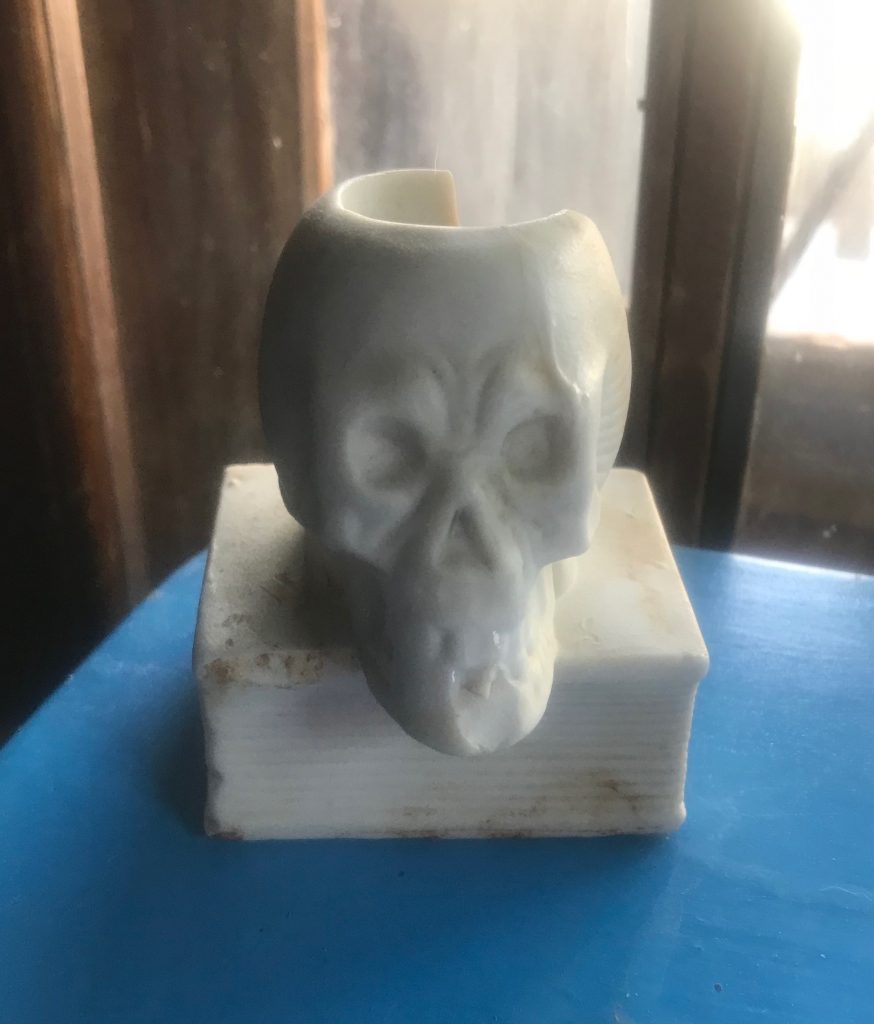
![]() SKULL ON BOOK MATCH HOLDER Ca 1934
SKULL ON BOOK MATCH HOLDER Ca 1934
Looking like something out of an Edgar Allen Poe story this skull match holder makes a great Halloween decoration. We believe the homeowner discarded the holder because of the damage (top right).
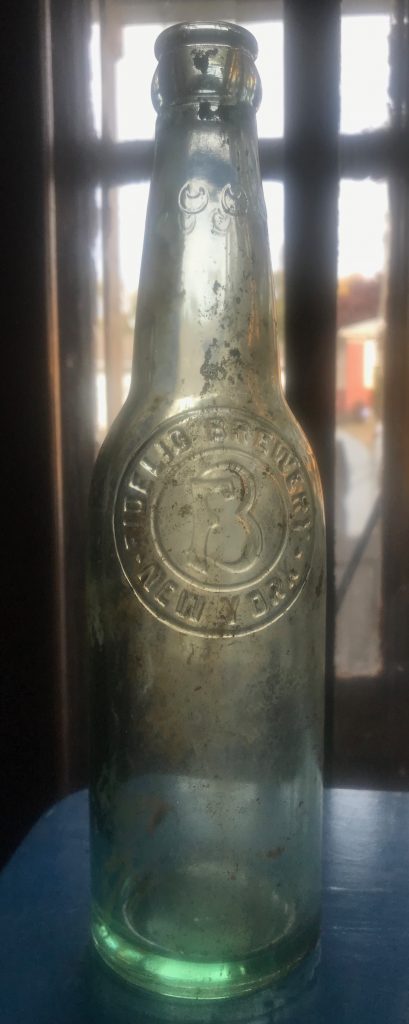
![]() FROM THE SADIE EVANS’ DUMP
FROM THE SADIE EVANS’ DUMP
We don’t think Sadie Evans was a beer drinker but this late 1910s beer from Fidelio Brewery New York tells us someone was. Recovered from Sadie’s property last year it’s one of only a handful of artifacts worth keeping. According to 1940 Census records, Sadie, age 63 was born about 1877. She lived in Ridgefield, Ct with her husband Albert, age 71. Sadie died in May 1959. Although the story of Sadie’s life is still a mystery, a longtime Ridgefield resident told HatCityDiggers.com that Sadie’s home was destroyed by fire and Sadie may have died in the fire. Although little is known about Sadie Evans even less is known about Fidelio Brewery other than the brewery’s location. Sadie’s property remains undeveloped.
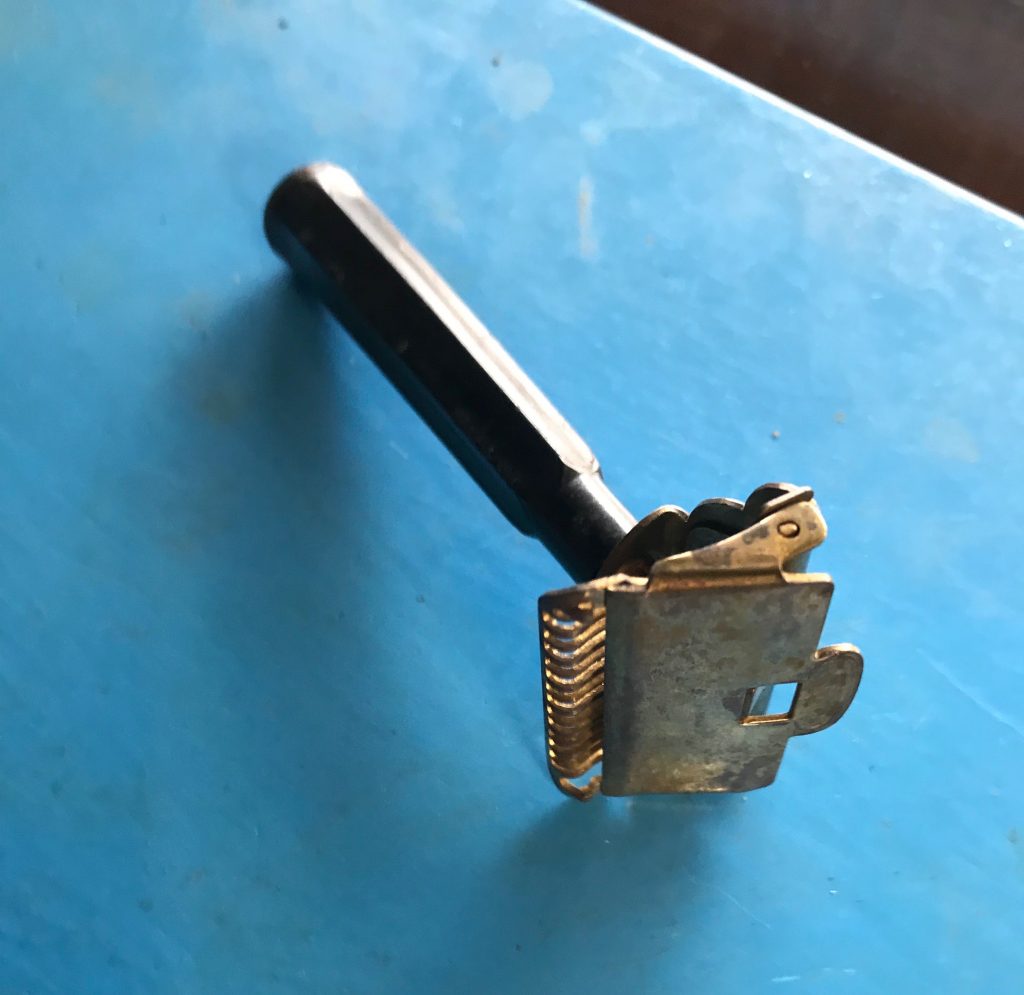
![]() DARE USE IT?
DARE USE IT?
This vintage Gem Junior razor we dug from a trash pit came out in working condition! However, do we dare use it? Dating razors such as this is a tricky business seen this could be a late throw. The trash pit we pulled it from had areas of trash varying from 1800s threadless insulators and patent medicines to 1940s and 1950s Clorox bottles and toy Roy Rodgers saddlebags. Ultimately more research is needed to date the razor. As for shaving? The question is academic. Without a doubt, we’d have no trouble shaving with a razor of this quality But do we dare?
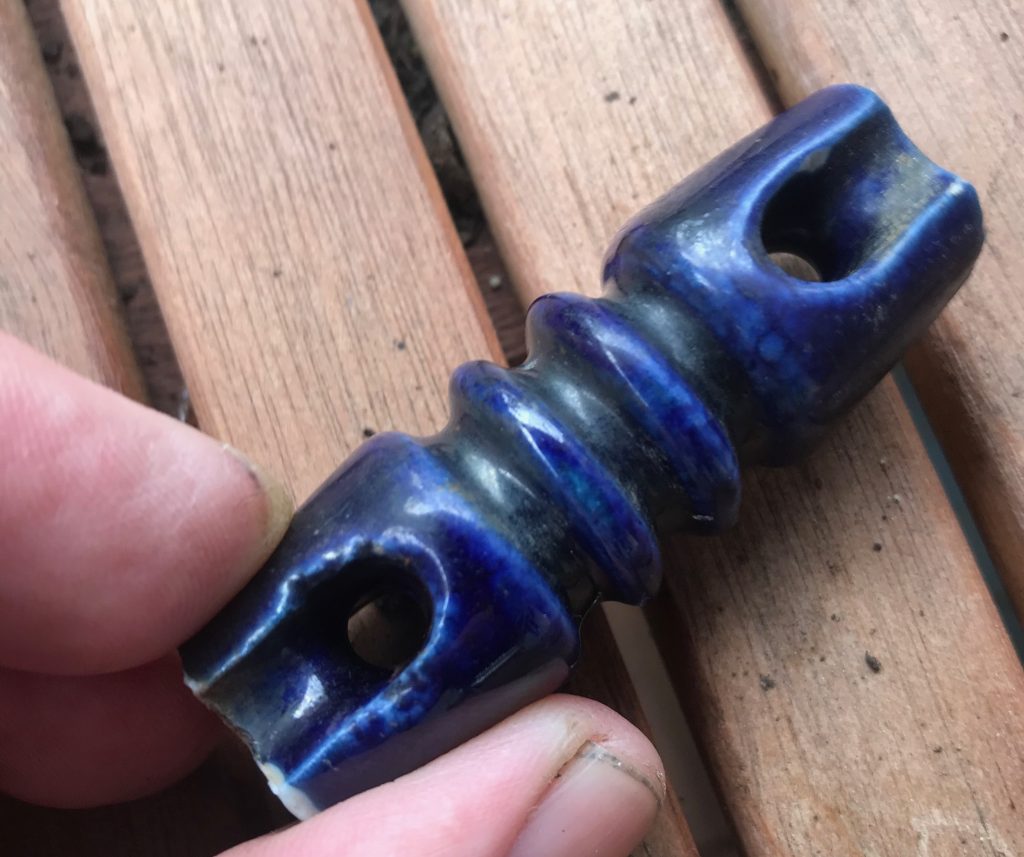
RADIO GA GA
Hat City Diggers recovered this cobalt blue radio insulator from a dump we are digging in New York State.

![]() FOSSILIZED
FOSSILIZED
Hat City Diggers found these fossils today (September 29, 2018) during our most recent bottle dig in Pawling, NY. A farmer not seeing the significance of the rock – or possibly not caring- used the stone for building a colonial-era stonewall. Brachiopods like these (pictured) lived millions of years ago. Although similar to clams (bivalves) brachiopods and clams are not related. One distinct difference between Brachiopods and Bivalves are the shells. Brachiopod shells are symmetrical Bivalve shells are asymmetrical. It is believed that brachiopods evolved during the Cambrian period about 300 million years ago.
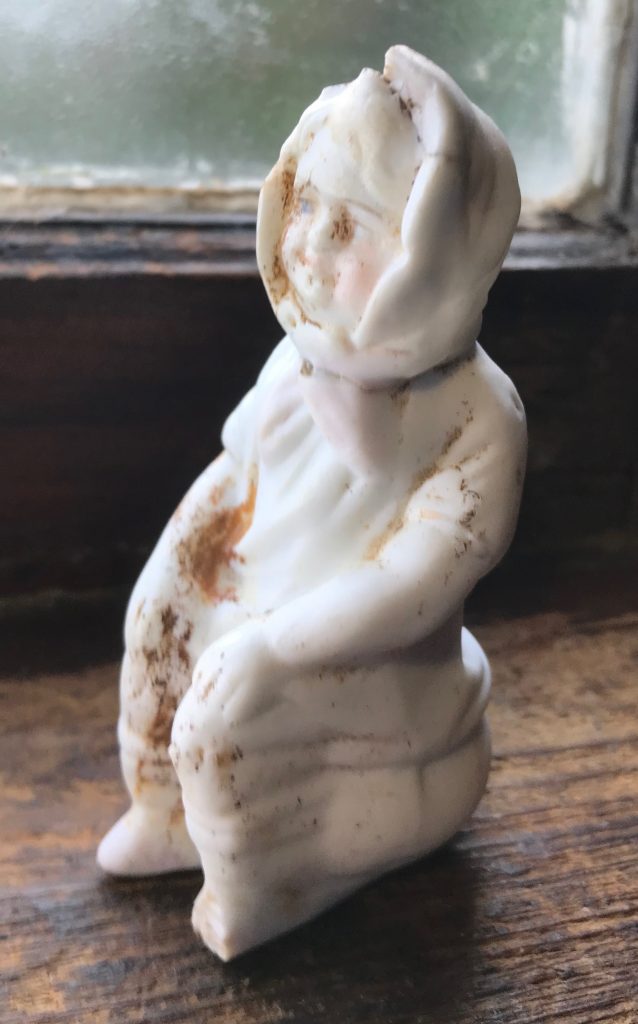
![]() GERMAN “POTTY” TRINKET
GERMAN “POTTY” TRINKET
“Potty” Trinkets like the one above were made in German and exported to the USA but according to Nick Dawes expert appraiser from Heritage Auctions of Dallas Texas, no one knows who made them. Nick reporting from a 2012 episode of Antiques Road Show says “Very few if any would be marked.” However, “most were made in the Dresden area,” according to Nick, and could be bought “as inexpensive objects at state fairs [or] at five and dime stores, [in the USA] and in Germany.” This begs the question: Was this potty trinket purchased at the great Danbury fair? Obviously, we will never know but it was found in a Danbury dump. Ultimately, Nick says “the common denominator that ties [these objects] together is the chamber pot. The chamber pot was an essential part of life.” reports Nick, “It wasn’t a pleasant thing to use so what do you do: You make fun of it.” German “potty” trinkets date to the early 1900s and sell for $25 to $75.
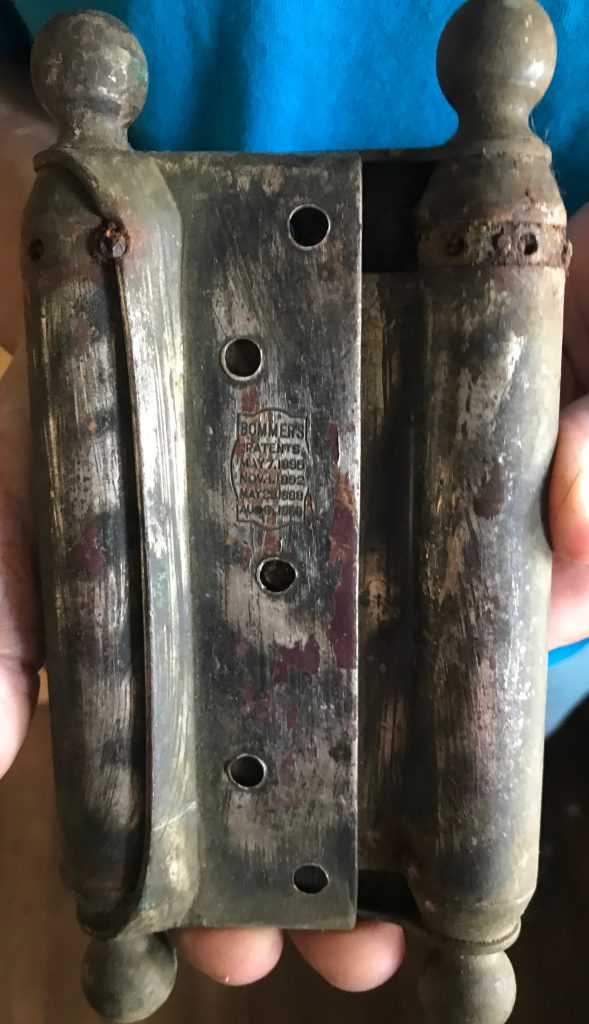
![]() SALOON DOOR HINGES
SALOON DOOR HINGES
In the early 1900s, Danbury had almost as many saloons as it did hat factories. Hatters could be hard-drinking men and with one of the side effects of mercury poisoning being tremors they may have turned to alcohol to alleviate the shaking. Whether the large bass hinges pictured came from the doors of a Danbury saloon is another story, but it is possible. Hat City Diggers recovered these Bommer hinges from a dump last year.
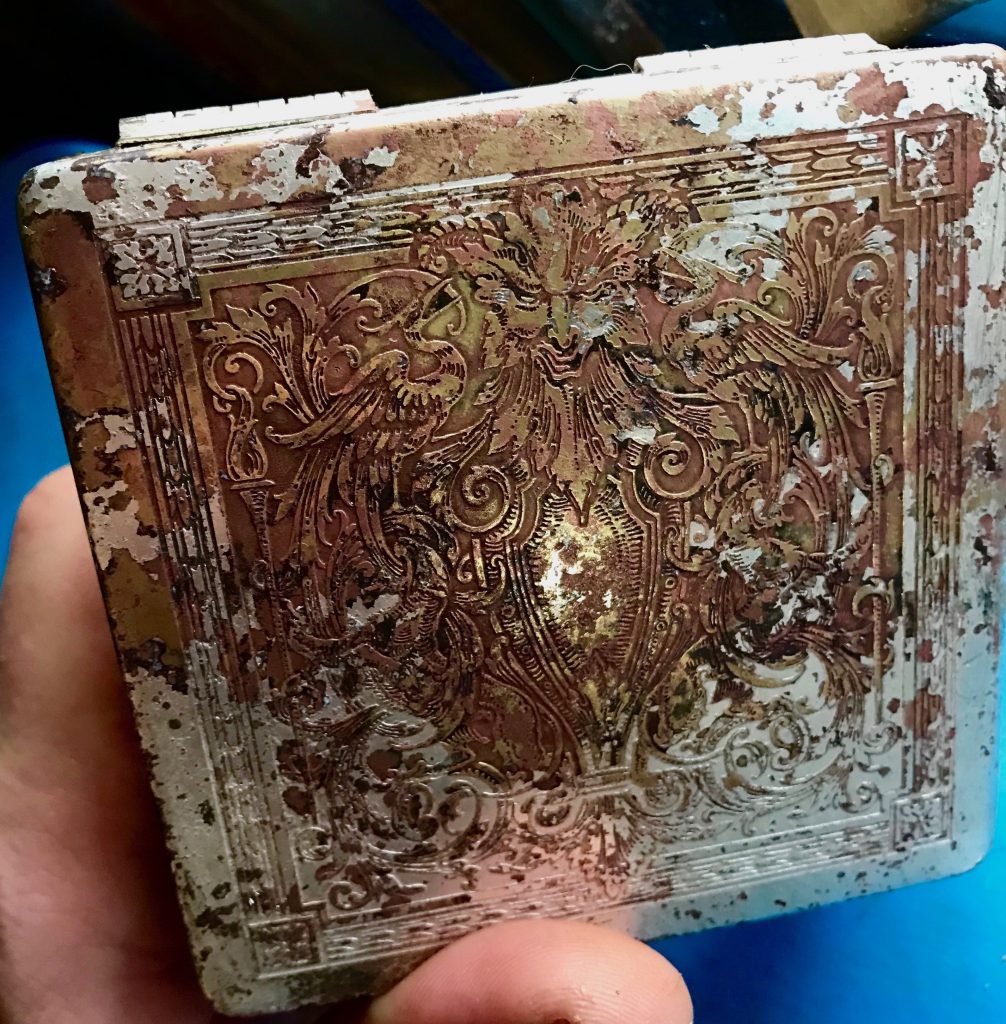
![]() PANDORA’S BOX
PANDORA’S BOX
This elaborately etched trinket box dates to ca 1918. The etching is a mythical scene. At the top center is a large satyr flanked by egrets- their wingtip feathers being devoured by lions. The box is solid copper covered in chrome which has worn off the lid from years underground.
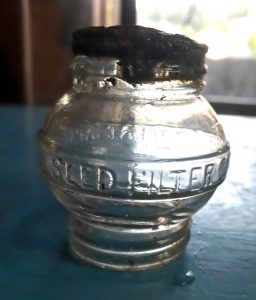
![]() PURITY OF SEED
PURITY OF SEED
The bottle above didn’t filter seeds as one would think. According to Jeffery Hunter of U.S. Bottle Diggers and Collectors, it’s a water filter Patented by Mr. P. Seed of the Seed Water Filter Co. The bottle, which appears to contain rock salt dates to about 1915.
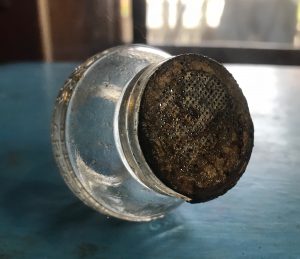
In this shot of the Seed filter top hundreds of tiny holes to strain waters can be seen.
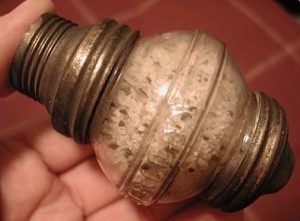
A complete filter system. Note the crystals which may be rock salt.
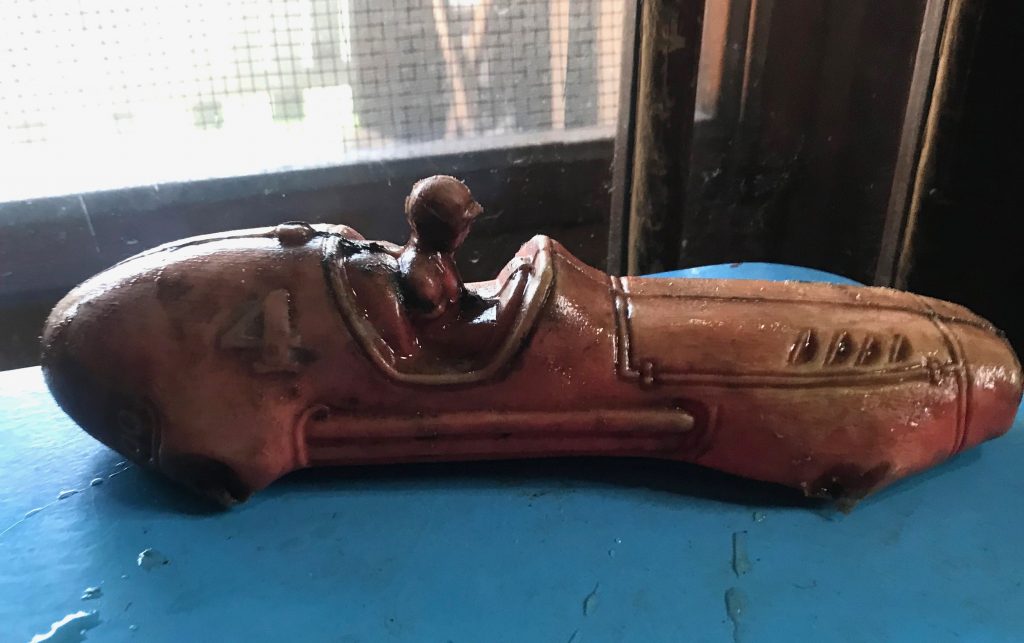
![]() SPEED RACER
SPEED RACER
This 1950s toy race car is going nowhere fast. Found in a brook in Danbury, Ct the wheels have long since disintegrated. A plastic toy such as this could have come from Woolworth’s five-and-dime which for years was a fixture on Main St. in Danbury, Ct.
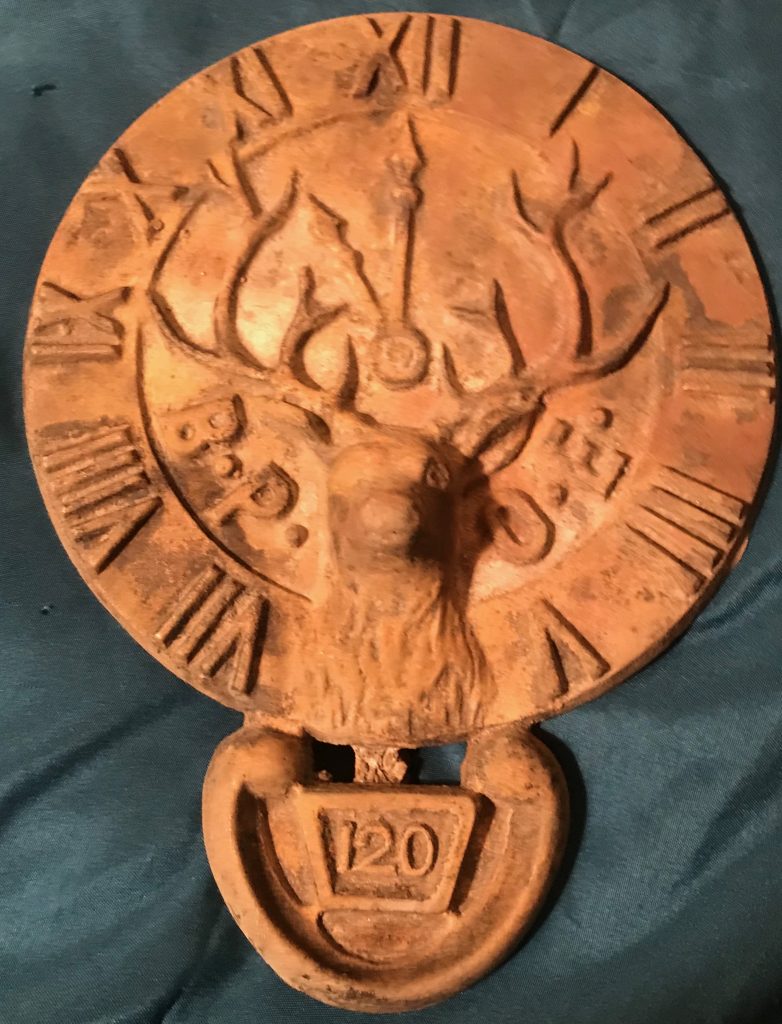
![]() ELKS GRAVE MARKER
ELKS GRAVE MARKER
Unfortunately, there is no way of knowing what grave this Benevolent Protective Order of Elks grave marker came from but we do know this much: the marker belongs to a deceased member of Danbury Elks Lodge 120 and it maybe 40 to 100 years old. We found the marker in a surface dump near Danbury’s historic Wooster Cemetery. The marker is cast brass or bronze. Some of these cast markers are made of aluminum and may be an indication of modern origin. The hands of the clock read 11:00 the traditional time Elks remember their dead.

![]() DANBURY ICON’S LICENSE PLATE FOUND IN WATER
DANBURY ICON’S LICENSE PLATE FOUND IN WATER
The license plate of a Danbury icon was recovered from a brook behind the site of his factory suggesting the industrialist was a litterbug and tossed it there himself over 100 years ago. The C. B. Rogers, artifact was recovered by Hat City Diggers, a team of antique bottle diggers and collectors located in the Danbury area. The discarded artifact was discovered when Hat City Diggers was doing an exploration of the brook behind Rowan St in Danbury, Ct. At first sight, the green and white license plate (above) appeared to be any other rusted out 1916 Connecticut plate but a check of the Connecticut motor vehicle registry for that year showed the plate belonged to Rogers. “The numbers matched. It was like a eureka moment.”, said one of the diggers. In 2015 Hat City Diggers spent two weeks collecting artifacts from the water below a beaver dam in back of Danbury’s famous Wooster Cemetery which abuts the brook in back of Rowan St. “We pulled nearly a dozen relics from the brook but none developed a story like the license plate.” one of the diggers said. Over the years Hat City Diggers have discovered several old Connecticut plates ultimately the team was able to match the plate numbers with the owners. Cephas B. Rogers was born in England and lived on Deer Hill Ave he not only donated the land that would become Rogers park but he also was president of the Roger’s Silver Plating Company. The firm opened its doors on Rowen St on Danbury’s north side 100 plus years ago. The company did silver plating and was famous for its silver-plated lighting fixtures. Why Rogers may have tossed the plate into the brook is unknown but there it sat through tempests and floods at the bottom of the brook (it made it through the famous flood of 1955 that swamped Danbury) Eventually to be found by Hat City Diggers. The team believes there may be other C. B. Rogers artifacts still buried in brook sediments. The Sediments are contaminated by mercury from the hatting industry.

![]() EDWARDIAN ERA BEER TAP
EDWARDIAN ERA BEER TAP
Hat City Diggers discovered this 1900s brass beer tap at the two-foot level in a dump they have been digging on and off for three years. Taps like this were used by the public in wooden beer kegs. Why this tap was discarded is not known.
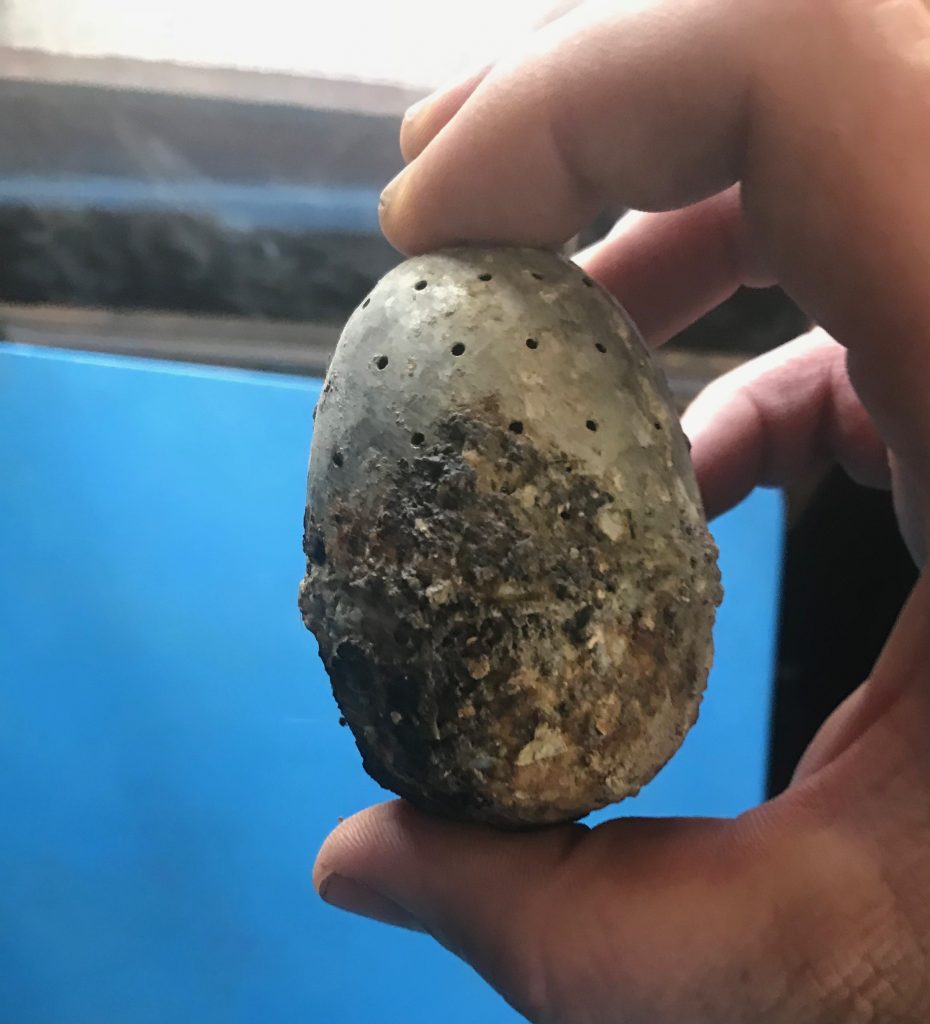
![]() TEA TIME
TEA TIME
People have been drinking tea for thousands of years so it is only fitting Hat City Diggers dig up an antique tea strainer during a visit to our dig site in Saugerties N.Y. As large as an egg this corroded strainer pictured is made of aluminum and dates to the 1910s. Tea anyone?

![]() NO STOPPING KARL HUTTER
NO STOPPING KARL HUTTER
When Karl Hutter killed himself in 1913 he was famous and wealthy because of a small device he didn’t even invent. Hutter was born in Germany on February 14, 1851. According to Karl Hutter- The Stopper and the Bottles by Bill Lockhart, Beau Schriever, Bill Lindsey and Carol Serr, Hutter left Germany at 16 and became a U.S. citizen in 1871. He bottled beer and eventually entered the bottle stopper business when “Charles de Quillfeldt assigned his reissued patent to Hutter on June 5, 1877.” Quillfeldt patented the device in 1875 calling it the lightning stopper.
BABY I’M A RICH MAN
Several lawsuits followed after Hutter’s reissue of the patent but all were dismissed. When Hutter made improvements to the stopper in 1893 (he designed and patented his famous porcelain stopper around this time) Karl became a very rich man. The three stoppers above carry his name and the 1893 patent date.
THIS IS THE END
Throughout his life, Karl appears to have suffered deep bouts of depression, called melancholia during his time. In 1913 according to an internet source, Hutter drew a bath entered the tub and put a bullet through his head. Hutter died a bachelor.
STOPPERS, STOPPERS, EVERYWHERE
Nearly every dump in Danbury Hat City Diggers has dug has contained a Hutter stopper. Interestingly the Hutter stopper was used both on blob and crown finishes (this is based on empirical evidence).
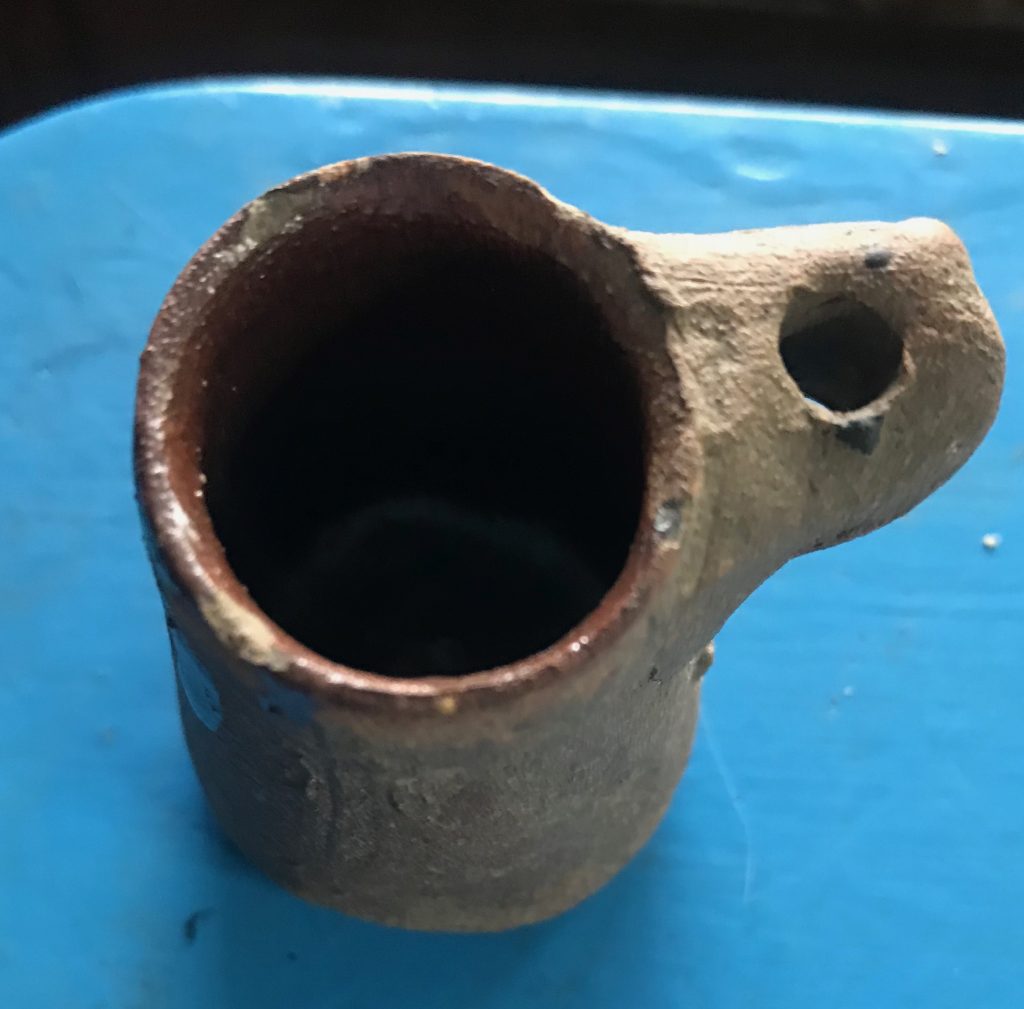
![]() CANARY IN A COAL MINE… IN THE HAT CITY?
CANARY IN A COAL MINE… IN THE HAT CITY?
The artifact shown is a bird feeder used by coal miners in their birdcages they brought into the mines. The cage held a canary that warned miner of poison gas when the bird passed out or died. However, Danbury was a hatting town and a far cry from the coal mining communities of rural Pennsylvania. So what was this feeder doing in the Hat City? The simplest explanation is that the clay feeder above was a cheap generic variety found at any thrift shop across the U.S. and was just as easily purchased in a coal mining town like Wilkes-Barre, Pa as in the Hat City, Danbury, Ct.
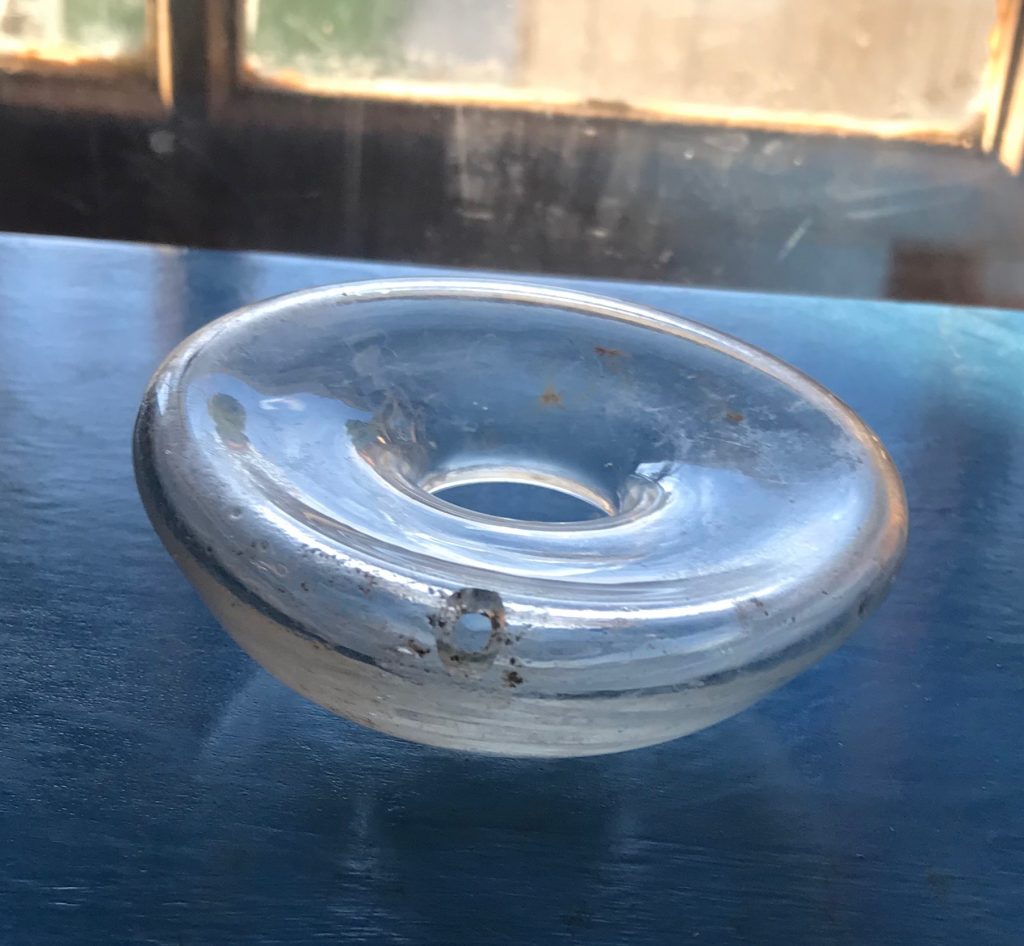
![]() SOLVED!
SOLVED!
From Hat City Diggers, “What the hell is this files,” comes the latest unexplainable object but it didn’t stay unexplainable for long. After posting a picture of the object (pictured above) on a Facebook group site on bottle digging and collecting, we got our answer. It turns out the mystifying thing is a 19th-century nipple shield. This shield is nothing like the one worn by Janet Jackson instead it covered a woman’s nipple to protect it after it became sore and raw from nursing. In addition, the shield collected milk which could be dispensed through the small hole (below left) into a baby’s bottle.

![]() BLACK GOLD!
BLACK GOLD!
Hat City Diggers dug up a black glass threadless insulator that may be worth bookoo bucks. According to an appraiser specializing in insulators, this black beauty could be worth a thousand dollars. Although unembossed, it probably was made in New York or New England at the end of the Civil War.

![]() LET THERE BE LIGHT
LET THERE BE LIGHT
Only about three percent of American homes were lit by electricity in 1900. Without a doubt, Danbury fell into this category. Two common 19th-century ways of lighting homes were with gas and oil. Hat City Diggers is unsure how many Danbury homes were lit with gas – we have found parts of gas light fixtures during some of our digs- but more than likely Danbury homes were lit using oil- whale or kerosene- the latter utilized more often than the former. Above is a small bedside lamp Hat City Diggers discovered during a recent dig. Lamps like this burned kerosene which produced a brighter light than whale oil lamps. And though kerosene was cheaper it wasn’t safer. The Danbury News and Danbury Evening News both carried stories about fires being caused by kerosene lamps which seemed to explode into fireballs resulting in death or injury when homes or articles of clothing caught fire. The lamp (above) is made of milk glass. Years of underground life has eroded the paint, however, some traces can still be seen around the neck of the lamp.
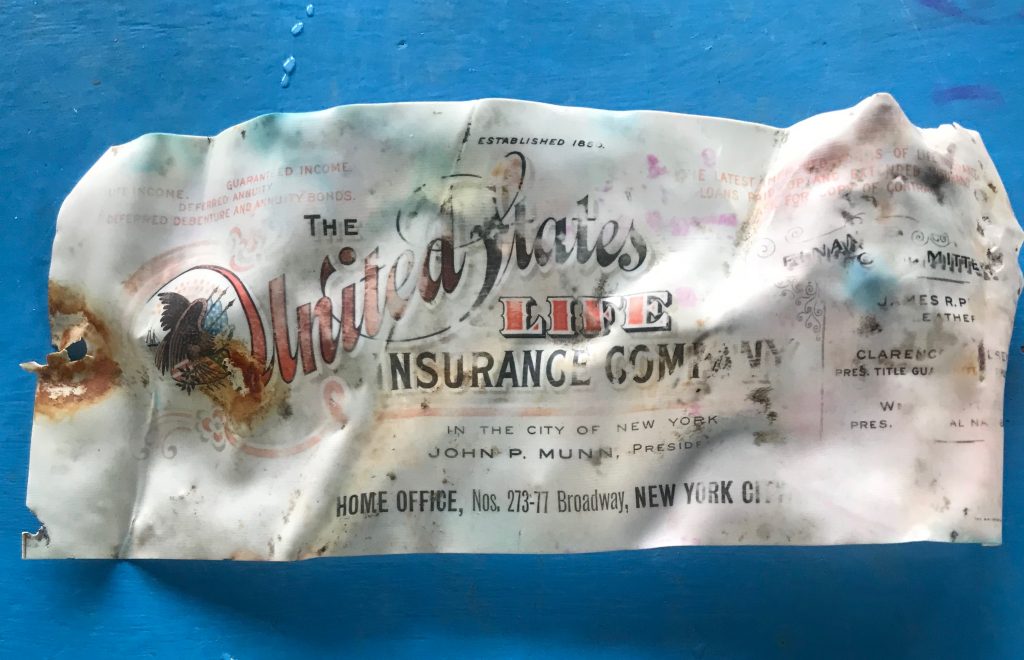
![]() SIX FEET UNDER
SIX FEET UNDER
From deep in the ash layer comes a Celluloid artifact. After opening up a hole we’ve worked before, we discovered this advertising card for the United States Life Insurance Company. Dating the piece was easy. The printing on the card clearly states John P. Munn was president. Munn became U.S. Lifes president in 1902 when George H. Burford stepped down as president because of ill health. Therefore, the ad card dates from 1902 or after. We have found no machine-made bottles in this dump (other than milks) and we have been digging there for three years. In our opinion, the ad card dates to before 1910 at most. The United States Life Insurance Company is still in business today.
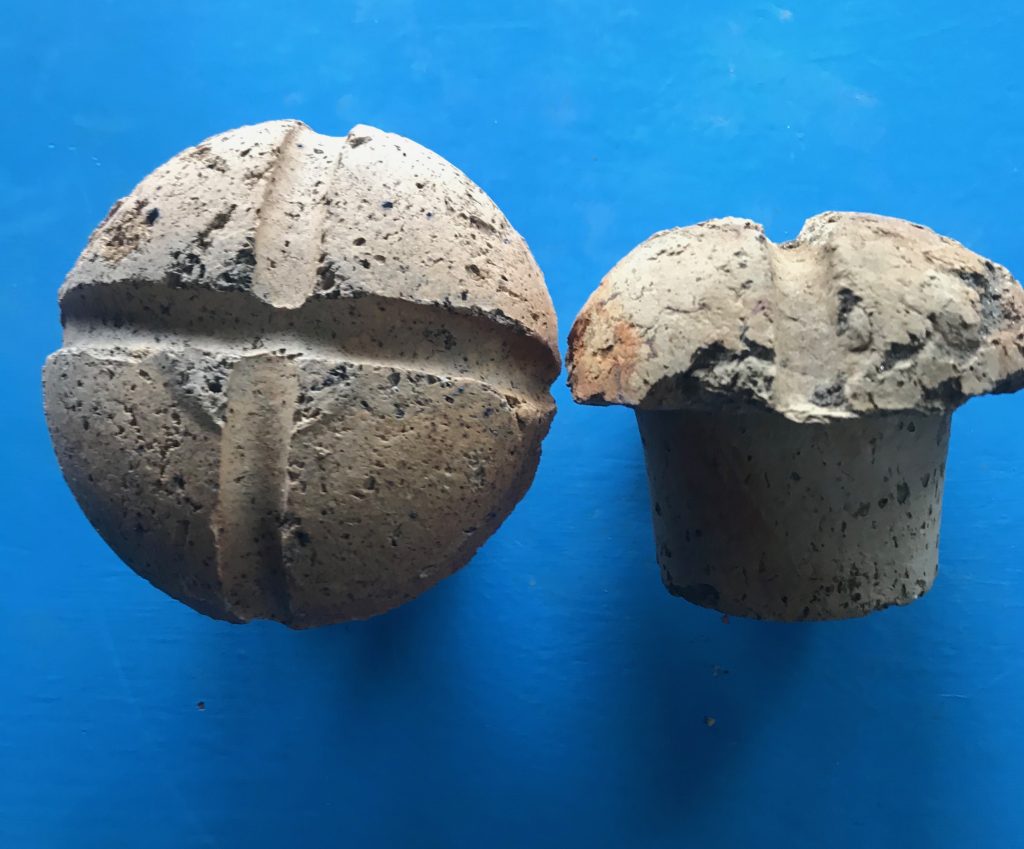
![]() FROM THE HAT CITY DIGGERS “WHAT THE HELL IS THIS” FILES
FROM THE HAT CITY DIGGERS “WHAT THE HELL IS THIS” FILES
Hat City Diggers find hundreds of things during the digging season, however, none are more perplexing than these curious clay objects (above). We mostly find them while creek walking streams and rivers in the Danbury area basically around old factory sites. There were many hat factories located along these waterways and we theorize these clay objects have something to do with these factories. Several members of a Facebook bottle group weighed in on exactly what these mushroom-shaped objects could be and one of the best explanations comes from Jim West “there (sic) tops to carboy[s] that usually held acids or solvents tied with wire around the top the acids wouldn’t eat that type of clay I find them around old textile plants here in NC,” Considering the chemicals used in the hat-making process, Jim’s theory seems to be the most plausible explanation. Mark this one as solved!
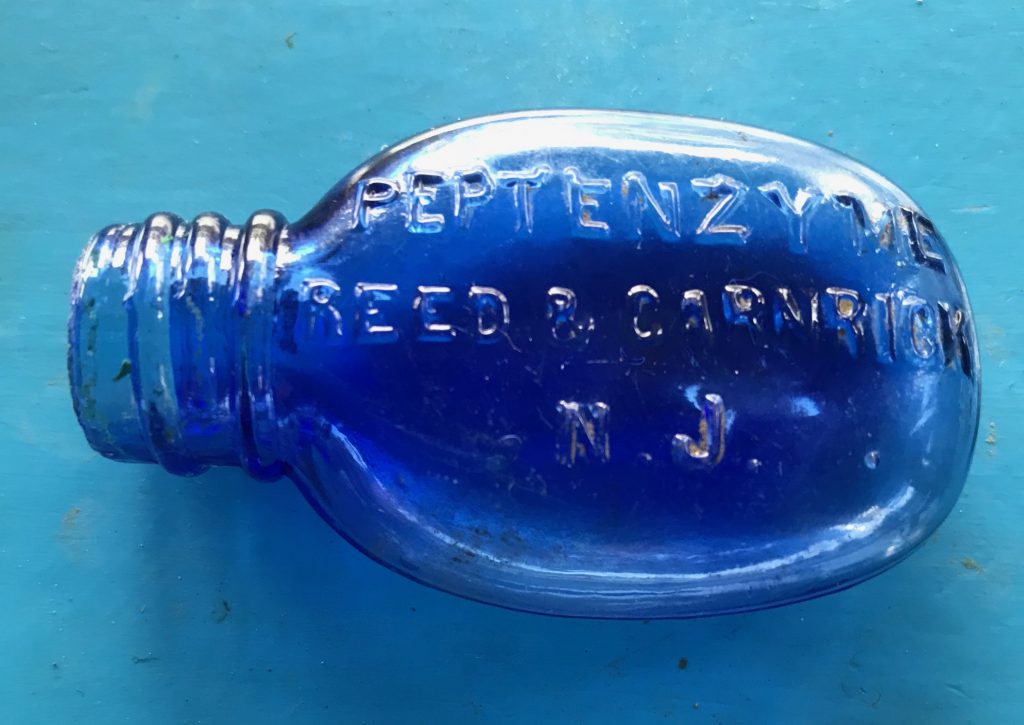
![]() BABY BLUE
BABY BLUE
This diminutive Peptenzyme bottle ca 1900 contained pills to sooth the complaints of early 20th century stomachs. The Reed and Carnrick Co started around the time of the Civil War. Peptenzyme was one of their best sellers. Nevertheless, residents of Danbury appear to have preferred another patent medicine over the little blue bottle. We found this med in every Danbury dump we’ve dug to date and it also came in a blue bottle. What was it? What else- Bromo Seltzer.

![]() CELLULOID HEROES. 1905 OR 1906 BLUE LABEL CIGAR PRO-UNION/ANTI-TRUST MUSTACHE COMB AND HOLDER SLEEVE
CELLULOID HEROES. 1905 OR 1906 BLUE LABEL CIGAR PRO-UNION/ANTI-TRUST MUSTACHE COMB AND HOLDER SLEEVE
The Progressive-era was in full swing when this neat little advertising piece was issued. It’s made of celluloid an early and highly flammable plastic. We dug it out of a dump in Connecticut near the Sadie Evens property. According to reports, Sadie was a long time Ridgefield resident who may have died in a fire that swept through the property years ago. As details emerge, we will learn more about the late Sadie Evens and continue to update you.
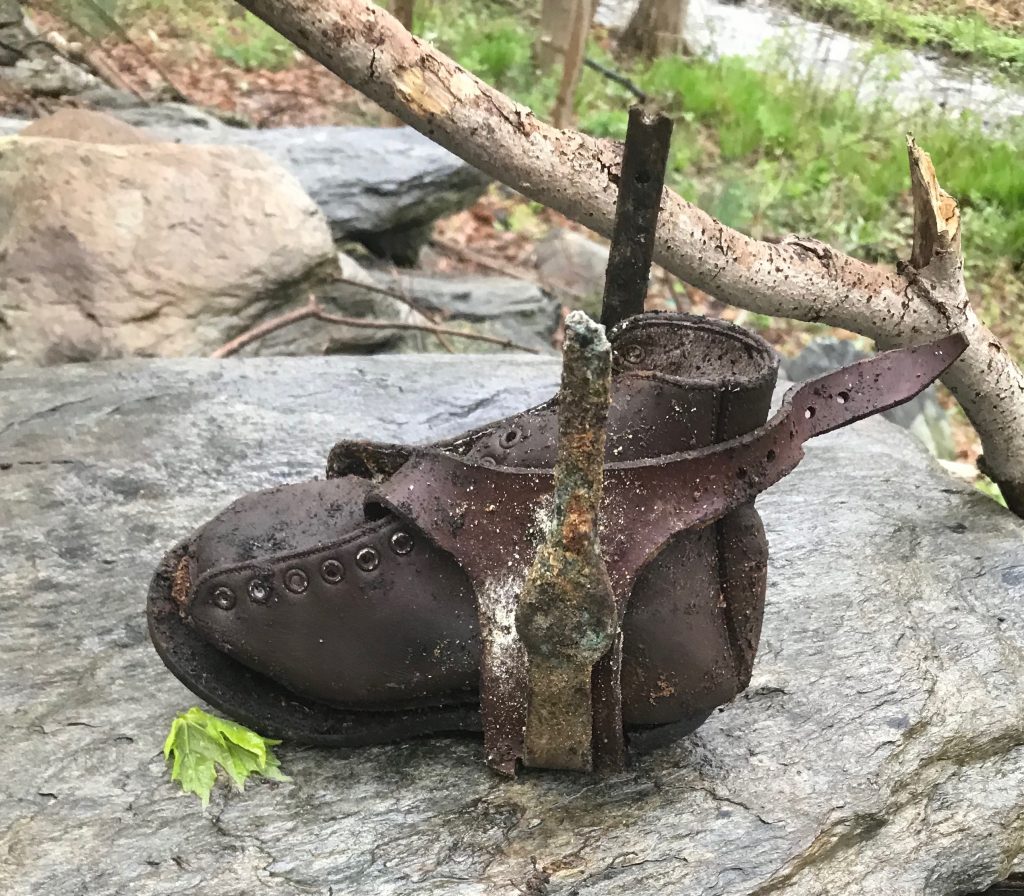
![]() CHILD’S POLIO BRACE- A GRAPHIC REMINDER OF A PRE VACCINE ERA
CHILD’S POLIO BRACE- A GRAPHIC REMINDER OF A PRE VACCINE ERA
This polio brace is a stark reminder of a time when there was no vaccine against the poliovirus- a disease that crippled tens of thousands of children and adults in the U.S. including the president of the United States, Franklin Delano Roosevelt. We found this brace in a dump in New York State. The brace likely belonged to a boy 4 or 5 years old.
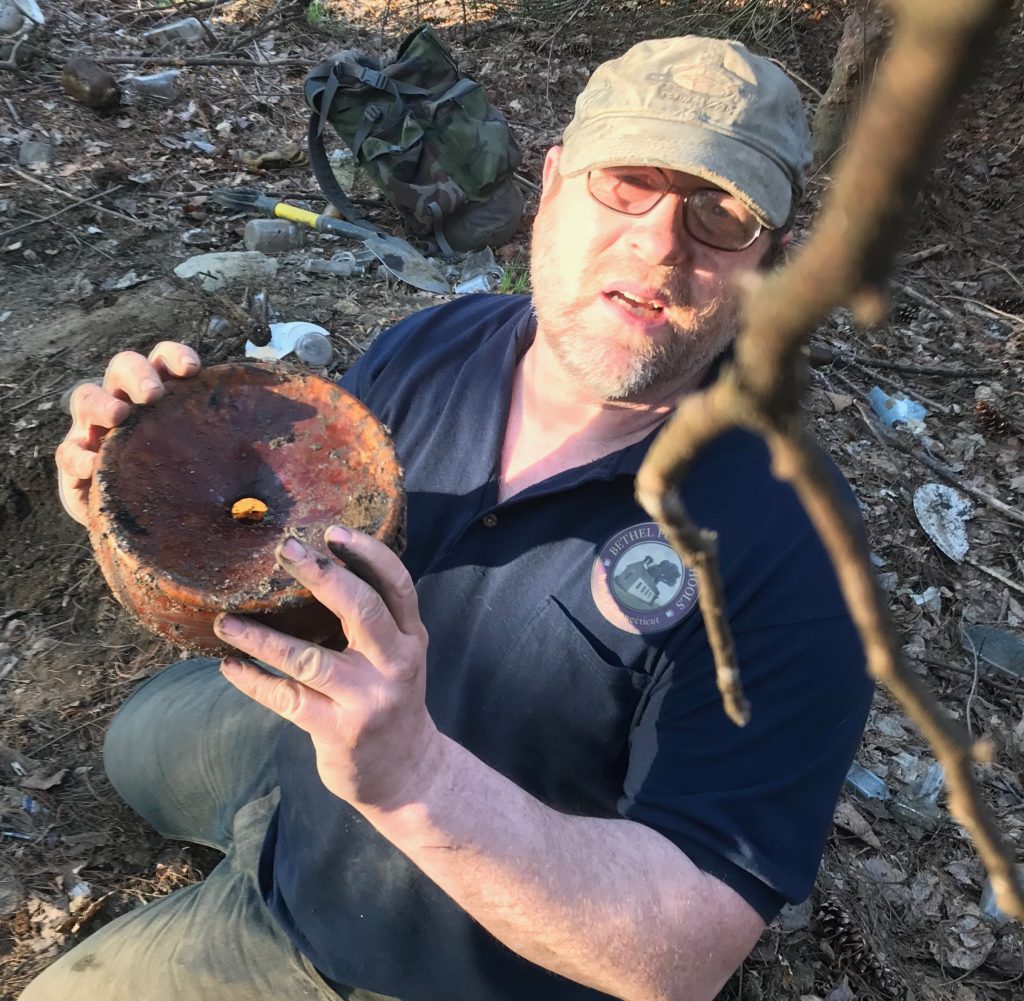
![]() MINT CONDITION PRIVY FIND (BENNINGTON SPITTOON)
MINT CONDITION PRIVY FIND (BENNINGTON SPITTOON)
Still covered in night soil and dirt this Bennington spittoon sees the light of day for the first time in over one hundred years after sitting at the bottom of a stone-lined privy. Likely dropped into the privy accidentally it was recovered by Hat City Diggers in mint condition.
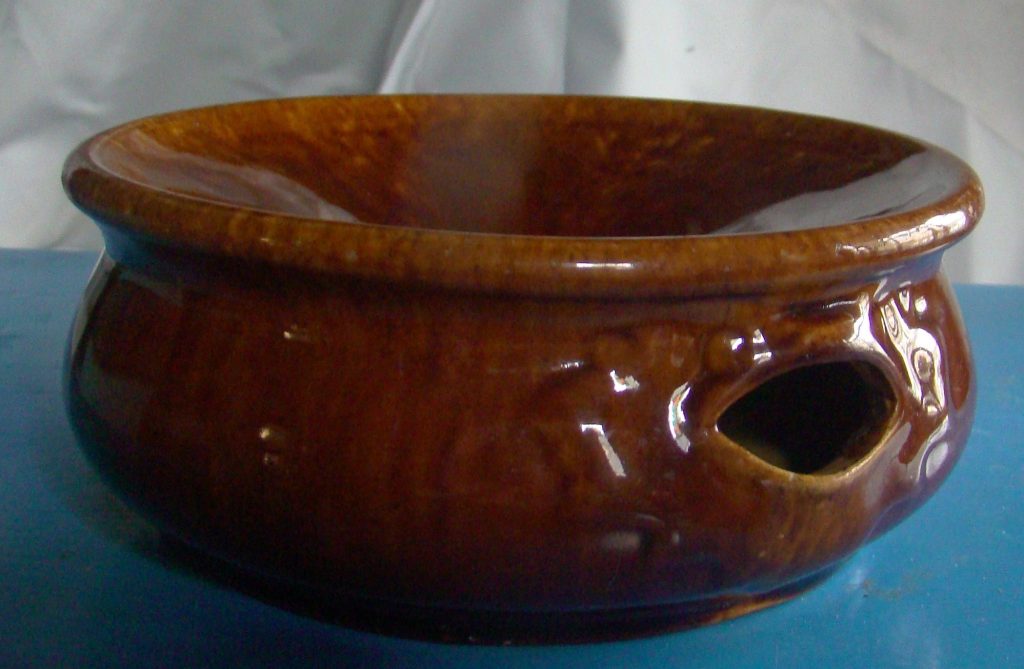
After cleaning, the Bennington spittoon ca 1845 looks like it was fired yesterday

![]() PRIVY FIND
PRIVY FIND
(Top) 19th-century urinal as it looked after being extracted from a loaded North Salem N.Y. privy. Note the yellow tinge. (Below) After being repaired and cleaned.
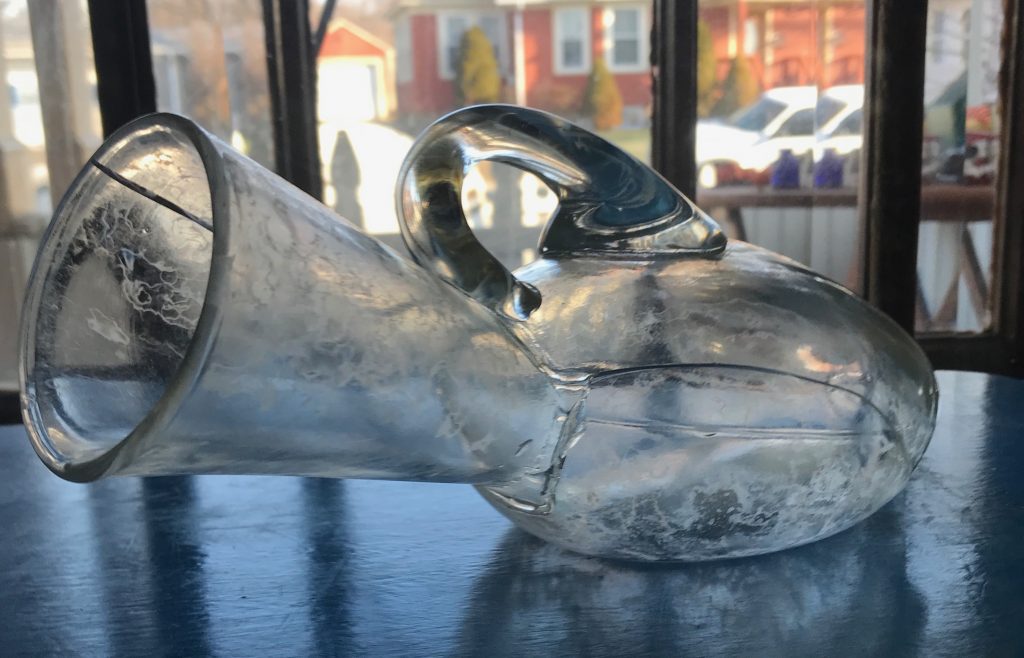 Although it’s cracked, it displays nicely. The urinal was probably damaged when it slipped from the user’s hand and fell into the privy.
Although it’s cracked, it displays nicely. The urinal was probably damaged when it slipped from the user’s hand and fell into the privy.
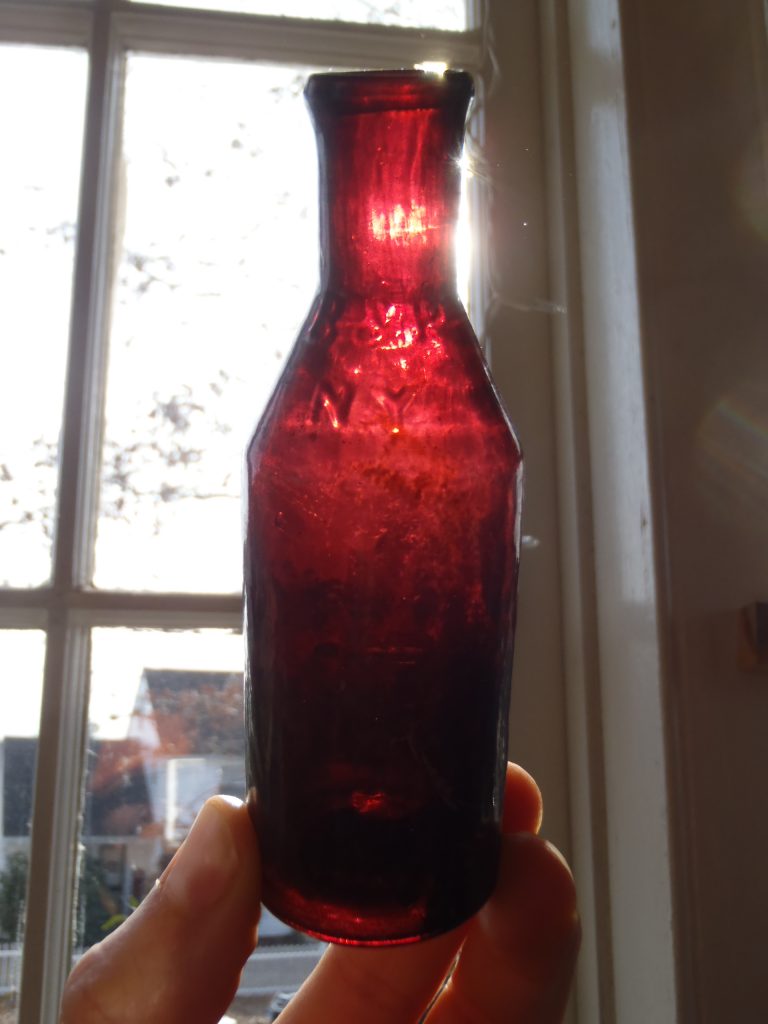
![]() THE ROAR OF THE LYON
THE ROAR OF THE LYON
A puce Lyons powder erupts with color as sunlight strikes it through a window. We discovered this rare gem in Danbury a few years ago. And it is a nice addition to our collection. This bottle dates to the 1850s.

The powder’s open pontil is clearly visible in this shot
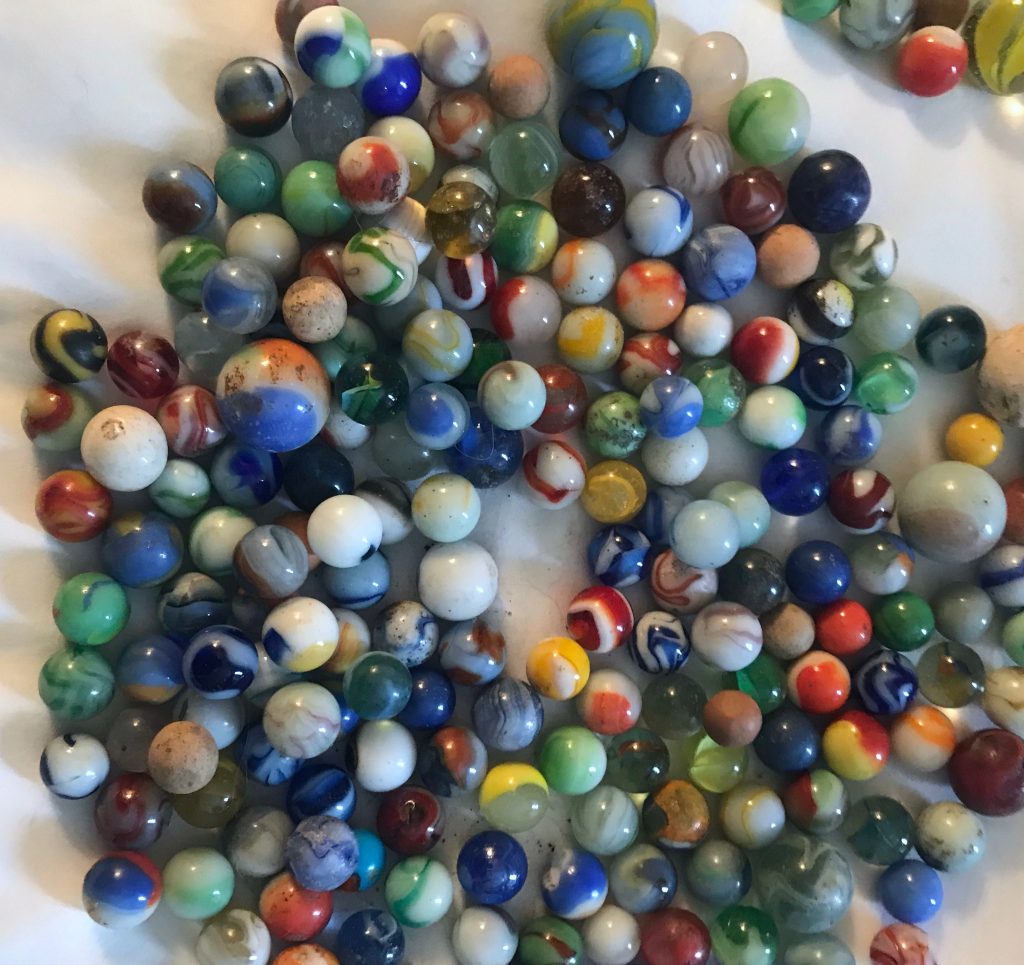
![]() FAMILIAR FINDS.
FAMILIAR FINDS.
Marbles, like the colorful cache above, are well known to diggers of dumps. Nearly every dump Hat City Diggers have excavated has contained marbles. Why these colorful children’s toy are discarded in a bottle dump is a bit of a mystery. Nevertheless, they are always a welcome find. Age of these marbles range from the 1800s to the 1930s
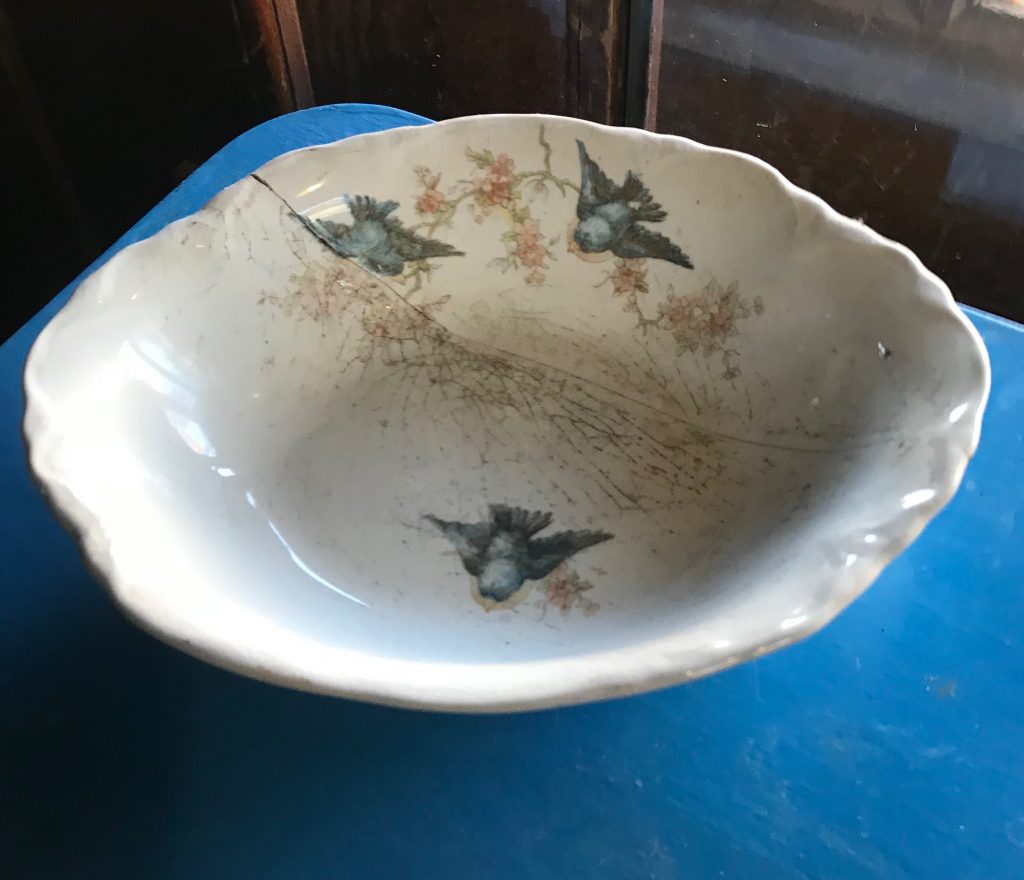
![]() PRIVY FIND
PRIVY FIND
This Homer Laughlin scalloped bowl which dates to the 1940s was taken from a New York State outhouse during a recent dig. According to the American Economist January-June, 1913 Homer Laughlin started his pottery firm after the Civil War in East Liverpool Oh. He died at age 70 in Los Angles Ca. in 1913.
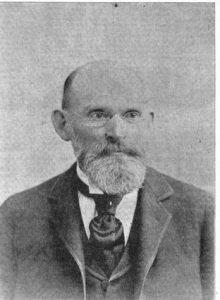
Homer Laughlin

![]() BREAKING BREAD.
BREAKING BREAD.
Hat City Diggers love to find porcelain signs. And when we discovered this ButterKrust beauty under a barn in New York State we got excited. Although it’s bent and roached it is still quite collectible. We are not authorities on these type of collectibles so dating this sign is difficult. It may be from the 1930s or earlier. The General Baking Company appears to have been in business as early as the 1910s.
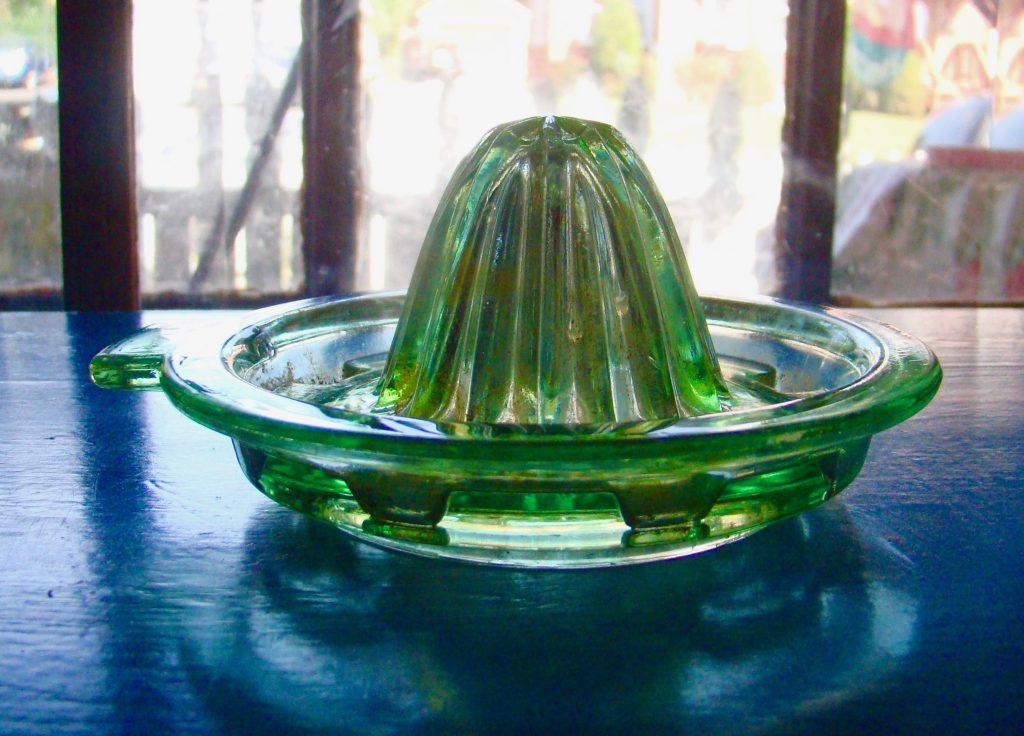
![]() RADIOACTIVE REAMER.
RADIOACTIVE REAMER.
Because uranium was used in the glass coloring process, depression glass pieces like this juicer are radioactive and will glow under UV light.

![]() LITTLE BOOT…
LITTLE BOOT…
Rigid from age, this boy’s boot sees light after decades underground. Hat City Diggers recovered this artifact belonging to a child between 8 and 10 years old from a 1910s ash layer in the village of Saugerties in Ulster County N. Y.

The boot (above) is similar to the one in this photo.
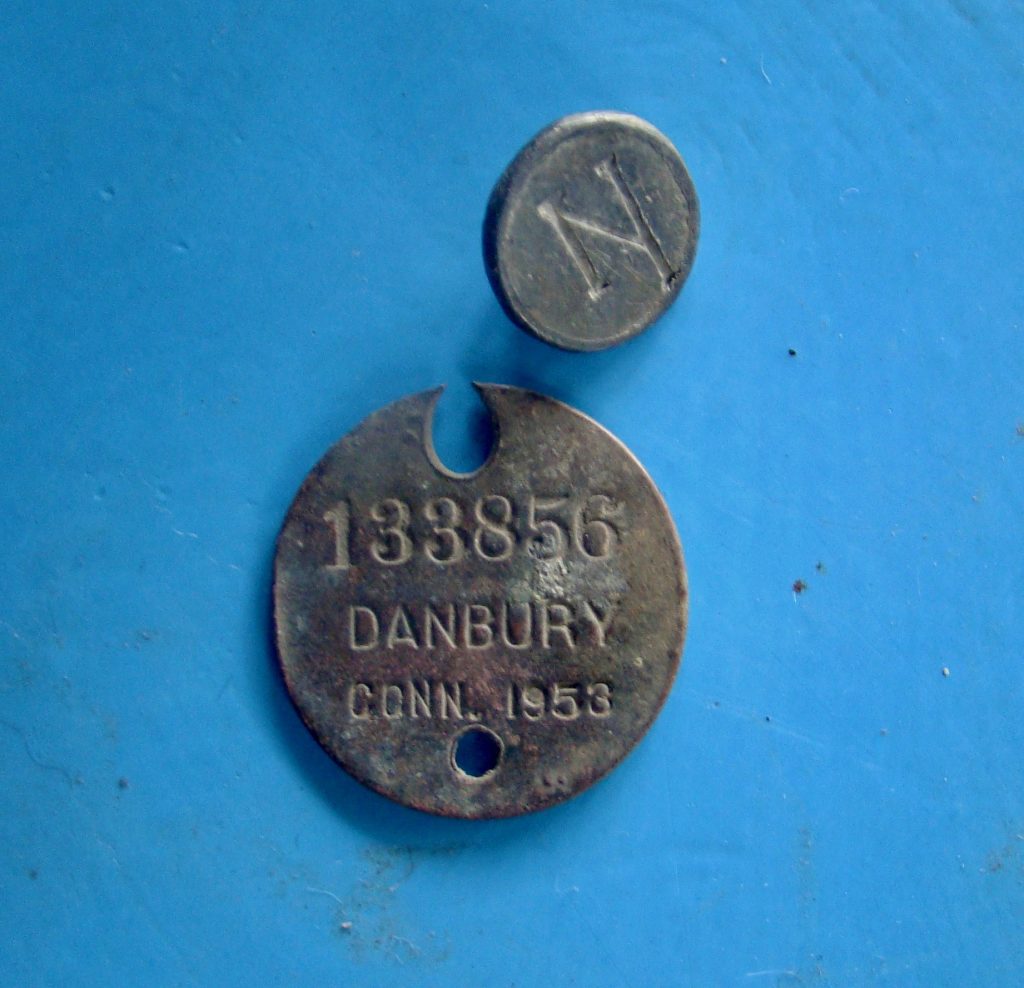
![]() FOR MAN, FOR BEAST.
FOR MAN, FOR BEAST.
We dug the two artifacts pictured at different sites years apart. The artifact (above) is a New York Revolutionary War uniform button. The artifact (below) is a 1953 Danbury, Ct dog license.
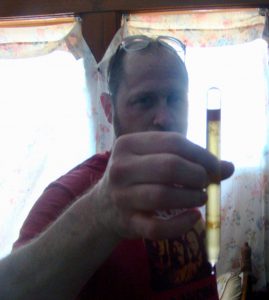
![]() FROM THE HAT CITY DIGGERS “WHAT THE HELL IS THIS FILES…”
FROM THE HAT CITY DIGGERS “WHAT THE HELL IS THIS FILES…”
Sometimes we diggers come across an artifact we just can’t explain. Such is the case with the item above. We dug this glass tube filled with colored liquid from a dump in New Milford, Ct in 2015. And since then we have been trying to figure out exactly what it was used for. If anybody cares to guess feel free to contact us.
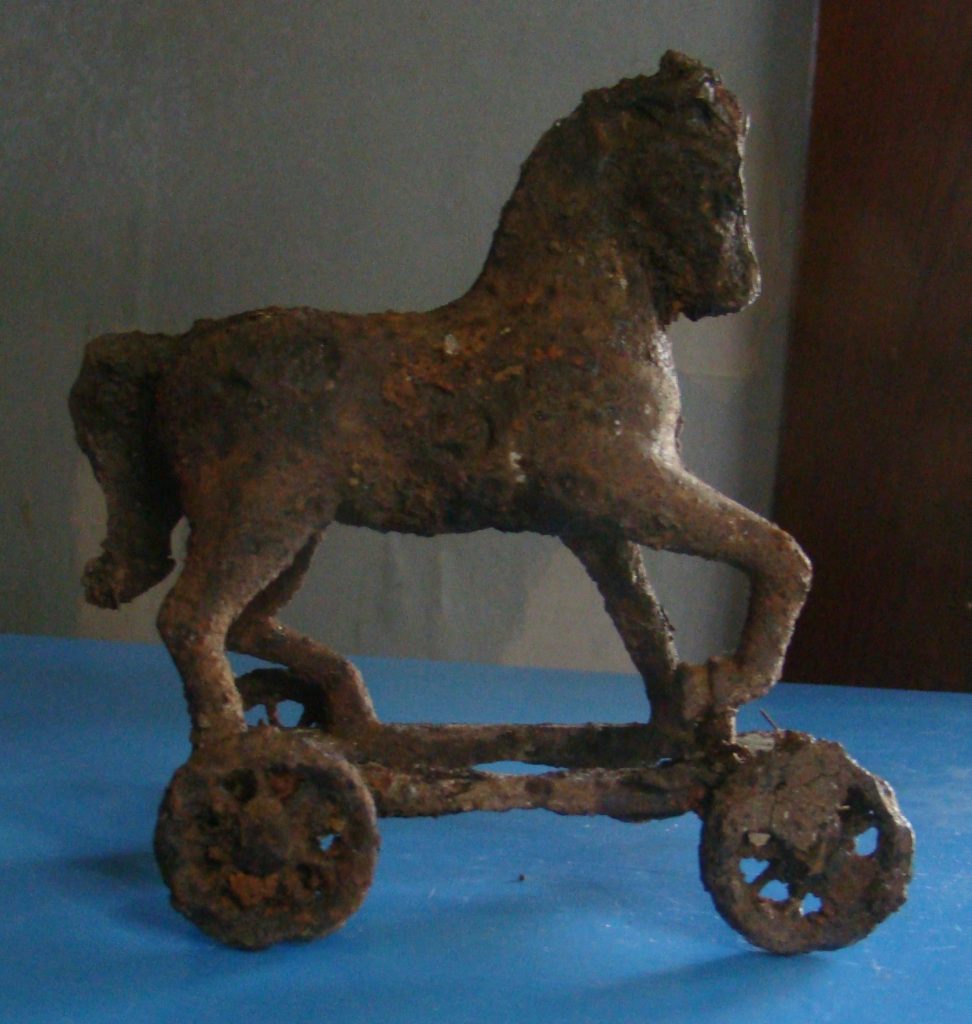
![]() GIDDY-UP!
GIDDY-UP!
This cast iron horse has seen better days. In spite of this, it’s still a terrific find and it wasn’t just a pull toy it was also a bank. The horse in the internet photo (below) is exactly like the one above but hasn’t been sitting in a dump for 80 or 90 years so obviously, it’s in much better condition.
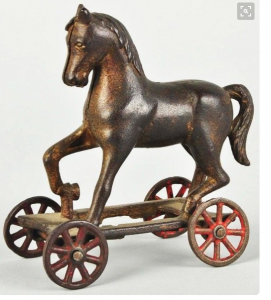

![]() COFFEE, TEA, MUSTACHE?
COFFEE, TEA, MUSTACHE?
Just like the rest of the country during the 1890s mustaches were all the rage in Danbury. And what better way to drink your coffee or tea than with a mustache cup. Invented in the 1830s by potter Harvey Adams, the cups were designed “[with] a raised lip guard attached from rim to rim of the cup to keep the mustache and beard from touching the liquid.” We dug the one pictured from a large trash dump in Danbury about two years ago.
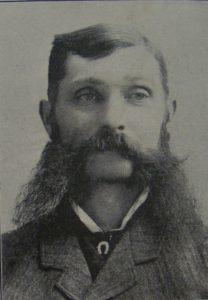
During the naughty nineties, Danbury men like bottler Jean Hornig (pictured) may have used mustache cups when they engaged themselves with a cup of tea or coffee. (photo courtesy Danbury Museum)
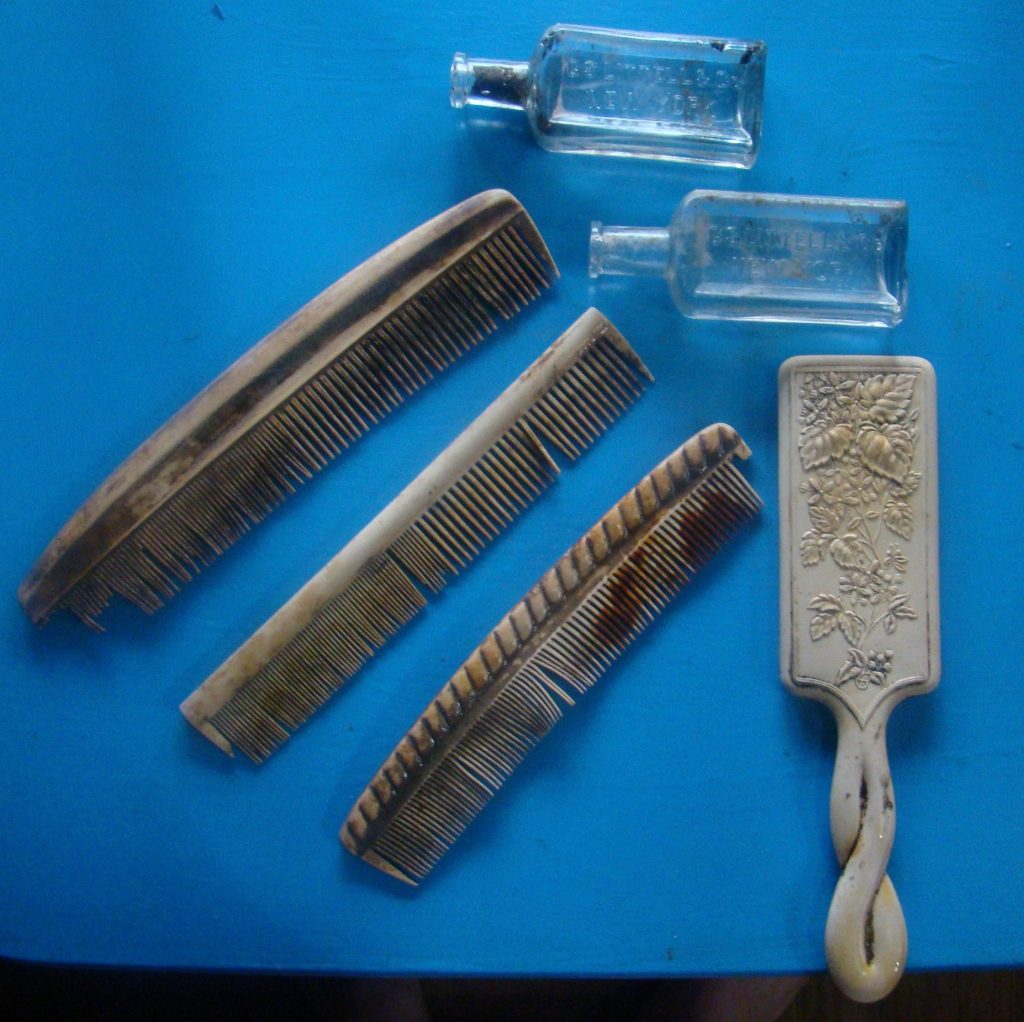
![]() ARTIFACTS OUT OF PAWLING.
ARTIFACTS OUT OF PAWLING.
From New York State come six artifacts from the 1910s. (pictured above) Two Charles S. Littell bottles from New York City. (at left) Three celluloid combs of varying shapes. (right) A decorative celluloid hairbrush.
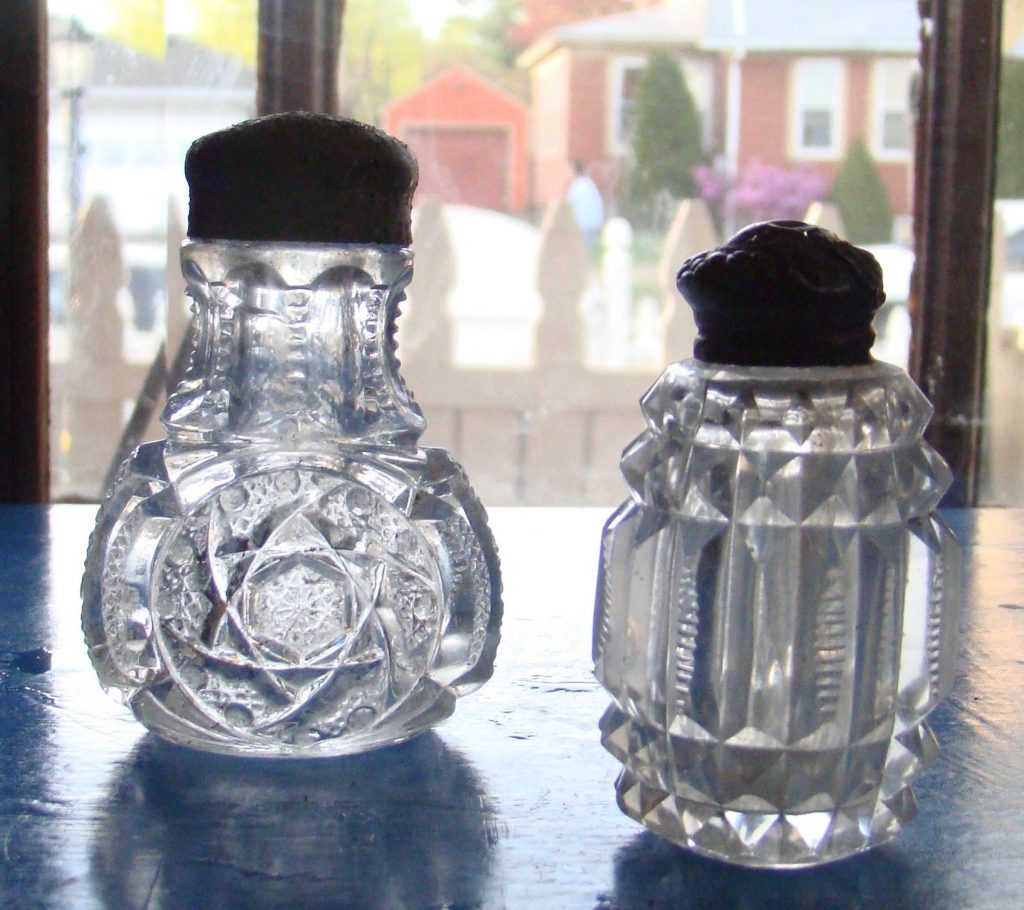
![]() Ornate Edwardian glass
Ornate Edwardian glass
According to American Pressed Glass, the widespread production of pressed glass began in the 1820s in England and the United States. The glass would be removed from a furnace molten hot and moved quickly to the press by an apprentice “…where it would be sheared off and squeezed into the mold by a master craftsman.” Pressed glass is still produced today. The salt and pepper shakers in the photo above were created sometime in the early 20th century. Both pieces come from dumps we discovered in Danbury.
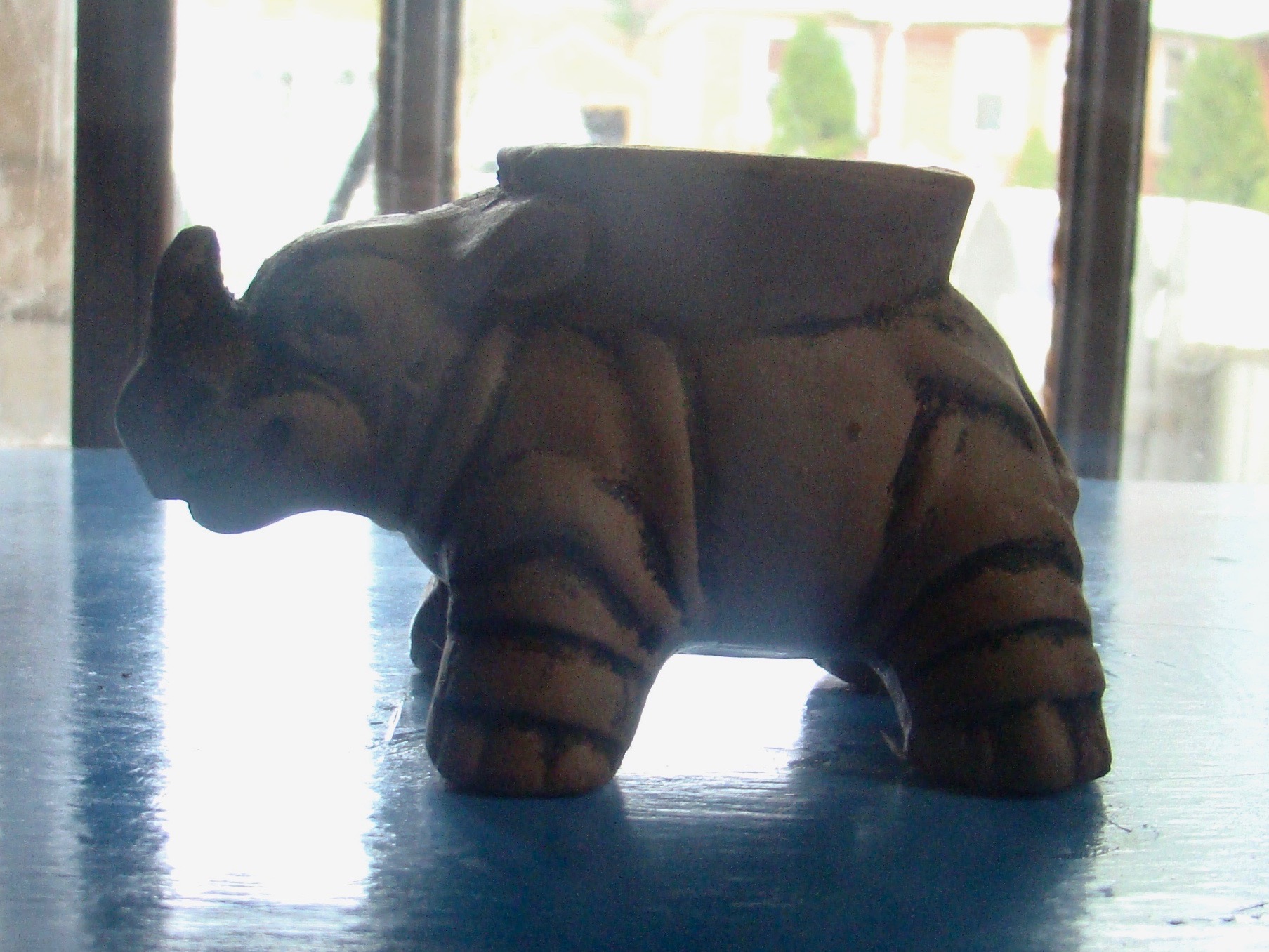
![]() RADICAL RHINO.
RADICAL RHINO.
If you’re thinking Chia Pet, guess again. This rhinoceros planter predates Chia by almost 50 years. We dug this artifact and several bottles from a dump in the back of Merrimac St, Danbury.
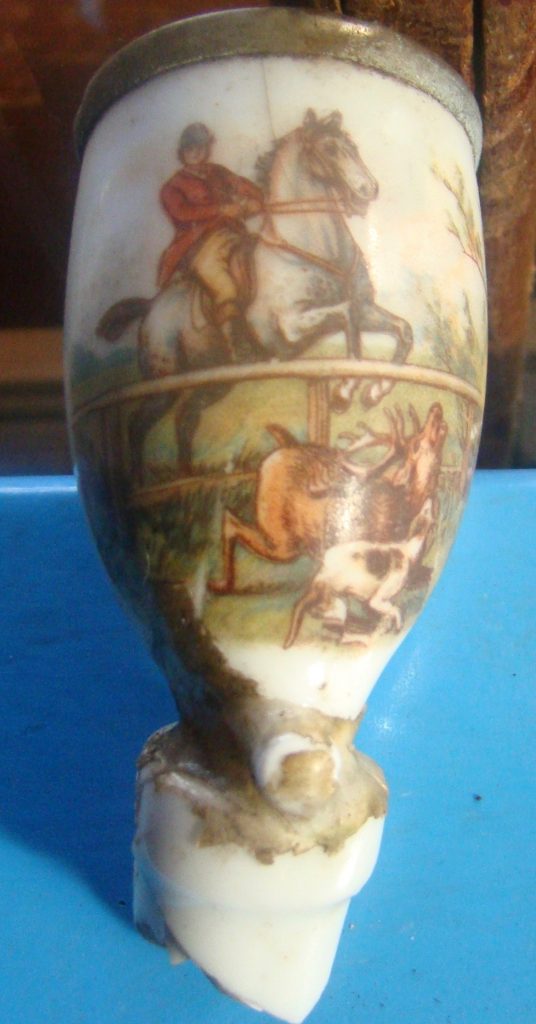
![]() FOUND EASTER SUNDAY 2017.
FOUND EASTER SUNDAY 2017.
We found the pipe above at the bottom of an embankment that runs along a side street in Pawling N.Y. Though popular in Europe in the 19th century, they weren’t as fashionable in the USA. Handsome porcelain pipes like this by and large depicted mostly hunting-related scenes. A person could buy ornate pipes through catalogs, such as the famous Sears and Roebuck. Note the repair at the base of the bowl.
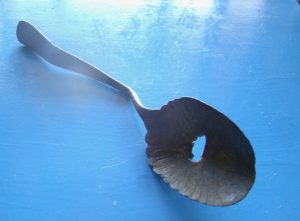
![]() BULL’S-EYE.
BULL’S-EYE.
I plead total ignorance when it comes to spoons. That is to say, I know next to nothing about the utensil. However, I did a quick internet search and found useful information, but to tell the truth, spoons are just plain boring. This one, however, is the exception. Not because of the style or shape but because of what happened to it. Someone shot a bullet right through it.

![]() CANDY IN A CAR.
CANDY IN A CAR.
Victory Glass Company out of Jeannette, Pa. produced this candy container we dug from a dump in Danbury a few years ago. According to Glasshouses and Glass Manufacturers of the Pittsburgh Region, by Jay W. Hawkins, the Victory Glass Company started operations in 1919 making candy containers shaped like cars, airplanes, telephones, tanks, animals and more.

![]() 19TH CENTURY ALPHABET PLATE.
19TH CENTURY ALPHABET PLATE.
The popularity of alphabet plates was at its height in the 19th century. Scenes like the rugby or football players pictured on the plate above were well-liked by 19th-century lads. The letters ringing the plate weren’t just decorative they had a didactic purpose. The plate pictured was pieced together from two parts found in a dump near Rose St in Danbury, Ct. It dates between 1870 and 1890. In perfect condition, a plate-like this would sell for around $30 today.
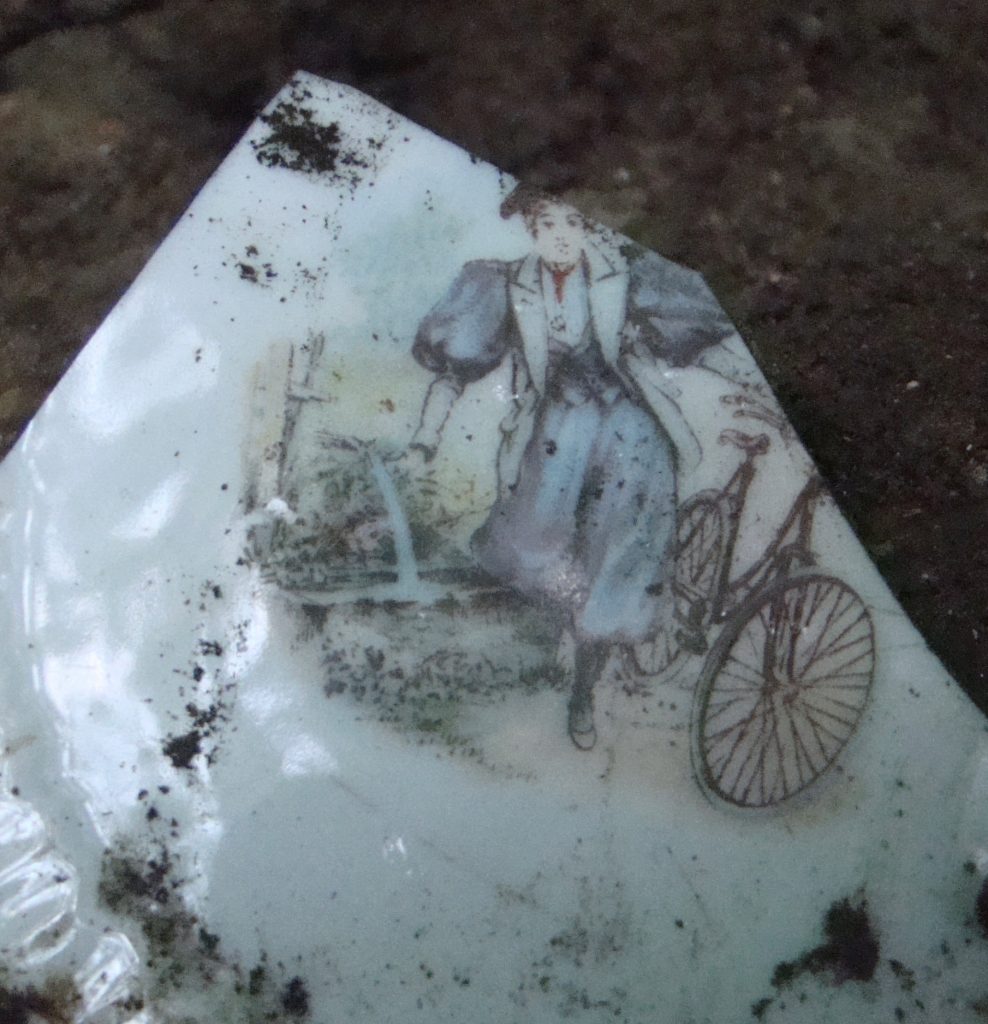
![]() Bike bloomers: a step toward women’s liberation?
Bike bloomers: a step toward women’s liberation?
A Victorian-era lady in sporty bike bloomers is geared up for a ride in a scene on this plate fragment we uncovered over the summer. Bicycling became the rage in late 19th society and both men and women enjoined the pastime. The famous penny-farthing AKA high wheeler bicycle was the preferred choice but because of accidents and injuries, however, the safety bike, like the one pictured, became the norm.
Sassy bloomers, like the young lady is wearing, evolved out of necessity. The long dresses which enveloped Victorian era ladies easily became tangled in bicycle parts. Curiously these bloated bloomers and the bicycle helped propel women away from the constraints of a male-dominated society. Specifically, women had to peddle the bicycle, that is, they had to straddle the machine, i.e., open their legs in public-quite a proposition in polite Victorian society! The only way to do this, however, was by wearing pants. Today women in pants are taken for granted, however, 120 years ago this was not the norm. As bike fashion evolved, so did women’s attitudes. Consequently, bloomers and the bicycle, just as the washing machine, helped free women, body and mind, from the drudgery of home, propelling them into the 20th century with a newfound sense of independence and empowerment which lead first to the suffragist movement, then later, to feminism and the sexual revolution. The fragment above dates to the late 1890s.
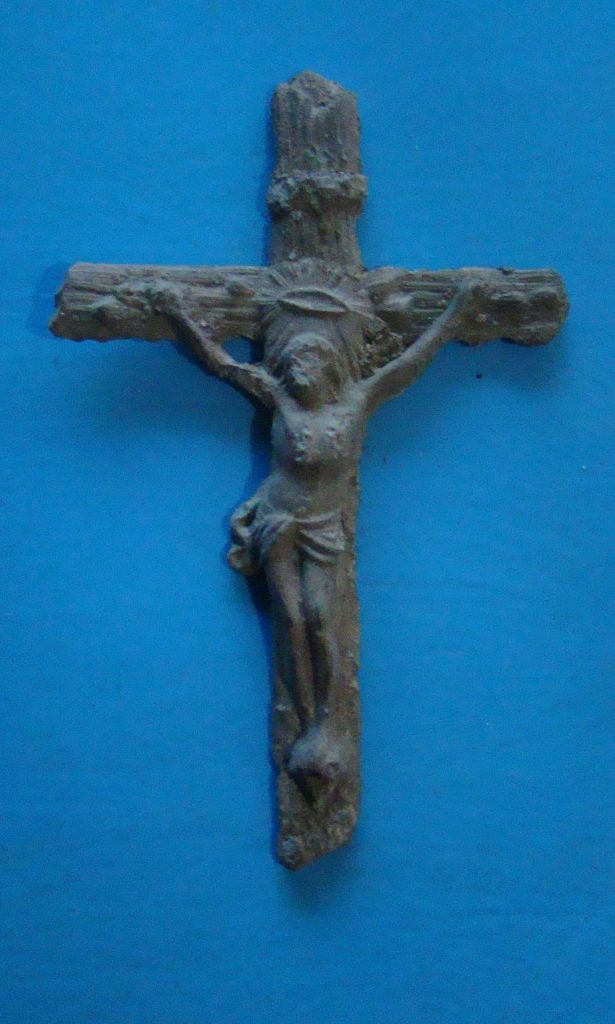
![]() Appropriately for Lent- a crucifix.
Appropriately for Lent- a crucifix.
Why someone would throw out a crucifix is beyond me. We dug This one from an embankment dump in Danbury. It appears to be made of pot metal and its age is unknown.
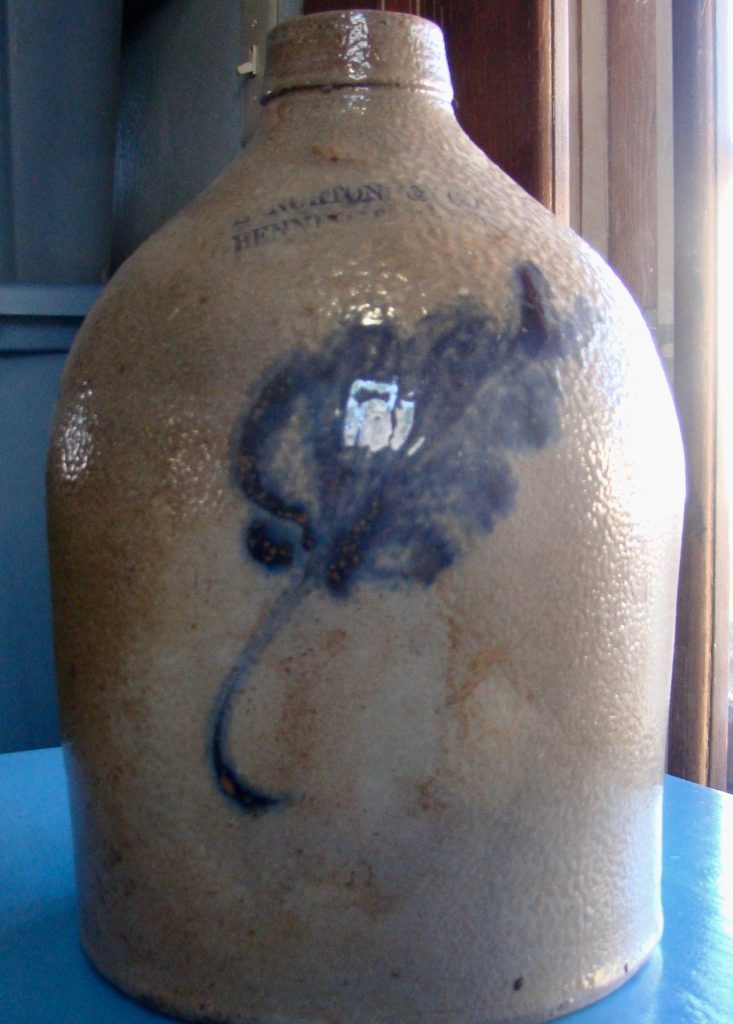
![]() Exquisite Norton salt glazed jug pulled from a dump in Danbury.
Exquisite Norton salt glazed jug pulled from a dump in Danbury.
The name Norton is well known to collectors of Vermont stoneware. Depending on the cobalt design, these jugs can be highly prized. The one pictured can sell for $100 to $400. Marks of American Potters notes that the Norton company started in Bennington, Vt in 1793 and “made stoneware and brown glazed pottery.” Dating jugs made by Norton is quite simple. E. & L. P. Norton took over the company in 1865 and jugs from that era are stamped “E. & L.P. Norton.” Jugs were stamped this way until 1882 when Edward Norton took over the firm. The stamps then read E. Norton & Co. The jug (above) carries this stamp. Most likely this Norton jug held whiskey or cider and was probably purchased in Danbury at a grocery store or saloon.
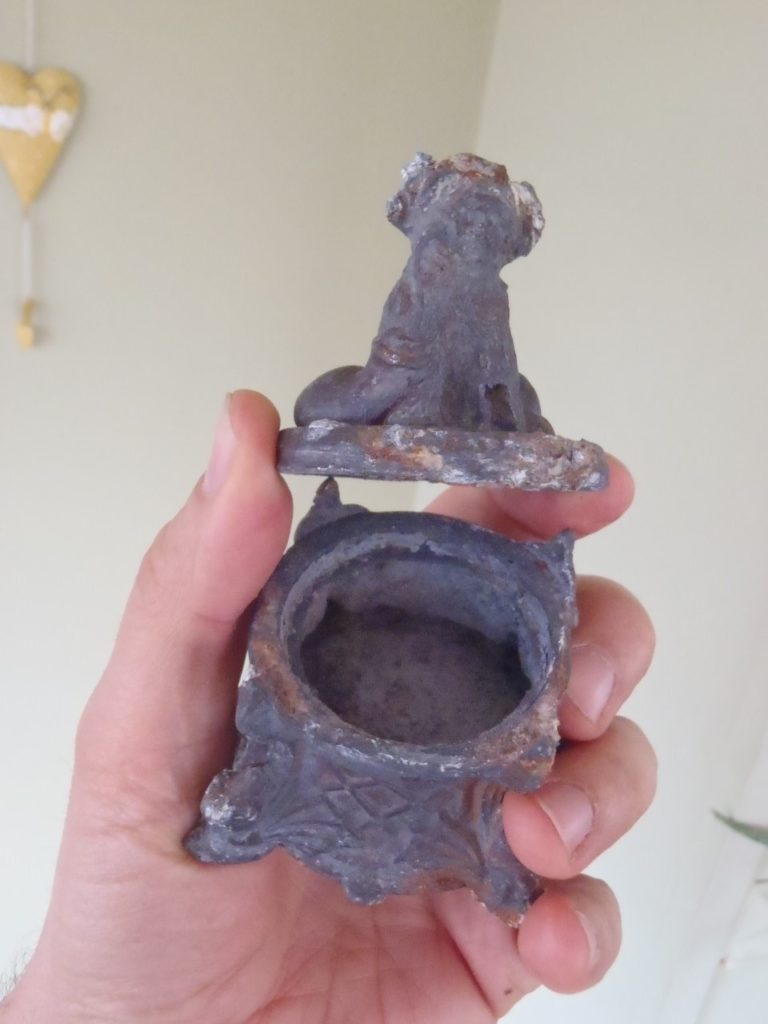
![]() FROM OUR “WHAT THE HELL DID THIS CONTAIN FILES…” MYSTERY DOG JAR.
FROM OUR “WHAT THE HELL DID THIS CONTAIN FILES…” MYSTERY DOG JAR.
Hat City Diggers find some strange stuff: glass breast pumps, enema rectal syringes, etc but this takes the cake. We found this strange artifact a few summers ago. The jar is made from pot metal (die-cast zinc) and is at least a hundred years old. It was obviously made to contain something we just don’t know what. (more below)
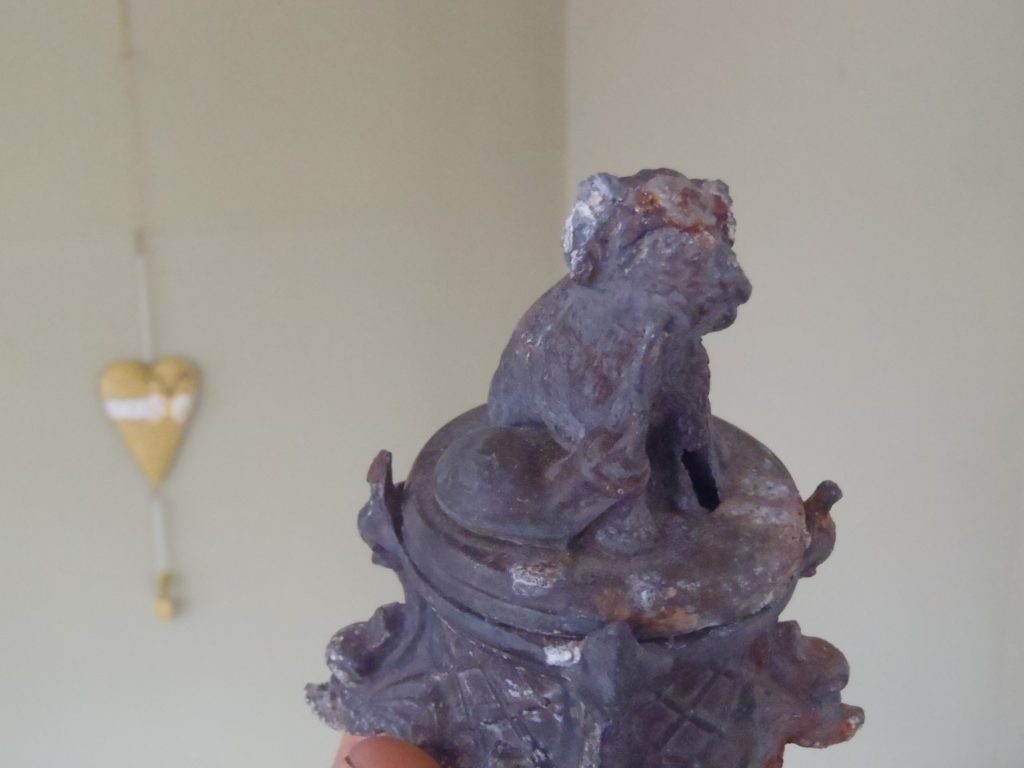
In this shot check out the dog seated on the lid he appears to be sucking on a nurser. Note the feet projecting from the base of the jar they appear to be dog’s heads. Did this peculiar container hold riches only meant for Rex? If anyone thinks they have an answer, feel free to contact us.

![]() Marcus Dairy castaway.
Marcus Dairy castaway.
The elements take their toll on a Marcus Dairy milk box at the Oil Mill Pond site. Boxes like this were a common site on door stoops around Danbury years ago. I remember one at our house on Lee Ave in the early 1970s.
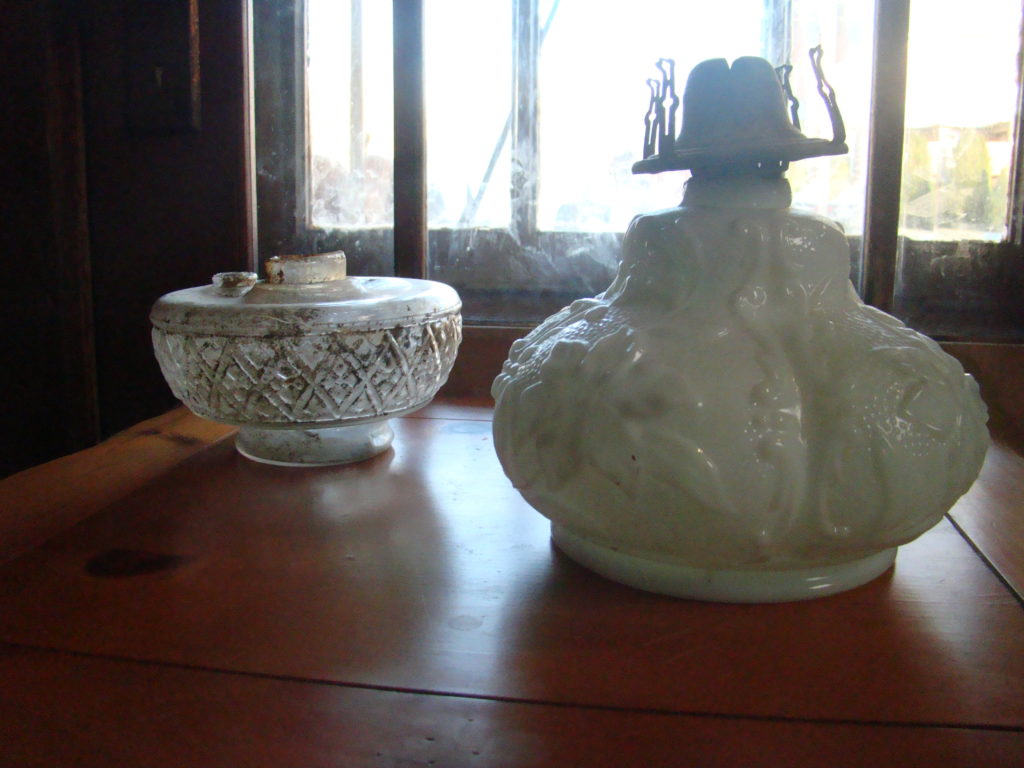
![]() Dangerous fuel.
Dangerous fuel.
Danbury in the 19th century was a tinder box and lamps like the ones pictured were responsible for many fires- and deaths. The problem was the highly flammable fuel used: kerosene, and if a lamp was carelessly place and tipped over everything would go up in flames. The Danbury Evening News reported on several case of people injured or killed by kerosene fires when their lamps “exploded”. Between 1888 and 1890 there were over a dozen fires set intentionally by an “incendiary”, as arsonists were called, using kerosene as an accelerant. The arsonist would eventually become known as the “Danbury FireBug.” We dug the lamps (above) from Danbury dumps a few years ago.
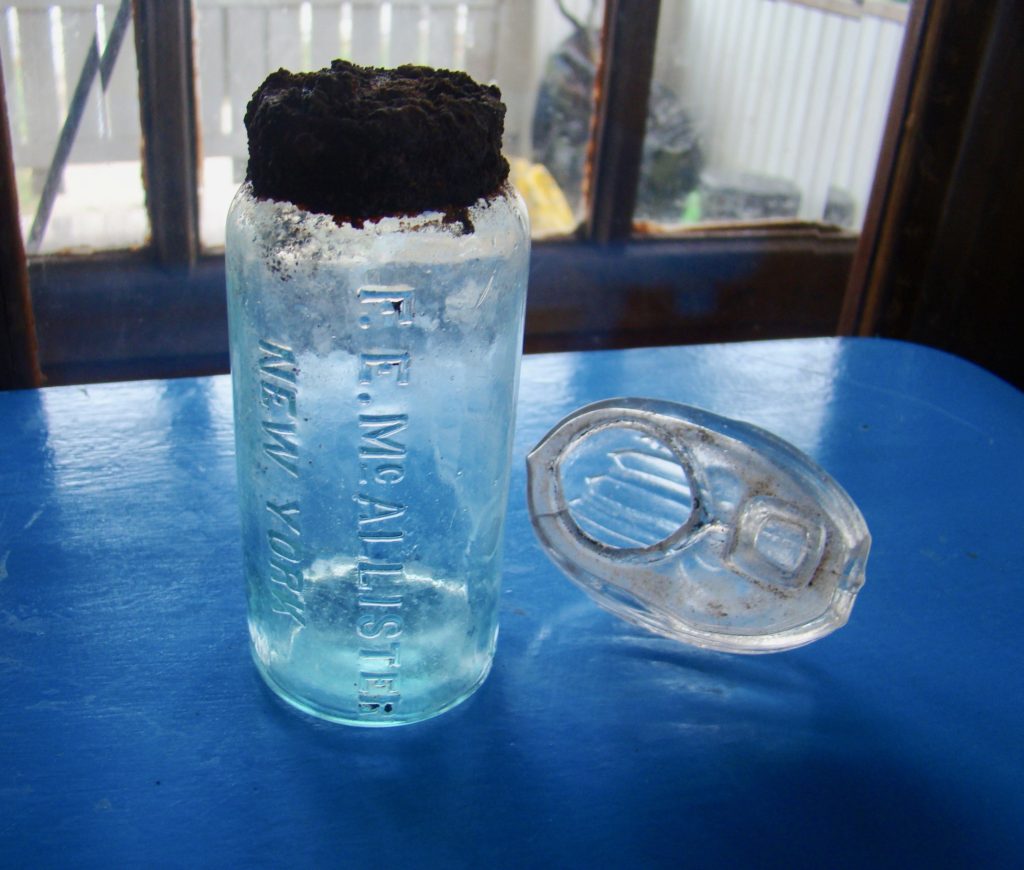
![]() For the birds.
For the birds.
Pictured: F. E. McAllister birdseed bottle with a handmade glass bird feeder. We dug the pair from a dump near Main St in Danbury, Ct. Both artifacts are ca 1900.
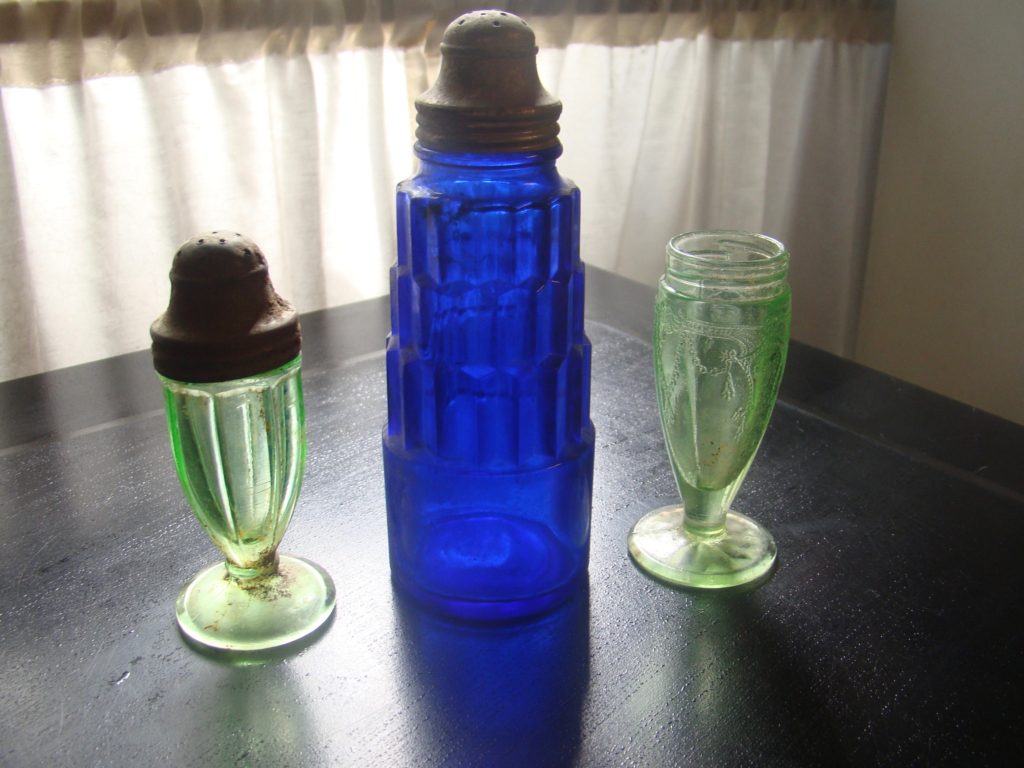
![]() Free glass from the past.
Free glass from the past.
Three Depression glass salt & pepper shakers discovered in Danbury. Depression glass was given away free by movie theaters during the Great Depression of the 1930s, hence, the name. Danburians probably picked up these items at the local theaters, such as the Capitol on Elm St or the Palace or Empress on Main St.
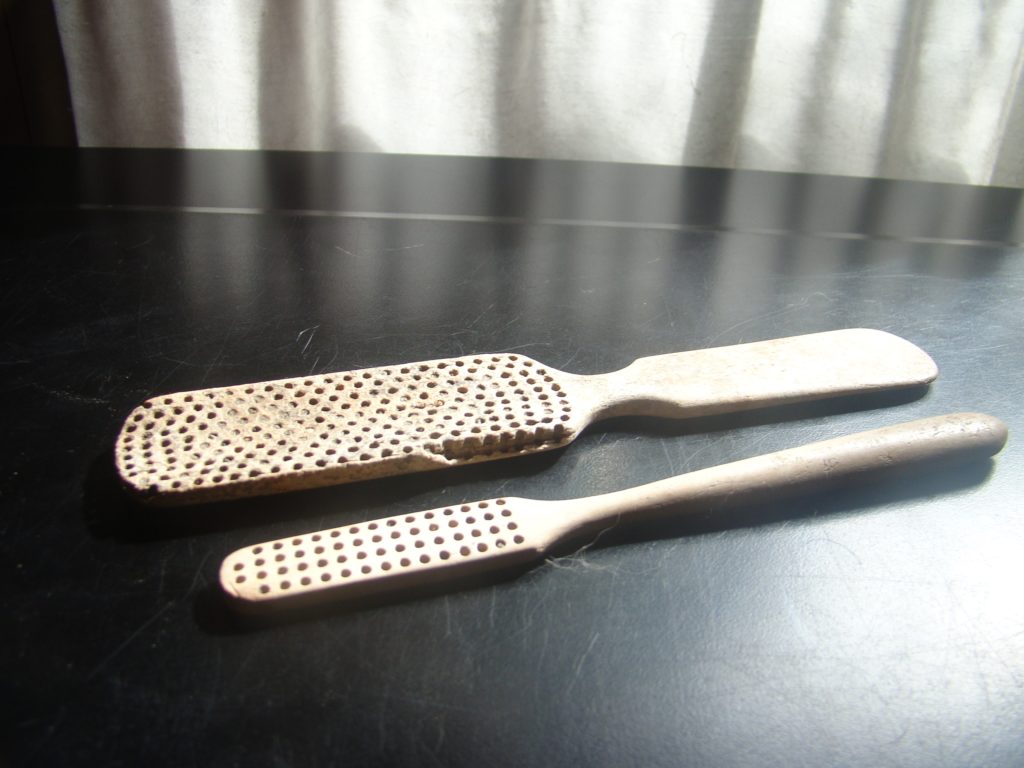
![]() For teeth and hair.
For teeth and hair.
Two 19th century bone brushes. The large one is a hairbrush. The other, a toothbrush. The bristles, made from hog’s hair, have long since decomposed. Both brushes are handmade and date to the 19th century. We dug the pair from a hobo dump in New Milford, Ct.
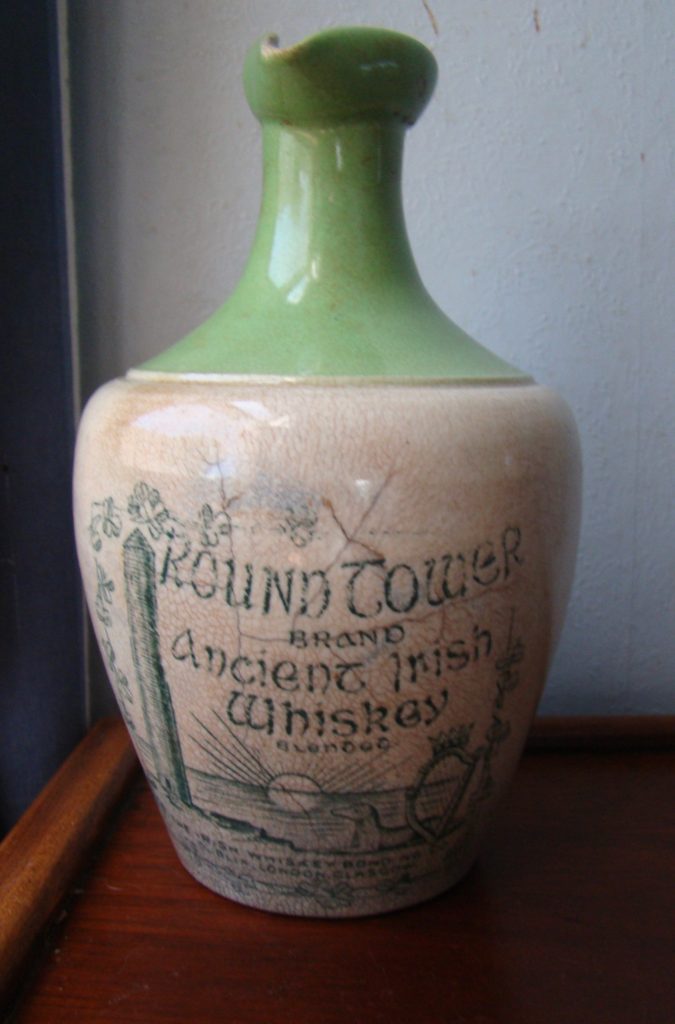
![]() Yet another beaver dam find Round Tower Brand Ancient Irish Whiskey.
Yet another beaver dam find Round Tower Brand Ancient Irish Whiskey.
I found this jug buried in the sand below the beaver dam. The age is unknown, however, there are several clues that may help us eventual determine an age range. For example, there is no capacity listed on the jug. About 1906 capacities were being added to bottles. Also, the statement “Federal law prohibits sale or reuse of this bottle” is not stamped or embossed on the jug, an indication it may have been produced before prohibition. Interestingly the jug is almost identical to the modern Tullamore Dew.
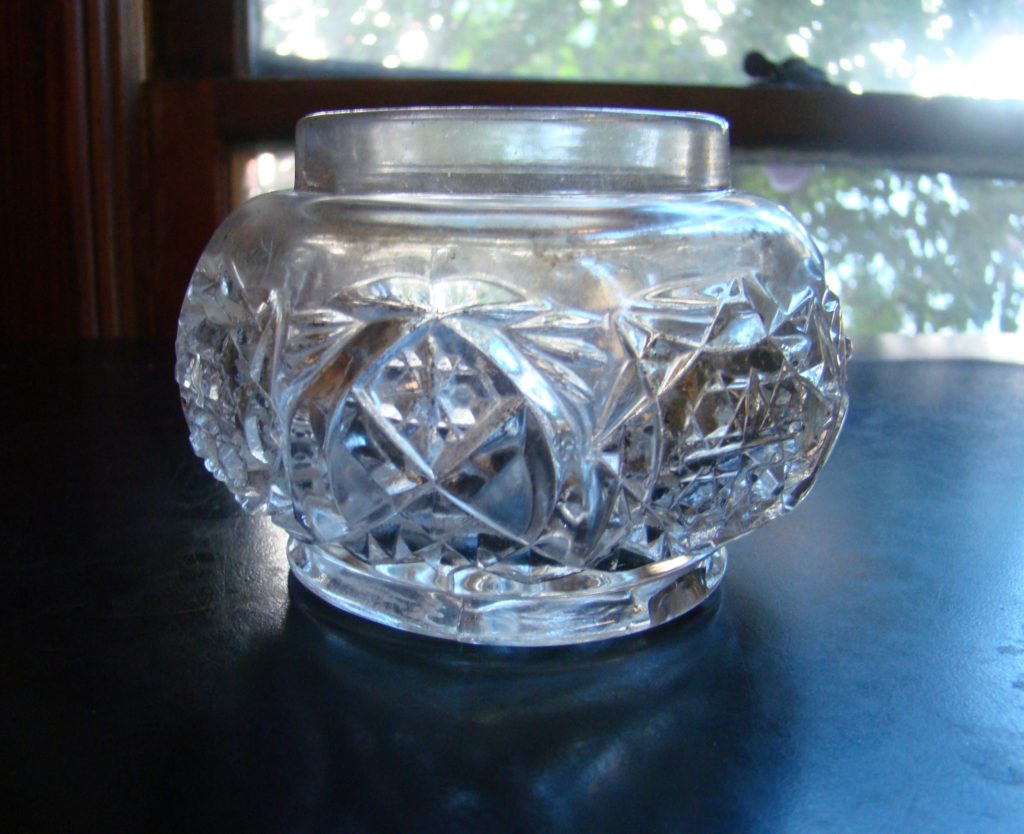
![]() From the beaver dam, again.
From the beaver dam, again.
Another beaver dam find! A striking cut glass powder jar. The missing lid may have been sterling silver or silver plated. Since the lip is not threaded, the jar may be over 100 years old.
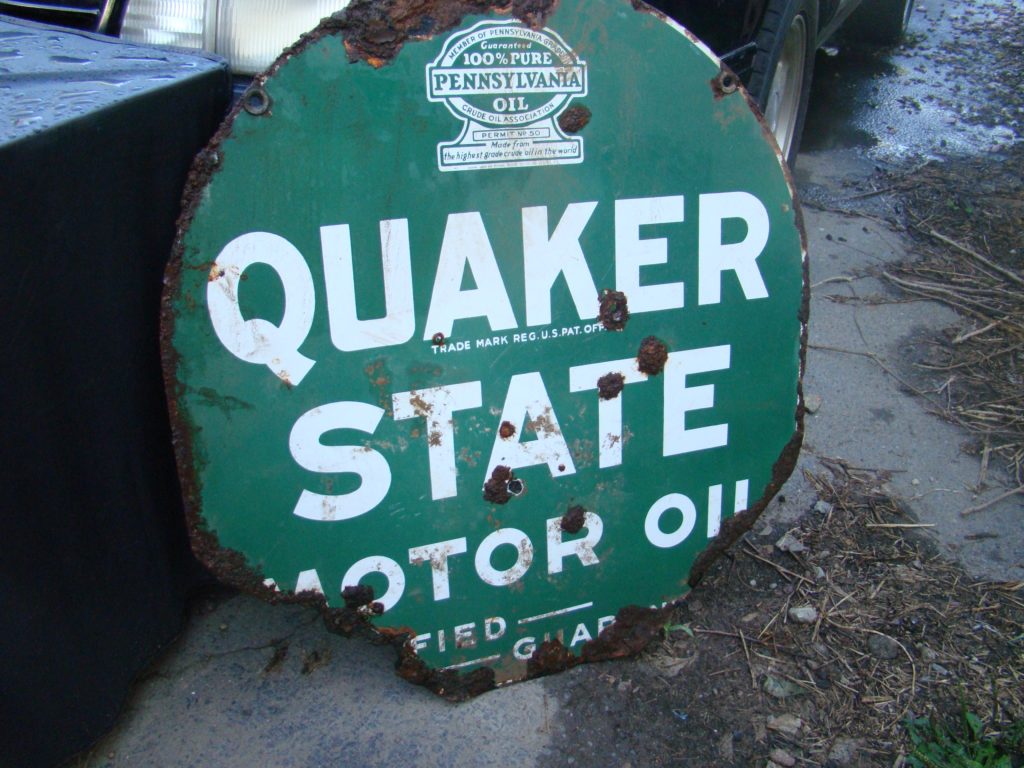
![]() Quaker State in New York State.
Quaker State in New York State.
We dug this 1930s double-sided Quaker State porcelain sign from a farm dump in New York State. Considering it was buried for 60 or 70 years, it’s in really good condition.
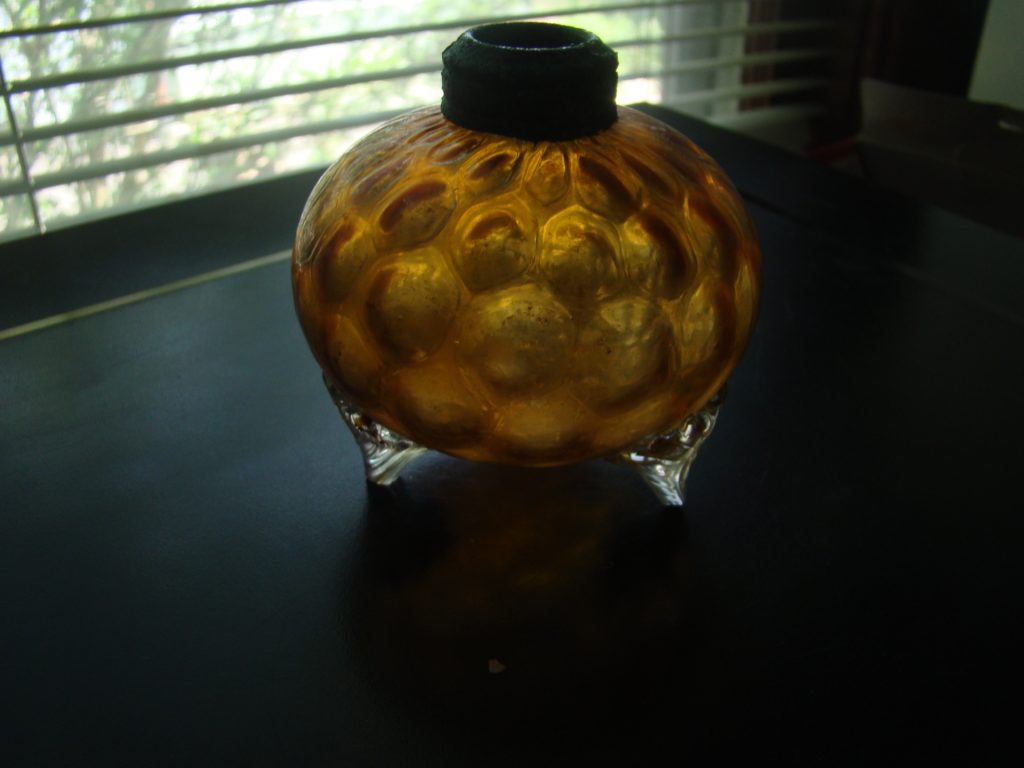
![]() An elegant orange oil lamp from the 19th century.
An elegant orange oil lamp from the 19th century.
Just like electric night lights for children today small oil lamps like this one were used to light a child’s room at night.

![]() Porcelain pachyderm.
Porcelain pachyderm.
A ceramic elephant bank ca 1910 discovered in New Milford in 2015.
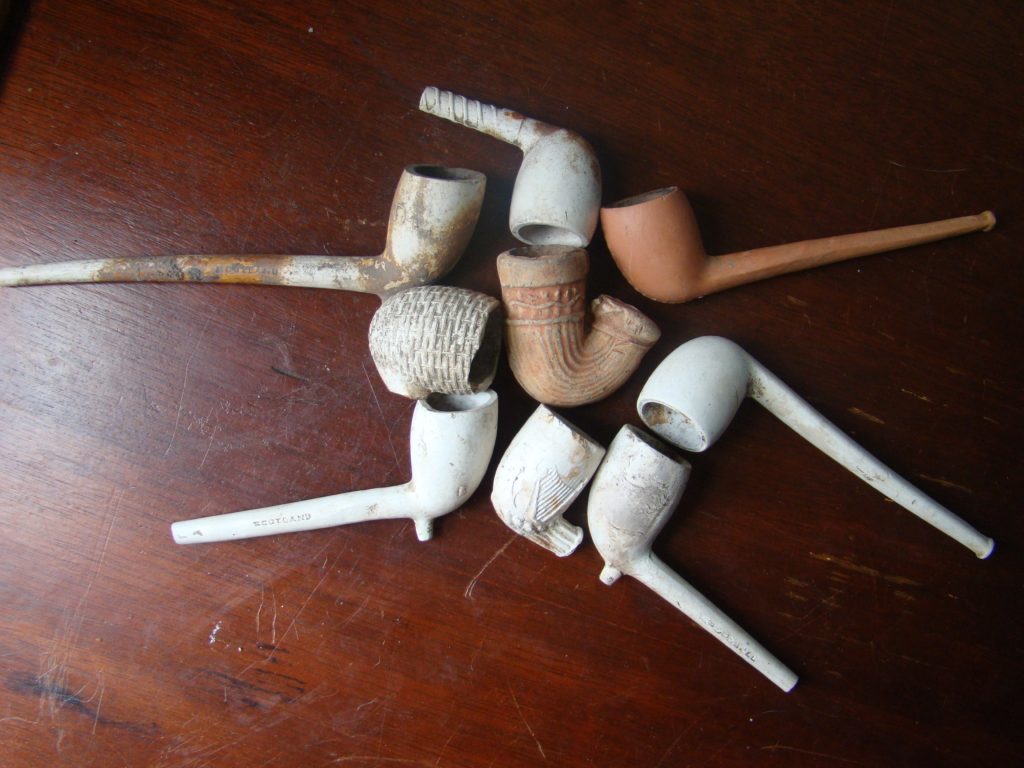
![]() Castaway clay… pipes.
Castaway clay… pipes.
A few pipes we’ve dug over the years. Danbury, like most towns across America, had its share of tobacco stores like the one below (most were located on Main St and White St during the 1890s.)
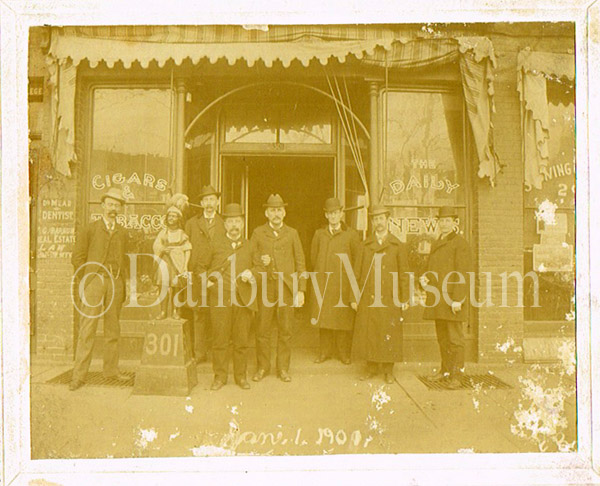
Like cigar stores in the first quarter of the 20th century, Danbury’s had to have cigar store Indians, like the one on the granite pedestal at left. A typical statue or trade figure, as they are called, can fetch a premium at auction today.
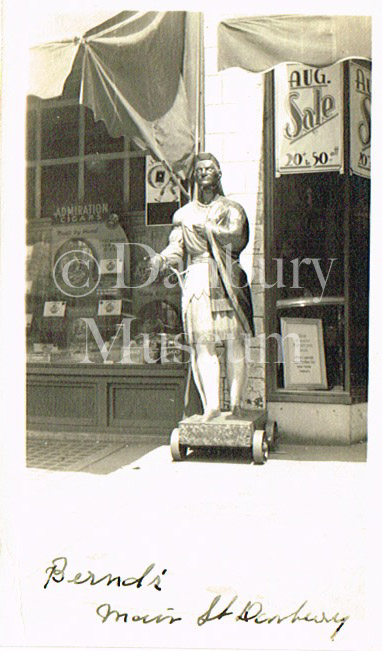
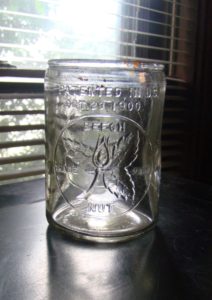
![]() (Left) A cigar store Indian as they were called stoically waits outside the door for customers to enter from Main St in this 1920s image. (Right) Beech-Nut tobacco jar with patent date Oct 23, 1900. As today, smoking started at an early age in the past. In fact, according to a report in the 1913 Danbury News smoking by young boys in Danbury was “on the increase.” A hundred years ago. Like now, there were laws to keep children from smoking For example, in 1913 it was illegal to “sell, give or deliver to any minor under sixteen years of age, tobacco in any form.” The “evil” of smoking at tender ages was blamed squarely on parental neglect. “…it is not uncommon to find boys… not more than eight or ten years of age on the streets [to] ten or eleven o’clock [PM].” stated a contemporary Danbury News story.
(Left) A cigar store Indian as they were called stoically waits outside the door for customers to enter from Main St in this 1920s image. (Right) Beech-Nut tobacco jar with patent date Oct 23, 1900. As today, smoking started at an early age in the past. In fact, according to a report in the 1913 Danbury News smoking by young boys in Danbury was “on the increase.” A hundred years ago. Like now, there were laws to keep children from smoking For example, in 1913 it was illegal to “sell, give or deliver to any minor under sixteen years of age, tobacco in any form.” The “evil” of smoking at tender ages was blamed squarely on parental neglect. “…it is not uncommon to find boys… not more than eight or ten years of age on the streets [to] ten or eleven o’clock [PM].” stated a contemporary Danbury News story.

![]() Three-minute egg.
Three-minute egg.
A mid to late 19th-century porcelain egg cup (egg added for effect) is pictured. We find 100 plus-year-old eggshells in a few dumps but this is the first egg cup we’ve ever recovered.
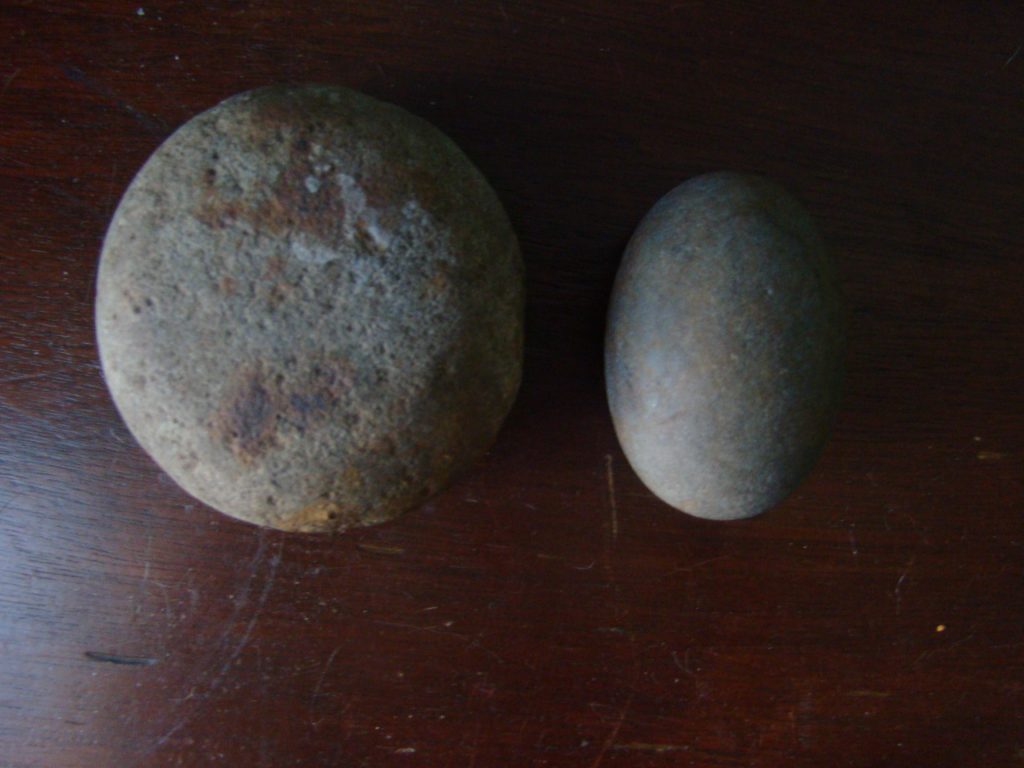
![]() Two Native American grinding stones, age unknown are pictured. The stone on the left is from New Milford and might be Paugussett. To the right is an egg-shaped grinding stone dug from a bank along the Still River. It was discovered in Danbury and may be Pahquioque.
Two Native American grinding stones, age unknown are pictured. The stone on the left is from New Milford and might be Paugussett. To the right is an egg-shaped grinding stone dug from a bank along the Still River. It was discovered in Danbury and may be Pahquioque.

![]() Pictured, A 1914 Connecticut porcelain license plate discovered in a large ash dump in New Milford. We pulled two from the dump we are digging. The second one was far too deteriorated , but even with the rust, this one’s still readable. Remarkably a check of the Connecticut Motor Vehicle Register from 1916 indicates the owner as M. H. Mallett of South Main St, New Milford! Another remarkable discovery was a large copper Pullman car bathtub (with brass fixtures and cast iron feet) from the same site. It was so badly crushed that we sold it for scrap.
Pictured, A 1914 Connecticut porcelain license plate discovered in a large ash dump in New Milford. We pulled two from the dump we are digging. The second one was far too deteriorated , but even with the rust, this one’s still readable. Remarkably a check of the Connecticut Motor Vehicle Register from 1916 indicates the owner as M. H. Mallett of South Main St, New Milford! Another remarkable discovery was a large copper Pullman car bathtub (with brass fixtures and cast iron feet) from the same site. It was so badly crushed that we sold it for scrap.
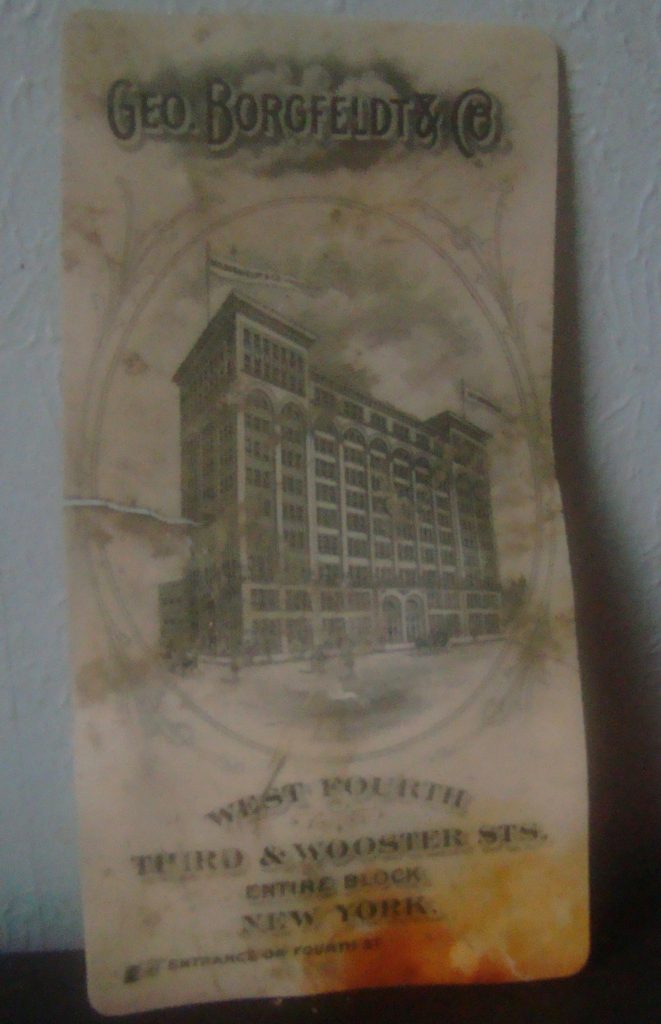
![]() Geo. Borgfeldt & Co. advertising card.
Geo. Borgfeldt & Co. advertising card.
Cards like this were made from celluloid an early plastic. Later on, celluloid became famous as the material used by the movie industry to make motion picture film.

Note the 1904 calendar on the reverse of the card. This clue is a great way to approximate the age of other objects found in the dump.
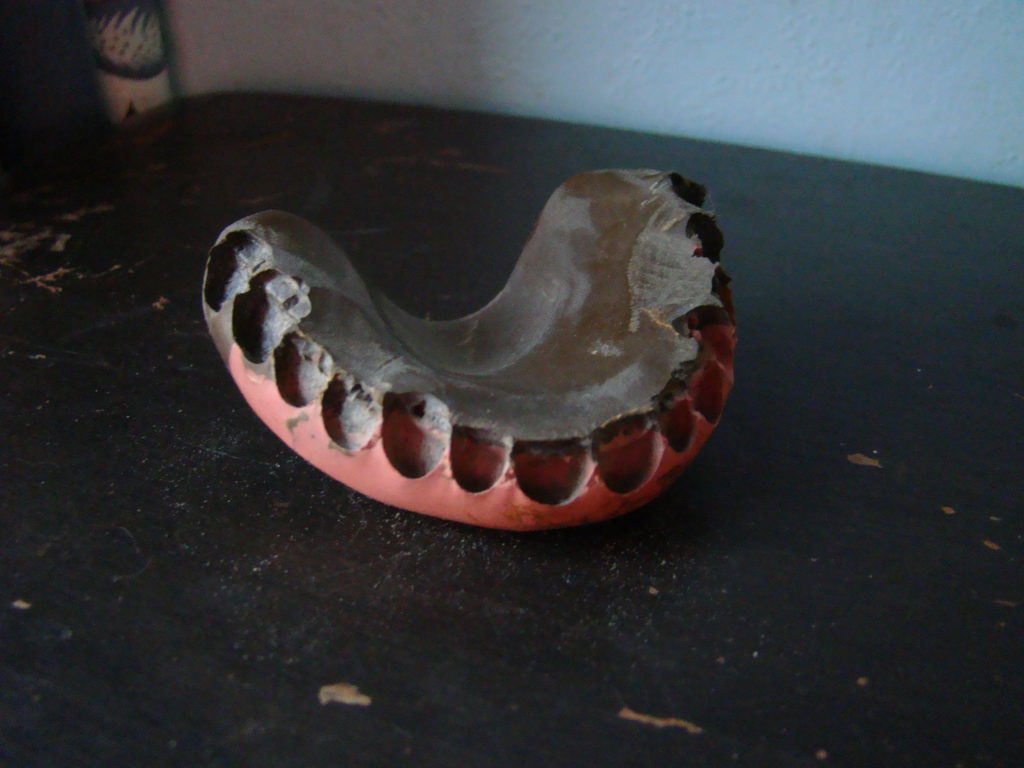
![]() Vulcanite dentures minus the porcelain teeth, which were lost or broken. These dentures were owned by a Danburian, man or woman, and date from between 1865 to about 1905.
Vulcanite dentures minus the porcelain teeth, which were lost or broken. These dentures were owned by a Danburian, man or woman, and date from between 1865 to about 1905.

A 1902 Danbury News add for the Wyith Dental Company. 253 Main St. Note that a full set of dentures was $5- still a lot of money for 1902 considering the average pay was just over $400 a year.
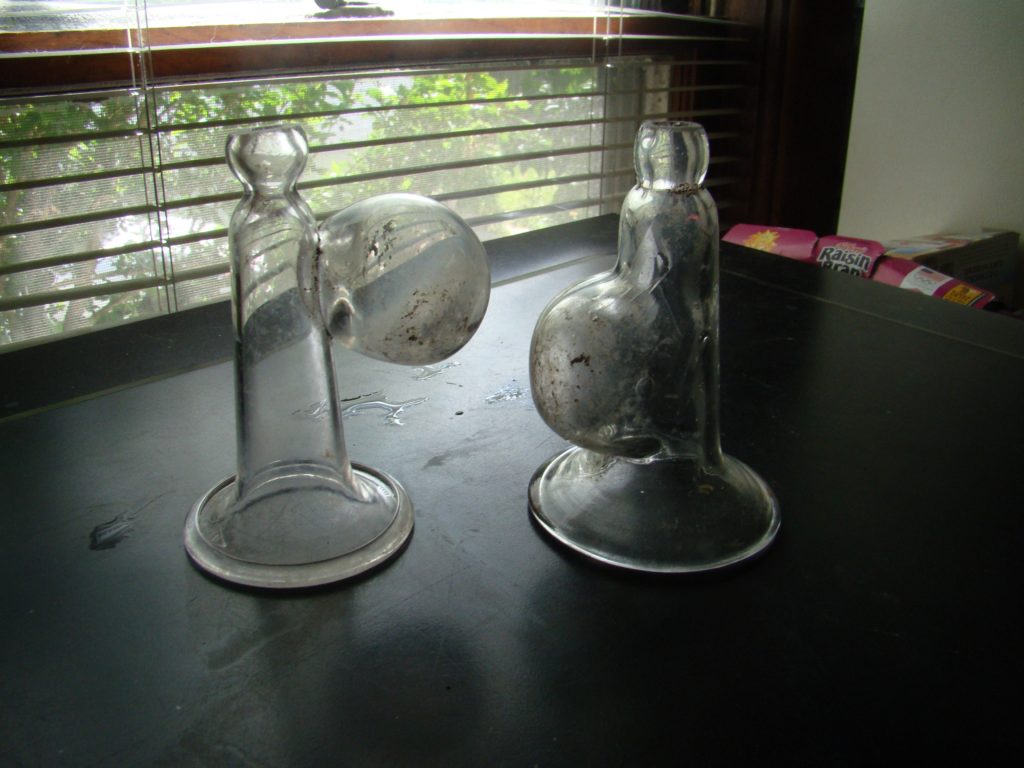
![]() Any woman who is nursing knows how essential a beast pump is and turn of the century women were just as aware. Women could buy pumps like the two pictured at any drug store. They sold for about 50¢. The one (right) resembles a Yale pump. Yale introduced their pumps to consumers in the early 1900s The suction devices, which were rubber or metal, have long since disintegrated.
Any woman who is nursing knows how essential a beast pump is and turn of the century women were just as aware. Women could buy pumps like the two pictured at any drug store. They sold for about 50¢. The one (right) resembles a Yale pump. Yale introduced their pumps to consumers in the early 1900s The suction devices, which were rubber or metal, have long since disintegrated.

![]() Elegant lighting.
Elegant lighting.
This beautiful oil lamp ca. 1870s or 80s is the third we’ve found to date. Small lights like this were used in children’s rooms possible to ease away a child’s night terrors.
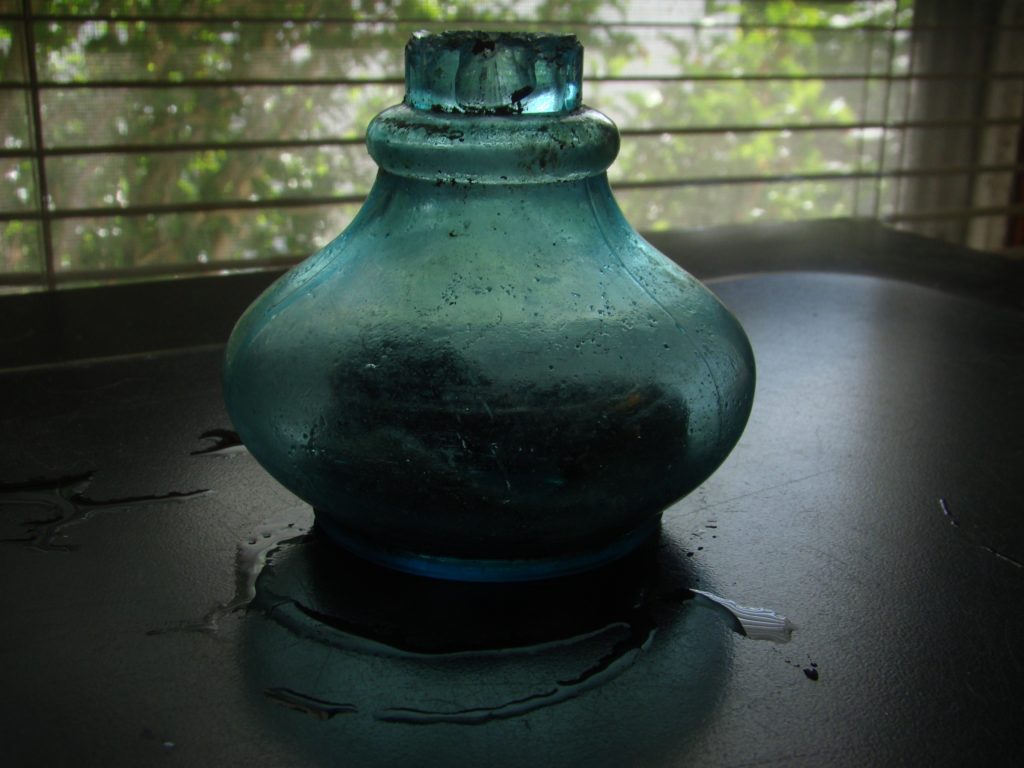
![]() A simple blue oil lamp dug over the summer. It dates to the mid to late 1800s. Note the wick is still inside the lamp. Tinny lamps like this were likely used in children’s rooms.
A simple blue oil lamp dug over the summer. It dates to the mid to late 1800s. Note the wick is still inside the lamp. Tinny lamps like this were likely used in children’s rooms.
